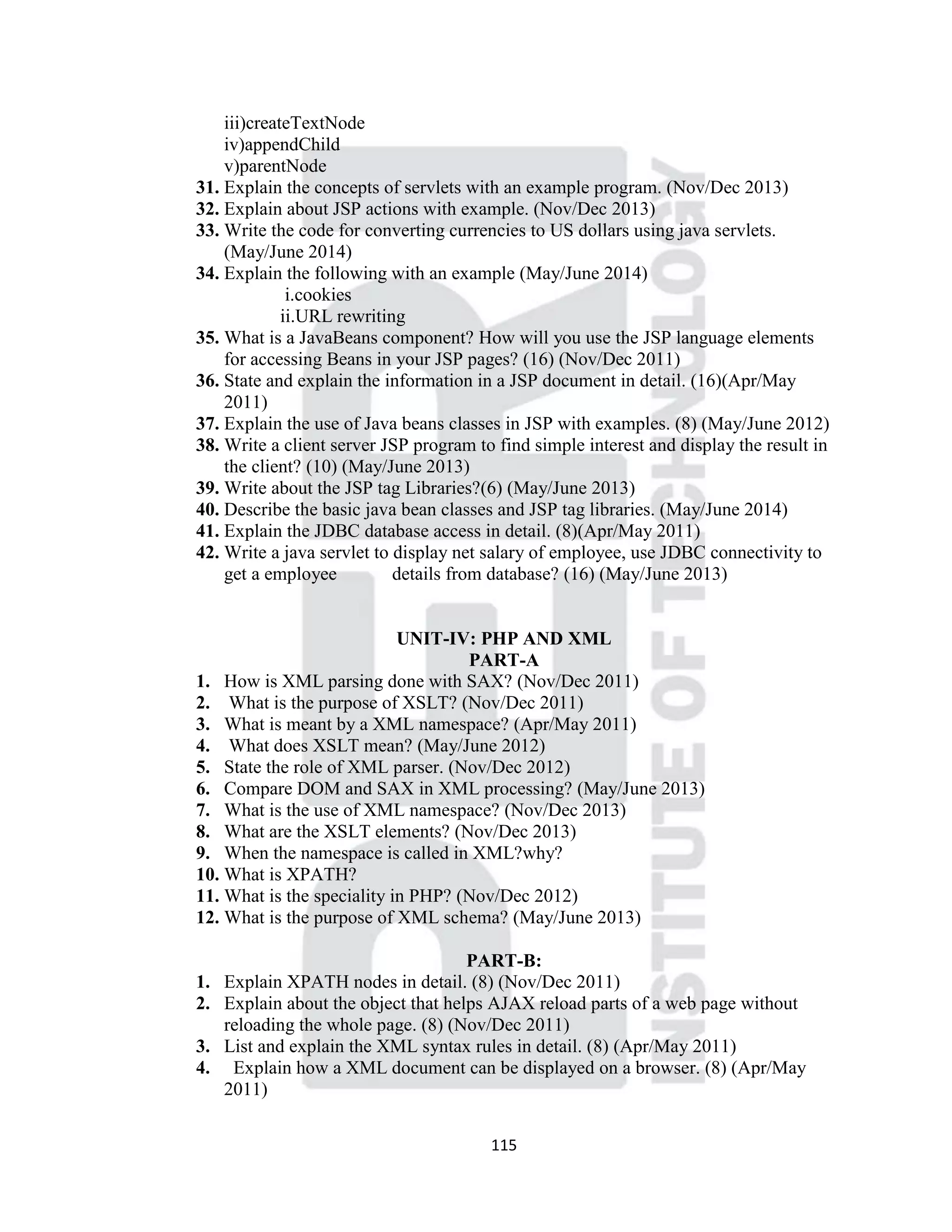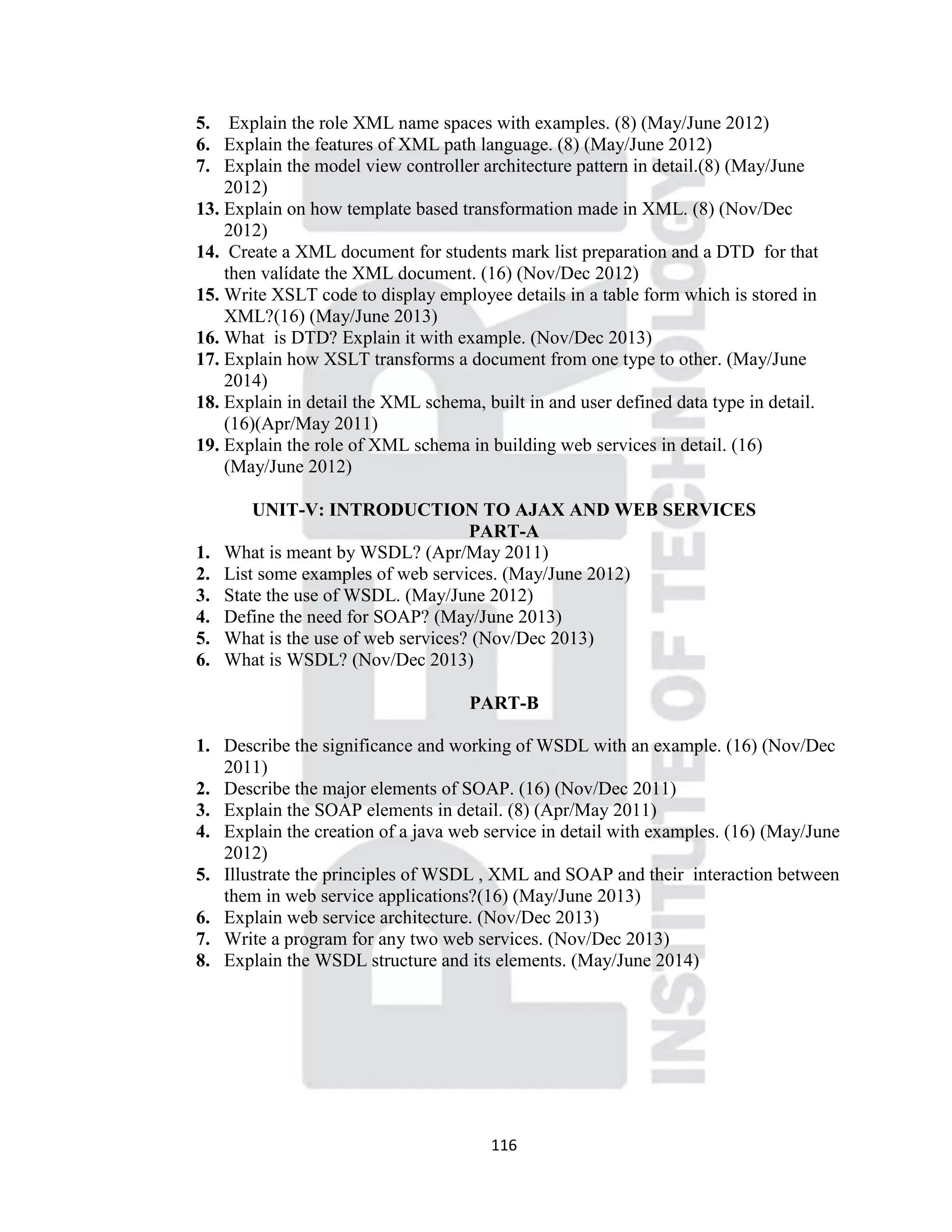This document contains the syllabus, objectives, outcomes and questions for the subject CS6501 - Internet Programming. It covers 5 units: Java Programming, Websites Basics, Client Side and Server Side Programming, PHP and XML, and Introduction to AJAX and Web Services. The objectives are to learn Java programming, understand internet technologies, and be exposed to web services architecture. The document provides learning outcomes, textbook references and questions covering concepts in each unit for both objective and subjective questions.

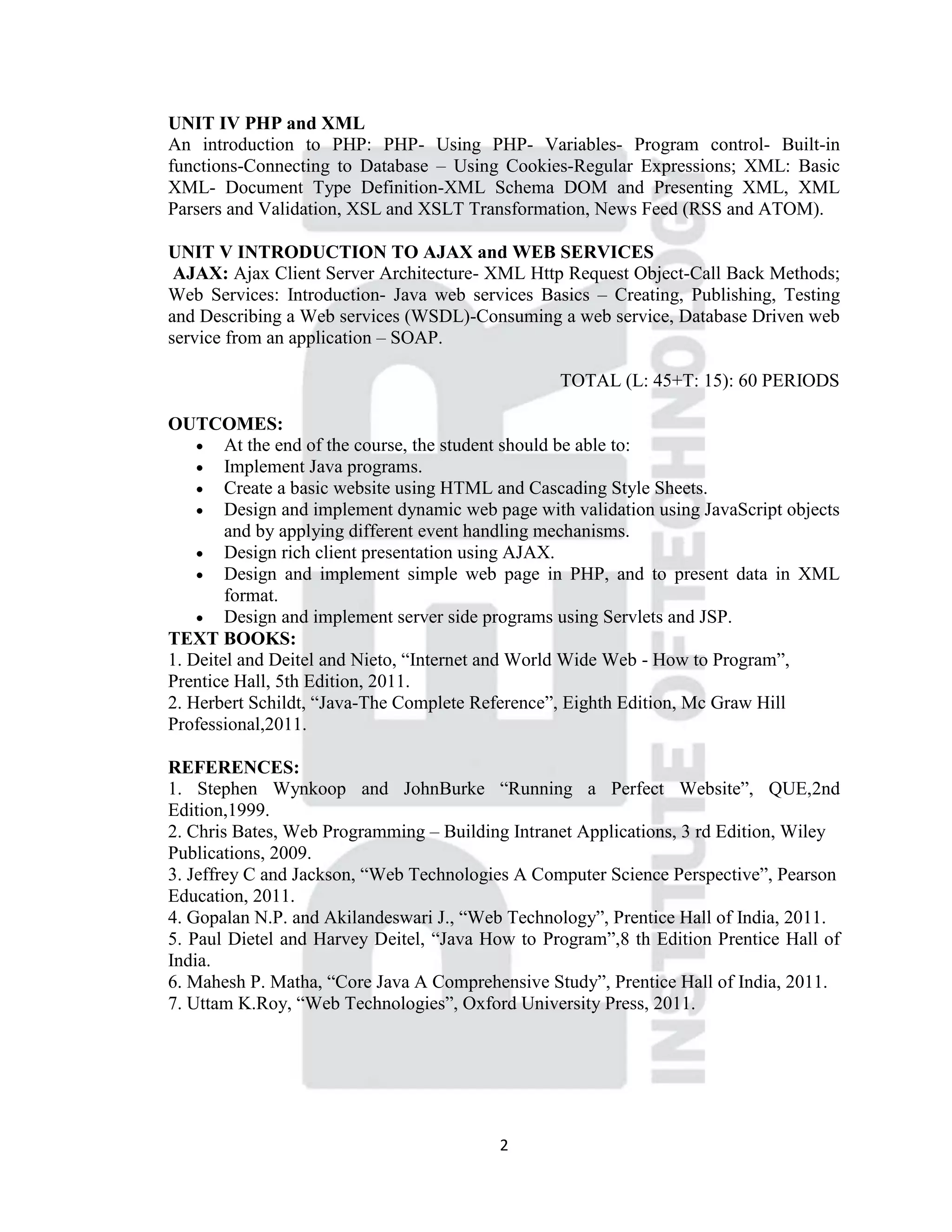
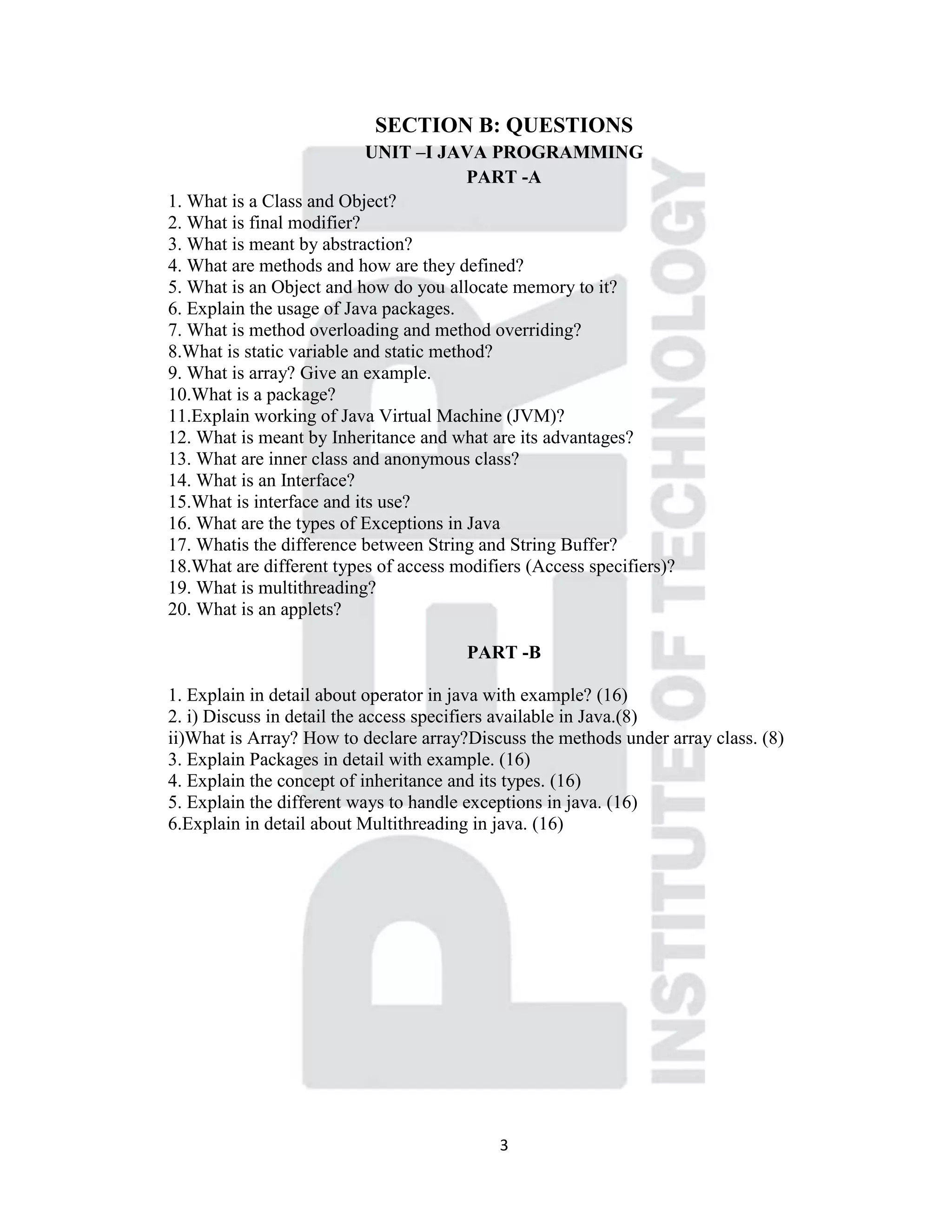

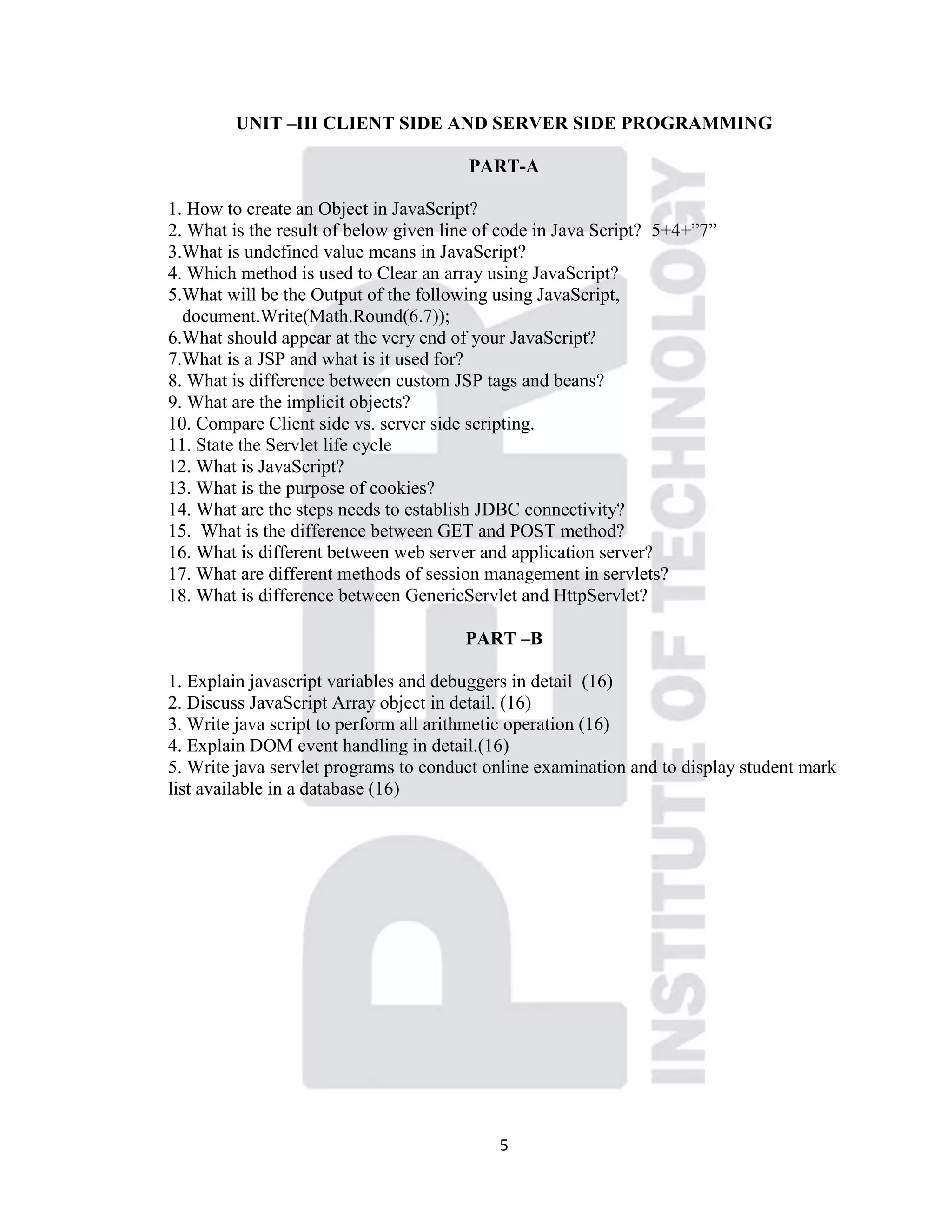
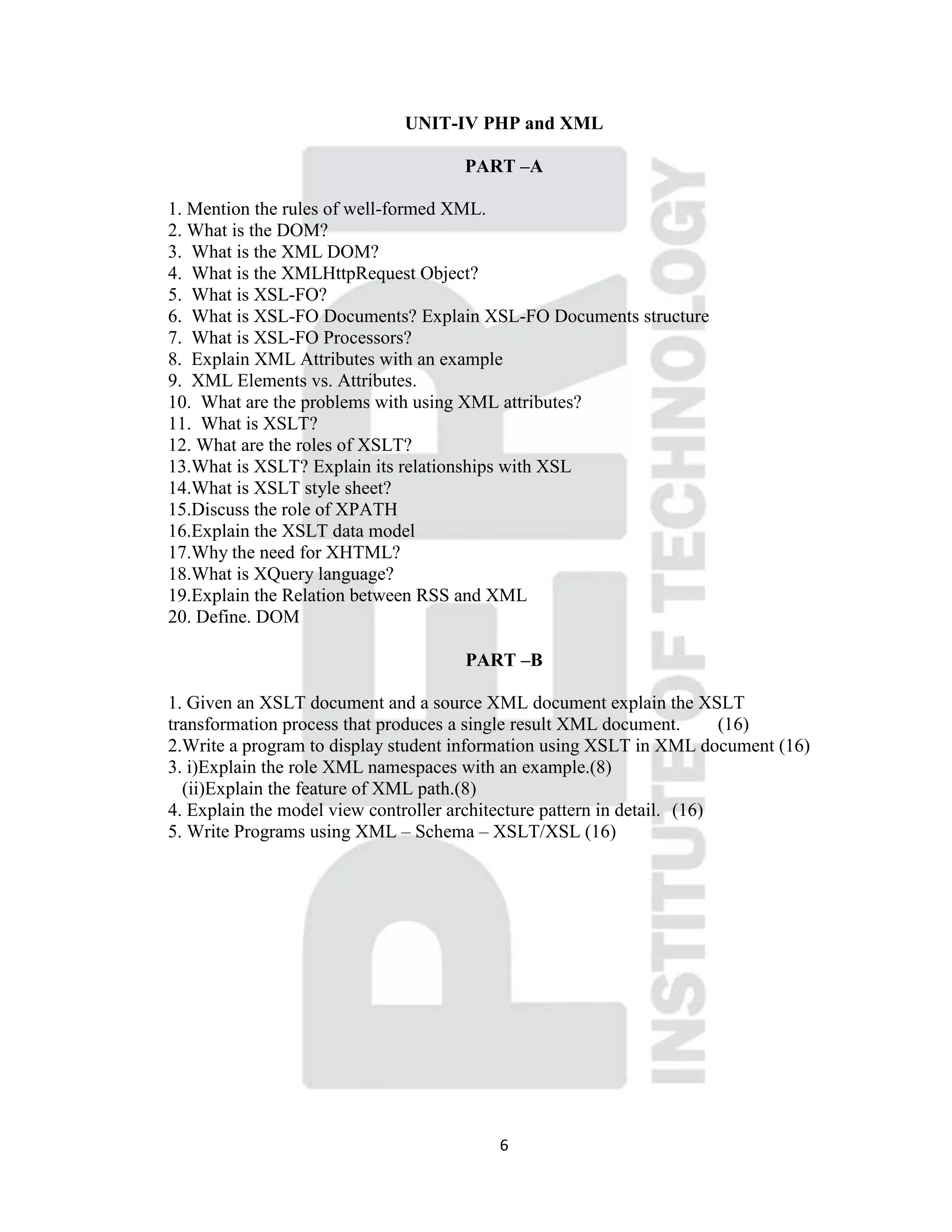

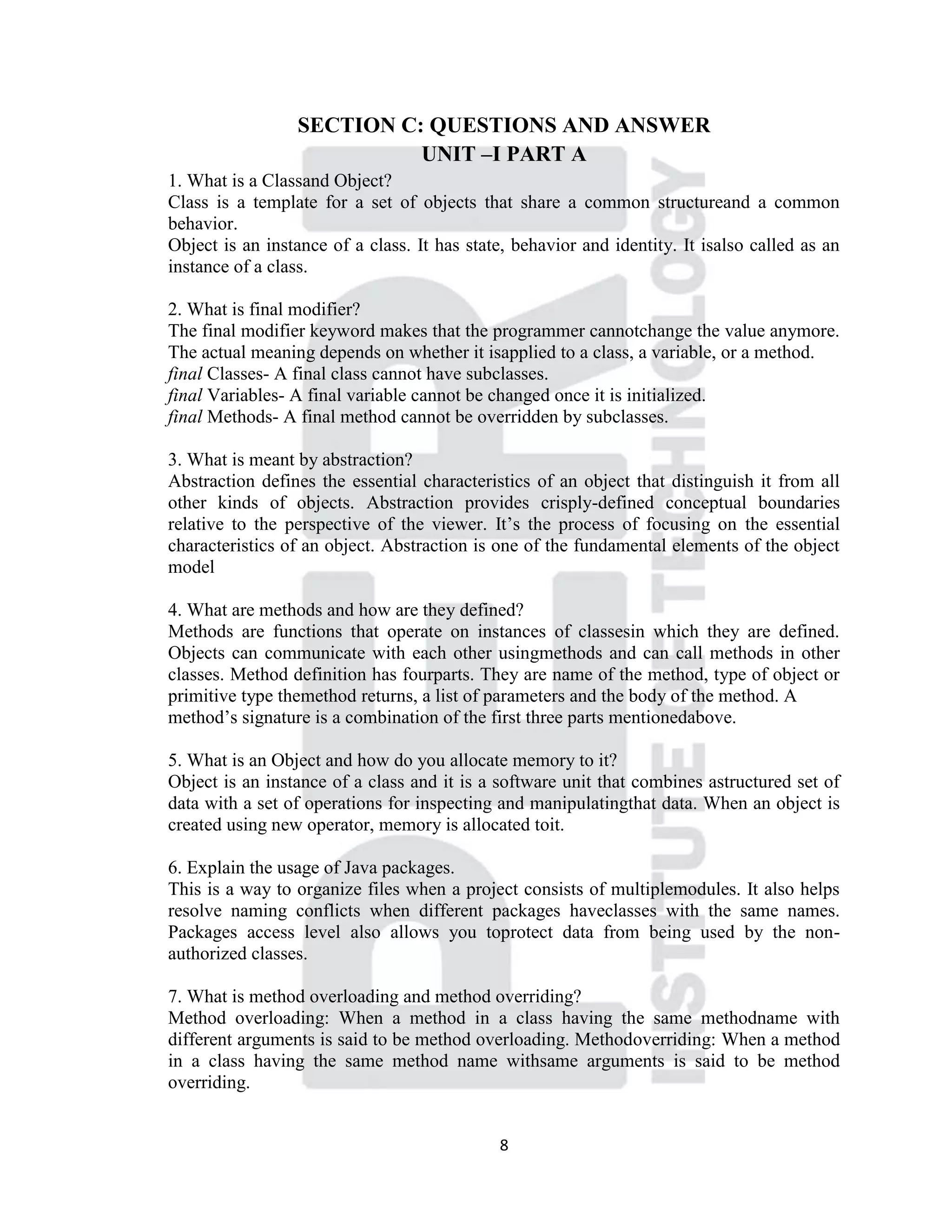
![9 8.What is static variable and static method? Static variable is a class variable which value remains constant for theentire class. Static method is the one which can be called with the class itself and can holdonly the static variables. 9. What is array? Give an example. An array is a group of like-typed variables that are referred to by a common name. Arrays ofany type can be created and may have one or more dimensions. A specific element in an arrayis accessed by its index. Arrays offer a convenient means of grouping related information. Syntax: array-var = new type[size];example:month_days = new int[12]; 10.What is a package? A package is a collection of classes and interfaces that provides ahigh-level layer of access protection and name space management. 11.Explain working of Java Virtual Machine (JVM)? JVM is an abstract computing machine like any other real computingmachine which first converts .java file into .class file by using Compiler (.class isnothing but byte code file.) and Interpreter reads byte codes 12. What is meant by Inheritance and what are its advantages? Inheritance is the process of inheriting all the features from a class.The advantages of inheritance are reusability of code and accessibility ofvariables and methods of the super class by subclasses. 13. What are inner class and anonymous class? Inner class: classes defined in other classes, includingthose defined in methods are called inner classes. An inner class canhave any accessibility including private. Anonymous class: Anonymousclass is a class defined inside a method without a name and is instantiated and declared in the same place and cannot have explicit constructors 14. What is an Interface? Interface is an outside view of a class or object which emphasizes itsabstraction while hiding its structure and secrets of its behavior. 15.What is interface and its use? Interface is similar to a class which may contain method‘ssignature only but not bodies and it is a formal set of method and constantdeclarations that must be defined by the class that implements it.Interfaces are useful for: a) Declaring methods that one or moreclasses are expected to implement b) Capturing similarities betweenunrelated classes without forcing a class relationship. c) Determining anobject‘s programming interface without revealing the actual body of the class](https://image.slidesharecdn.com/internetprogramming-cs6501-iiiyearcseanswerkey-161020051409/75/CS6501-Internet-programming-9-2048.jpg)
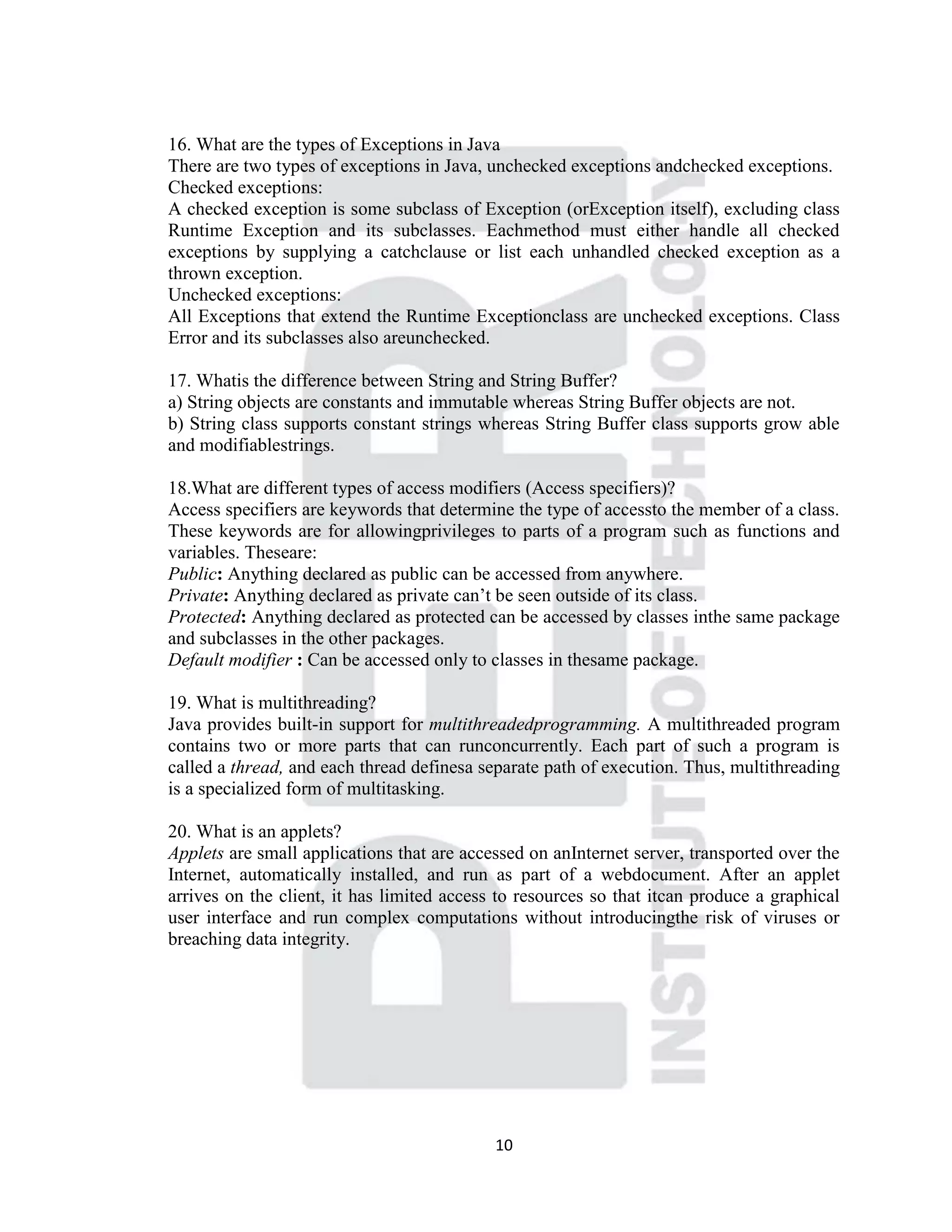
![11 SECTION C: QUESTIONS & ANSWERS UNIT –I JAVA PROGRAMMING 1. Explain in detail about operator in java with example? (16) Java provides a rich operator environment. Most of its operators can be divided into the following four groups: arithmetic, bitwise, relational, and logical. Java also defines some additional operators that handle certain special situations. Arithmetic Operators Arithmetic operators are used in mathematical expressions in the same way that they are used in algebra. The following table lists the arithmetic operators: Operator | Result: + Addition – Subtraction (also unary minus) * Multiplication / Division % Modulus ++ Increment += Addition assignment –= Subtraction assignment *= Multiplication assignment /= Division assignment %= Modulus assignment – – Decrement The operands of the arithmetic operators must be of a numeric type. You cannot use them on boolean types, but you can use them on char types, since the char type in Java is,essentially, a subset of int. class BasicMath { public static void main(String args[]) { // arithmetic using integers System.out.println("Integer Arithmetic"); int a = 1 + 1; int b = a * 3; int c = b / 4; int d = c - a; System.out.println("a = " + a); System.out.println("b = " + b); System.out.println("c = " + c); System.out.println("d = " + d); System.out.println("e = " + e);](https://image.slidesharecdn.com/internetprogramming-cs6501-iiiyearcseanswerkey-161020051409/75/CS6501-Internet-programming-11-2048.jpg)
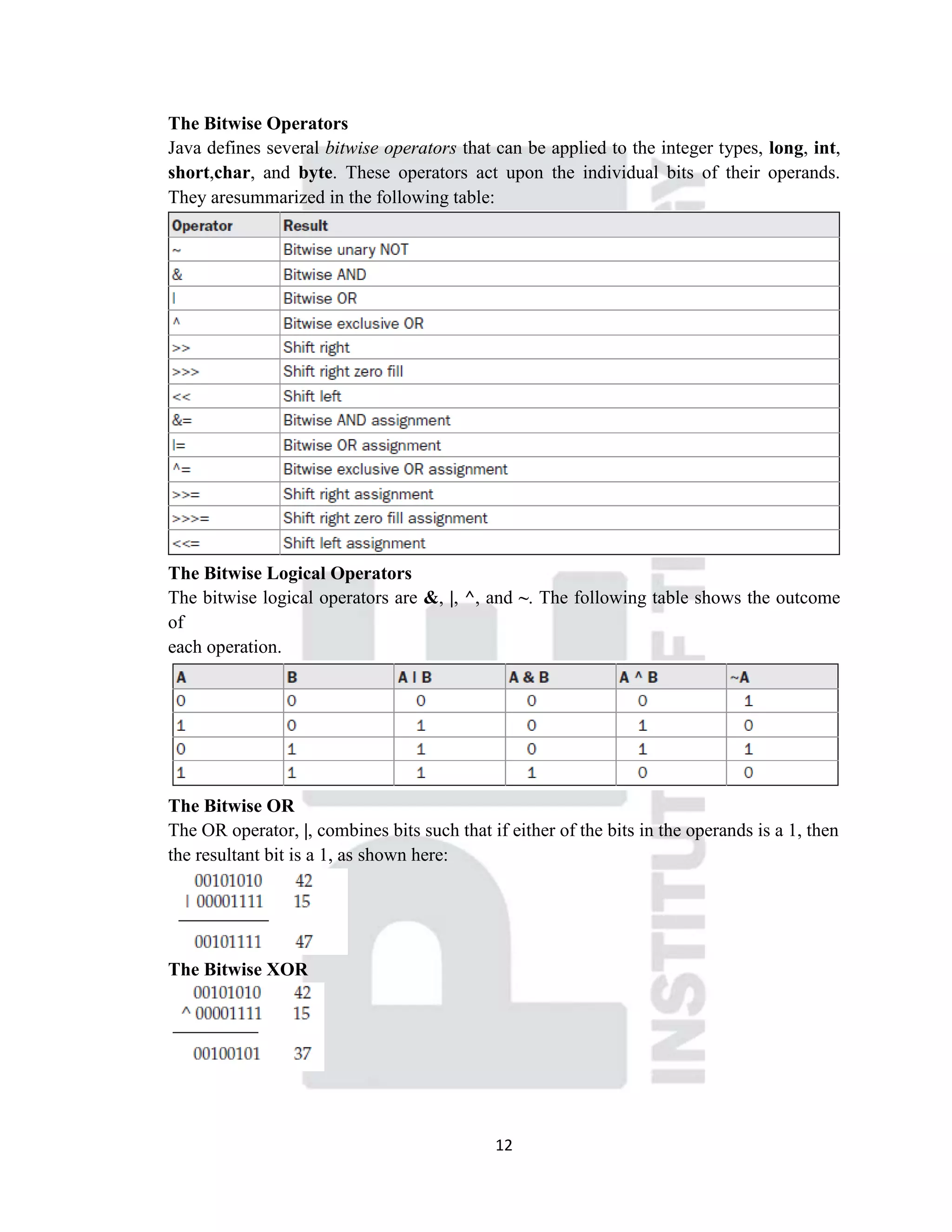
![13 // Demonstrate the bitwise logical operators. class BitLogic { public static void main(String args[]) { String binary[] = { "0000", "0001", "0010", "0011", "0100", "0101", "0110", "0111", "1000", "1001", "1010", "1011", "1100", "1101", "1110", "1111" }; int a = 3; // 0 + 2 + 1 or 0011 in binary int b = 6; // 4 + 2 + 0 or 0110 in binary int c = a | b; int d = a & b; int e = a ^ b; int f = (~a & b) | (a & ~b); int g = ~a & 0x0f; System.out.println(" a = " + binary[a]); System.out.println(" b = " + binary[b]); System.out.println(" a|b = " + binary[c]); System.out.println(" a&b = " + binary[d]); System.out.println(" a^b = " + binary[e]); System.out.println("~a&b|a&~b = " + binary[f]); System.out.println(" ~a = " + binary[g]); } } output from this program: a = 0011 b = 0110 a|b = 0111 a&b = 0010 a^b = 0101 ~a&b|a&~b = 0101 ~a = 1100 Relational Operators The relational operators determine the relationship that one operand has to the other. Specifically, they determine equality and ordering. The relational operators are shown here:](https://image.slidesharecdn.com/internetprogramming-cs6501-iiiyearcseanswerkey-161020051409/75/CS6501-Internet-programming-13-2048.jpg)
![14 Example: int a = 4; int b = 1; boolean c = a < b; Boolean Logical Operators The Boolean logical operators shown here operate only on boolean operands. All of the binary logical operators combine two boolean values to form a resultant boolean value. The logical Boolean operators, &, |, and ^, operate on boolean values in the same way that they operate on the bits of an integer. The logical ! operator inverts the Boolean state: !true == false and !false == true. The following table shows the effect of each logical operation: // Demonstrate the boolean logical operators. class BoolLogic { public static void main(String args[]) { boolean a = true; boolean b = false; boolean c = a | b; boolean d = a & b; boolean e = a ^ b; boolean f = (!a & b) | (a & !b); boolean g = !a; System.out.println(" a = " + a);](https://image.slidesharecdn.com/internetprogramming-cs6501-iiiyearcseanswerkey-161020051409/75/CS6501-Internet-programming-14-2048.jpg)

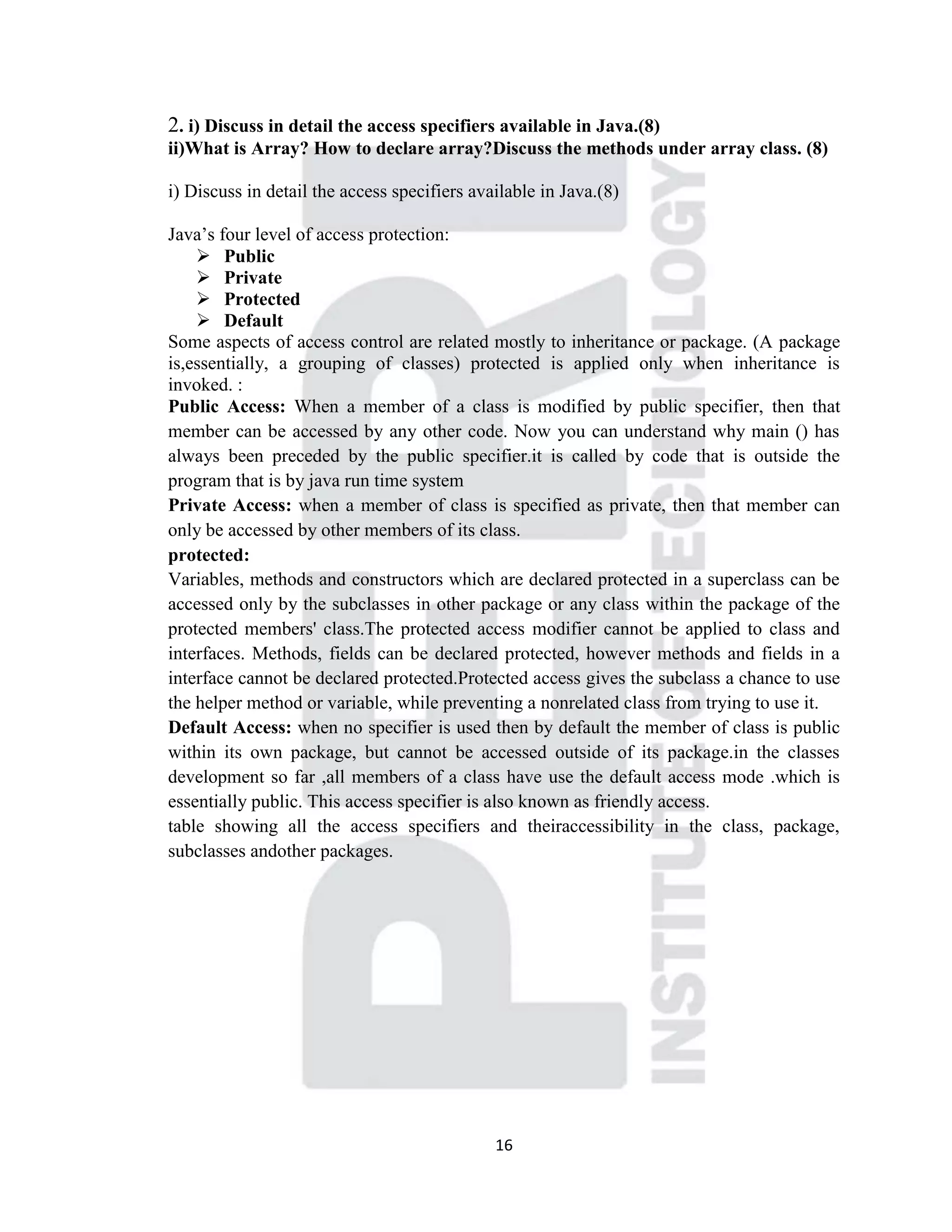
![17 Example of public & private /* Program to demonstrate Access Protection */ class Demo { int p; // default access public int q; // public access private int r; // private access // methods to access r void setr(int i) { // set r's value r = i; } int getr() { // get r's value return r; } } class AccessProDemo { public static void main(String args[]) { Demo d= new Demo(); // OK : 'p' and 'q' may be accessed directly d.p=300; d.q=400; // NOT OK : 'r' cannot be accessed outside the class, hence will cause an error // d.r=50; // You must access 'r' through its methods d.setr(500); //OK System.out.println(" p, q, and r = "+d.p+", "+d.q+", and "+d.getr()); } } o/p:- P, q, and r =300,400, and 500](https://image.slidesharecdn.com/internetprogramming-cs6501-iiiyearcseanswerkey-161020051409/75/CS6501-Internet-programming-17-2048.jpg)
![18 2.ii) What is Array? How to declare array?Discuss the methods under array class. An array is a data structure that stores a collection of values of the same type. You access each individualvalue through an integer index. Array Name [index] Integer constant, variable, or expression For Instance we can define an array name salary to represent a set of salaries of a group of employees. Aparticular value is indicated by writing a number called index in brackets after the array name. salary [10] it represents the salary of the 10th employee. Types of arrays One dimensional arrays Two dimensional arrays One Dimensional arrays A list of items can be given one variable name using only one subscript and such a variable iscalled single - subscripted of one dimensional array. The subscript can also start from 0. ie x[0]. If we want to represent a set of five numbers, say (35,40,20,57,19) by an array variable number,then we have to create the variable number as follows int number [ ] = new int [5 ]; The value to the array elements can be assigned as follows Number[0] =35; Number [1] =40; Number [2] =20; Number [3] =57; Number [4] =19; This would cause the array number to store the values shown as follows; Creating an array Declaring the array Creating memory locations Putting values into the memory locations. Declaring the Array Array in java can be declared in two forms Form 1 type arrayname [ ]; Form 2 type [ ] arrayname; Creation of arrays arrayname = new type [ size ]; Eg; number = new int [5] ; average = new float[10]; it is also possible to combine declaration and creation. int number [ ] = new int [5]; Initialization of arrays](https://image.slidesharecdn.com/internetprogramming-cs6501-iiiyearcseanswerkey-161020051409/75/CS6501-Internet-programming-18-2048.jpg)
![19 The final step is to put values into the array created. This process is known as initialization usingthe array subscripts as shown below. arrayname[subscript] = value ; Eg number[0] = 15; we can also initialize by following way typearrayname [ ] = { list of values } Array Length All array store the allocated size in an variable named length. We can obtain the length of array ausing a.length Eg: intasize = a.length; Sample Code for array manipulation Two Dimensional arrary: Usage :intmyArray [ ] [ ]; myArray= new int [3] [4]; or initmyArray [ ] [ ] = new int [3][4] This creates a table that can store 12 integer values, four across and three down. Strings: Series of characters represents a string, and easiest way to represent the string is array Eg: Char charArray [ ] = new char [2] ; charArray[0] = „j‟ ; charArray[1] = „a‟ ; String can be declared and created in the following way string stringname; stringname = new string (―string‖); Operations on string int m = stringname.length() //will return the length of the string string city = ―New‖ + ―Delhi‖// will return New Delhi ,string concatenating Sample Code forstring Manipulation 3. Explain Packages in detail with example. (16) Packages are java‟s way of grouping a variety of classes and/or interfaces together. Packages are container for the classes. It is stored in a hierarichical manner. If we want to use the packages in a class, we want to import it. The two types of packages are: 1. System package. 2. User defined package. Uses of Packages: Packages reduce the complexity of the software because a large number of classes can be grouped into a limited number of packages.](https://image.slidesharecdn.com/internetprogramming-cs6501-iiiyearcseanswerkey-161020051409/75/CS6501-Internet-programming-19-2048.jpg)
![20 We can create classes with same name in different packages. Using packages we can hide classes. We may like to use many of the classes contained in a package.it can be achieved by Import packagename .classname Or Import packagename.* Creating the package To create our own packages packagefirstpackage;// package declaration public class FirstClass //class definition {..... (body of class) .......} The file is saved as FirstClass.java,located at firstpackage directory. when it is compiled .class file will be created in same ditectory. Access a package The import statement can be used to search a list of packages for a particular class. The general form of import statement for searching class is a as follows. Import package1 [.package2] [.package3].classname; Using the package package package1 ; public class classA { public void displayA() { System.out.println(―class A‖); } } Adding a class to package Define the class and make it public Place the package statement Package P1 Before the class definition as follows Package p1; Public class B Package name { // body of B } Example: Package college Class student {](https://image.slidesharecdn.com/internetprogramming-cs6501-iiiyearcseanswerkey-161020051409/75/CS6501-Internet-programming-20-2048.jpg)
![21 intregno; String name; Student(intr,stringna); { Regno=r Name=na } Public void print() { System.out.println(―Regno‖+regno ); System.out.println(―Name‖+name ); } } Package Course Class engineering { Intregno; String branch; String year; Engineering(int r, string br, string yr) { Regno=br; Branch=br; Year=yr; } public void print() { Systems.out.println(―Regno‖+regno); Systems.out.println(― Branch‖+branch); Systems.out.println(―Year‖+year); } } import college.*; import course.*; Class demo { Public static void main(string args[]) { Student sl=new Engineering(1,‖CSE‖,‖III Year‖); Sl.print(); El.print(); } }](https://image.slidesharecdn.com/internetprogramming-cs6501-iiiyearcseanswerkey-161020051409/75/CS6501-Internet-programming-21-2048.jpg)
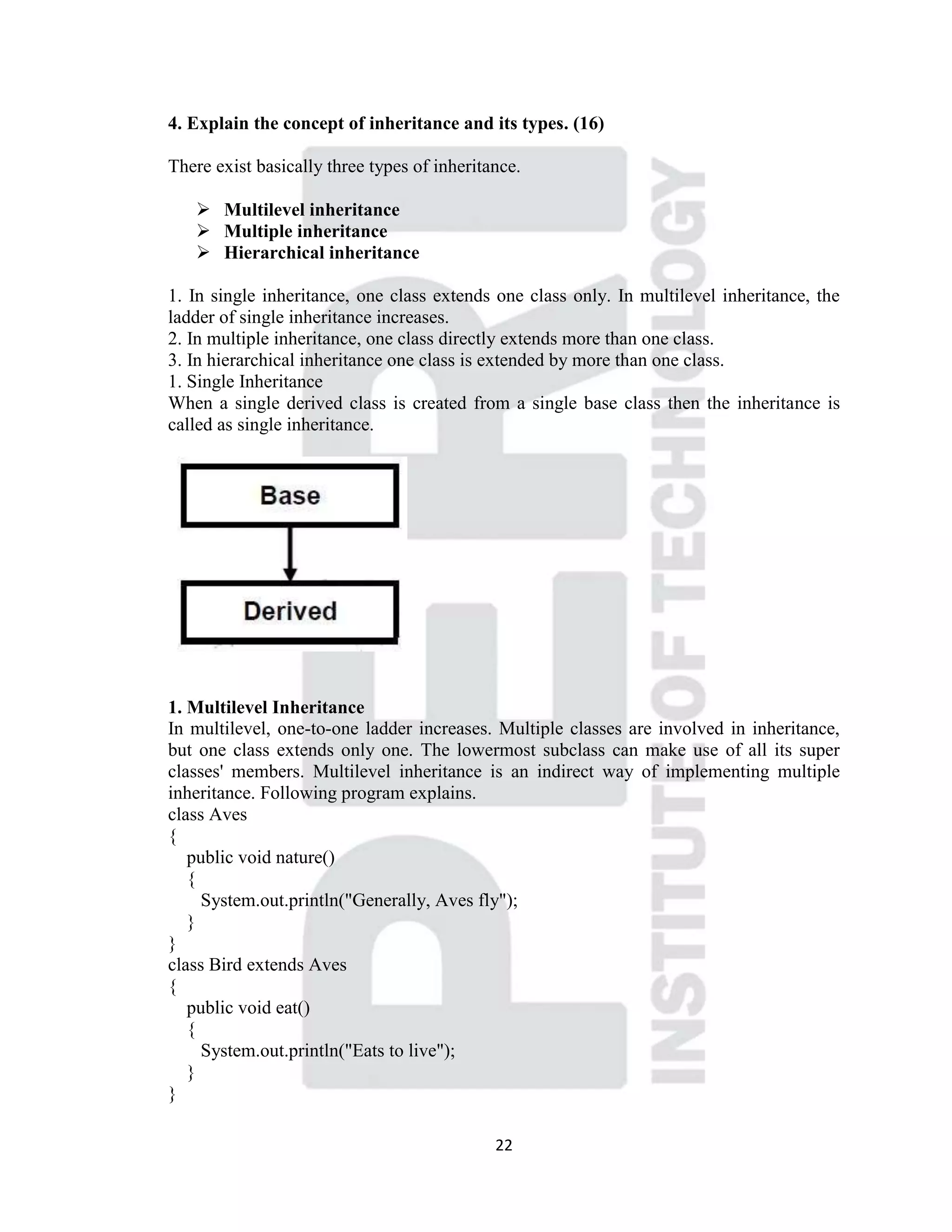
![23 public class Parrot extends Bird { public void food() { System.out.println("Parrot eats seeds and fruits"); } public static void main(String args[]) { Parrot p1 = new Parrot(); p1.food(); // calling its own p1.eat(); // calling super class Bird method p1.nature(); // calling super class Aves method } } Now, Parrot has two super classes Bird and Aves; but extended one-to-one. Parrot can make use of the methods of Bird and Aves. Bird can make use of the methods of Aves, but Parrot as a super class cannot access subclass members. Following figure gives a schematic representation of the multilevel hierarchy with the classes involved in the program. 2. Multiple Inheritance In multiple inheritance, one class extends multiple classes. Java does not support multiple inheritance but C++ supports. The above program can be modified to illustrate multiple inheritance. The following program does not work. calss Aves { } class Bird { }](https://image.slidesharecdn.com/internetprogramming-cs6501-iiiyearcseanswerkey-161020051409/75/CS6501-Internet-programming-23-2048.jpg)
![24 publicclass Parrot extends Aves, Bird { } In the above code, Parrot extends both Aves and Bird. This is not supported by Java and the above code raises compilation error. Following is the schematic representation. Note: Java supports multiple inheritance partially through interfaces. 3. Hierarchical Inheritance In hierarchical type of inheritance, one class is extended by many subclasses. It is one- to-many relationship. A realtime example is available at dynamic binding. class Aves { publicvoid fly() { System.out.println("Generally, aves fly"); } } class Parrot extends Aves { publicvoid eat() { System.out.println("Parrot eats fruits and seeds"); } } class Vulture extends Aves { publicvoid vision() { System.out.println("Vulture can see from high altitudes"); } } publicclass FlyingCreatures { publicstaticvoid main(String args[]) { // all the following code is composition for FlyingCreatures Parrot p1 = new Parrot(); p1.eat(); // calling its own member p1.fly();](https://image.slidesharecdn.com/internetprogramming-cs6501-iiiyearcseanswerkey-161020051409/75/CS6501-Internet-programming-24-2048.jpg)
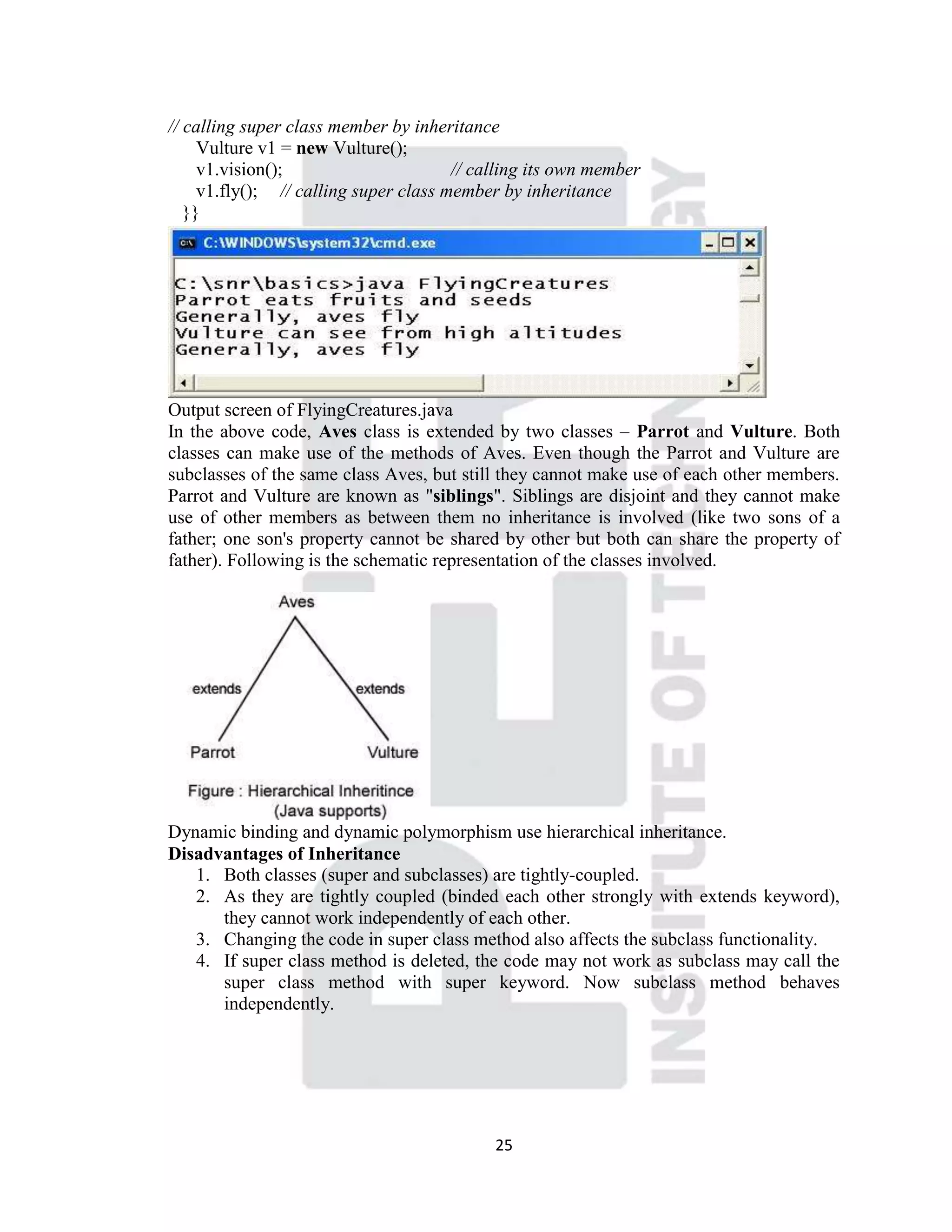

![27 Here is a list of most common checked and unchecked Java's Built-in Exceptions. Exceptions Methods: Following is the list of important medthods available in the Throwable class. Methods with Description 1 public String getMessage() Returns a detailed message about the exception that has occurred. This message isinitialized in the Throwable constructor. 2 public Throwable getCause() Returns the cause of the exception as represented by a Throwable object. 3 public String toString() Returns the name of the class concatenated with the result of getMessage() 4 public void printStackTrace() Prints the result of toString() along with the stack trace to System.err, the error outputstream. 5 public StackTraceElement [] getStackTrace() Returns an array containing each element on the stack trace. The element at index 0represents the top of the call stack, and the last element in the array represents themethod at the bottom of the call stack. 6 public Throwable fillInStackTrace() Fills the stack trace of this Throwable object with the current stack trace, adding to anyprevious information in the stack trace. Catching Exceptions: A method catches an exception using a combination of the try and catch keywords. A try/catchblock is placed around the code that might generate an exception. Code within a try/catch block isreferred to as protected code, and the syntax for using try/catch looks like the following: try { //Protected code }catch(ExceptionName e1) { //Catch block](https://image.slidesharecdn.com/internetprogramming-cs6501-iiiyearcseanswerkey-161020051409/75/CS6501-Internet-programming-27-2048.jpg)
![28 } A catch statement involves declaring the type of exception you are trying to catch. If an exceptionoccurs in protected code, the catch block (or blocks) that follows the try is checked. If the type ofexception that occurred is listed in a catch block, the exception is passed to the catch block muchas an argument is passed into a method parameter. Example: The following is an array is declared with 2 elements. Then the code tries to access the 3rd elementof the array which throws an exception. // File Name : ExcepTest.java import java.io.*; public class ExcepTest{ public static void main(String args[]){ try{ int a[] = new int[2]; System.out.println("Access element three :" + a[3]); }catch(ArrayIndexOutOfBoundsException e){ System.out.println("Exception thrown :" + e); } System.out.println("Out of the block"); } } This would produce the following result: Exception thrown :java.lang.ArrayIndexOutOfBoundsException: 3 Out of the block Multiple catch Blocks: A try block can be followed by multiple catch blocks. The syntax for multiple catch blocks looks likethe following: try { //Protected code }catch(ExceptionType1 e1) { //Catch block }catch(ExceptionType2 e2) { //Catch block }catch(ExceptionType3 e3) { //Catch block } The previous statements demonstrate three catch blocks, but you can have any number of themafter a single try. If an exception occurs in the protected code, the exception is thrown to the firstcatch block in the list. If the data type of the exception thrown matches ExceptionType1, it getscaught there. If not, the exception passes down to the second catch statement. This continuesuntil the exception either is caught or falls through all](https://image.slidesharecdn.com/internetprogramming-cs6501-iiiyearcseanswerkey-161020051409/75/CS6501-Internet-programming-28-2048.jpg)

![30 //Remainder of class definition } The finally Keyword The finally keyword is used to create a block of code that follows a try block. A finally block of codealways executes, whether or not an exception has occurred. Using a finally block allows you to run any cleanup-type statements that you want to execute, nomatter what happens in the protected code.A finally block appears at the end of the catch blocks and has the following syntax: try { //Protected code }catch(ExceptionType1 e1) { //Catch block }catch(ExceptionType2 e2) { //Catch block }catch(ExceptionType3 e3) { //Catch block }finally { //The finally block always executes. } Example: public class ExcepTest{ public static void main(String args[]){ int a[] = new int[2]; try{ System.out.println("Access element three :" + a[3]); }catch(ArrayIndexOutOfBoundsException e){ System.out.println("Exception thrown :" + e); } finally{ a[0] = 6; System.out.println("First element value: " +a[0]); System.out.println("The finally statement is executed"); } } } This would produce the following result: Exception thrown :java.lang.ArrayIndexOutOfBoundsException: 3 First element value: 6 The finally statement is executed Note the following:](https://image.slidesharecdn.com/internetprogramming-cs6501-iiiyearcseanswerkey-161020051409/75/CS6501-Internet-programming-30-2048.jpg)

![32 public void deposit(double amount) { balance += amount; } public void withdraw(double amount) throws InsufficientFundsException { if(amount <= balance) { balance -= amount; } else { double needs = amount - balance; throw new InsufficientFundsException(needs); } } public double getBalance() { return balance; } public int getNumber() { return number; } } The following BankDemo program demonstrates invoking the deposit() and withdraw() methods ofCheckingAccount. // File Name BankDemo.java public class BankDemo { public static void main(String [] args) { CheckingAccount c = new CheckingAccount(101); System.out.println("Depositing $500..."); c.deposit(500.00); try { System.out.println("nWithdrawing $100..."); c.withdraw(100.00); System.out.println("nWithdrawing $600..."); c.withdraw(600.00); }catch(InsufficientFundsException e) { System.out.println("Sorry, but you are short $" + e.getAmount());](https://image.slidesharecdn.com/internetprogramming-cs6501-iiiyearcseanswerkey-161020051409/75/CS6501-Internet-programming-32-2048.jpg)
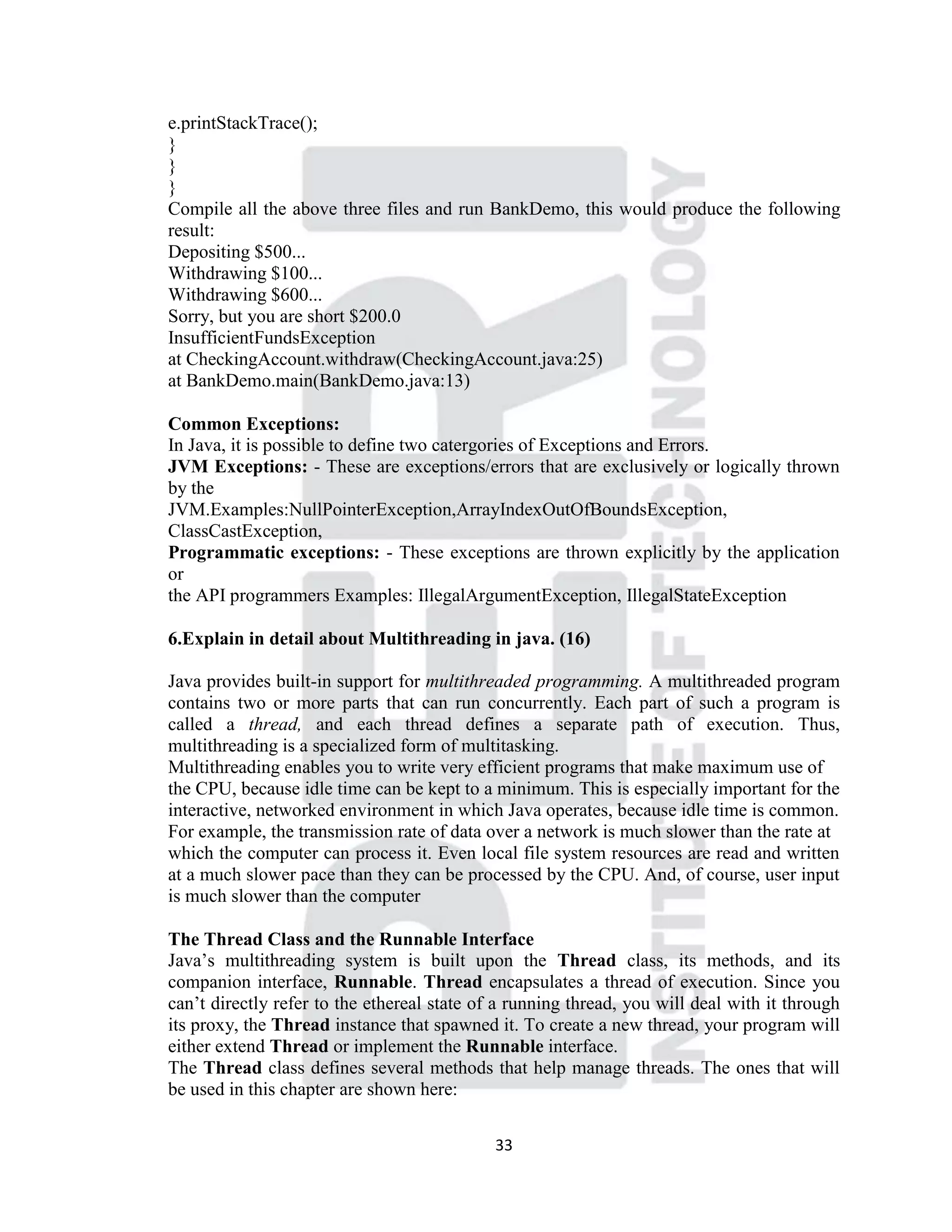
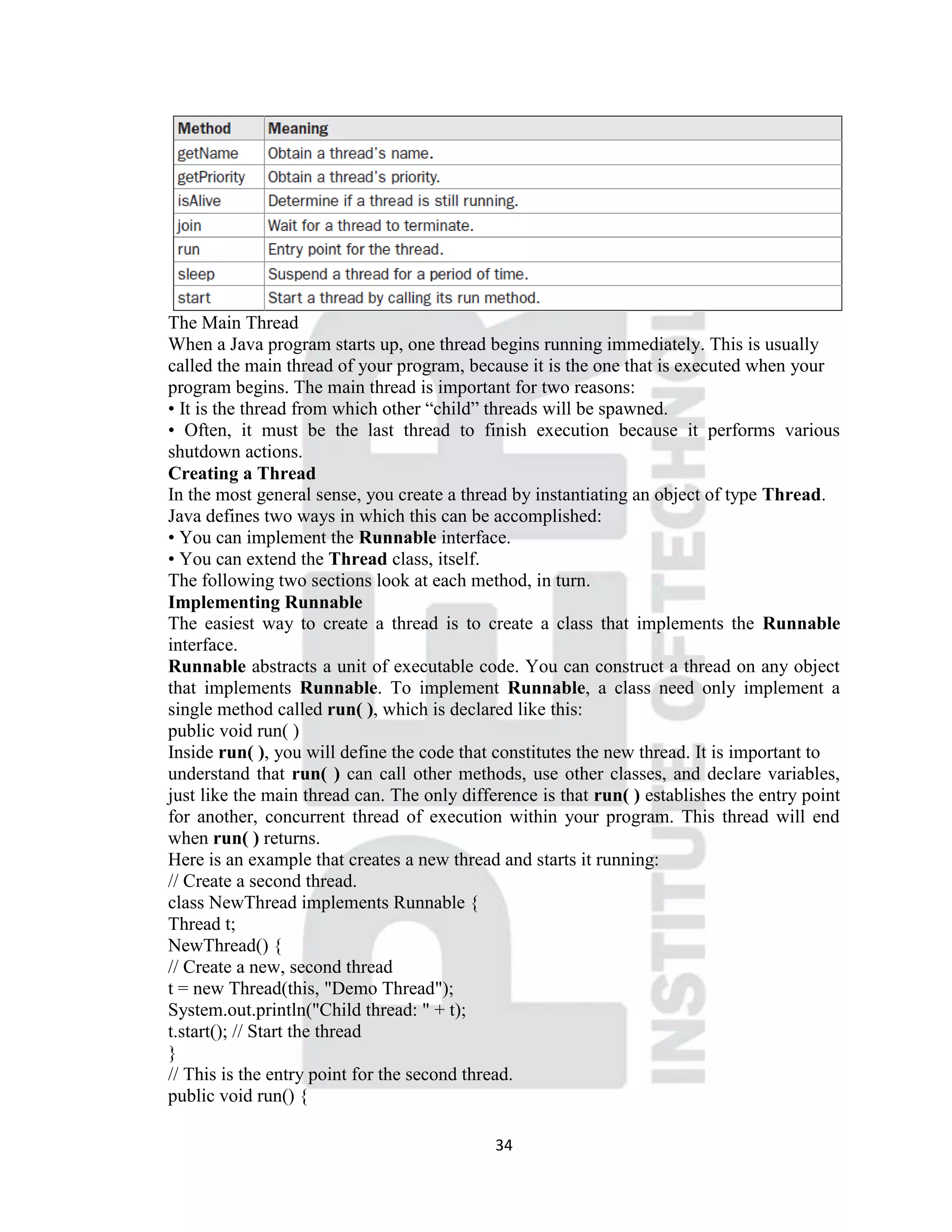
![35 try { for(int i = 5; i > 0; i--) { System.out.println("Child Thread: " + i); Thread.sleep(500); } } catch (InterruptedException e) { System.out.println("Child interrupted."); } System.out.println("Exiting child thread."); } } class ThreadDemo { public static void main(String args[]) { new NewThread(); // create a new thread try { for(int i = 5; i > 0; i--) { System.out.println("Main Thread: " + i); Thread.sleep(1000); } } catch (InterruptedException e) { System.out.println("Main thread interrupted."); } System.out.println("Main thread exiting."); } } Inside NewThread‘s constructor, a new Thread object is created by the following statement: t = new Thread(this, "Demo Thread"); o/p: Child thread: Thread[Demo Thread,5,main] Main Thread: 5 Child Thread: 5 Child Thread: 4 Main Thread: 4 Child Thread: 3 Child Thread: 2 Main Thread: 3 Child Thread: 1 Exiting child thread. Main Thread: 2 Main Thread: 1 Main thread exiting.](https://image.slidesharecdn.com/internetprogramming-cs6501-iiiyearcseanswerkey-161020051409/75/CS6501-Internet-programming-35-2048.jpg)
![36 Creating Multiple Threads So far, you have been using only two threads: the main thread and one child thread. However, your program can spawn as many threads as it needs. For example, the following program creates three child threads: // Create multiple threads. class NewThread implements Runnable { String name; // name of thread Thread t; NewThread(String threadname) { name = threadname; t = new Thread(this, name); System.out.println("New thread: " + t); t.start(); // Start the thread } // This is the entry point for thread. public void run() { try { for(int i = 5; i > 0; i--) { System.out.println(name + ": " + i); Thread.sleep(1000); } } catch (InterruptedException e) { System.out.println(name + "Interrupted"); } System.out.println(name + " exiting."); } } class MultiThreadDemo { public static void main(String args[]) { new NewThread("One"); // start threads new NewThread("Two"); new NewThread("Three"); try { // wait for other threads to end Thread.sleep(10000); } catch (InterruptedException e) { System.out.println("Main thread Interrupted"); } System.out.println("Main thread exiting."); } } The output from this program is shown here: New thread: Thread[One,5,main] New thread: Thread[Two,5,main] New thread: Thread[Three,5,main] One: 5](https://image.slidesharecdn.com/internetprogramming-cs6501-iiiyearcseanswerkey-161020051409/75/CS6501-Internet-programming-36-2048.jpg)
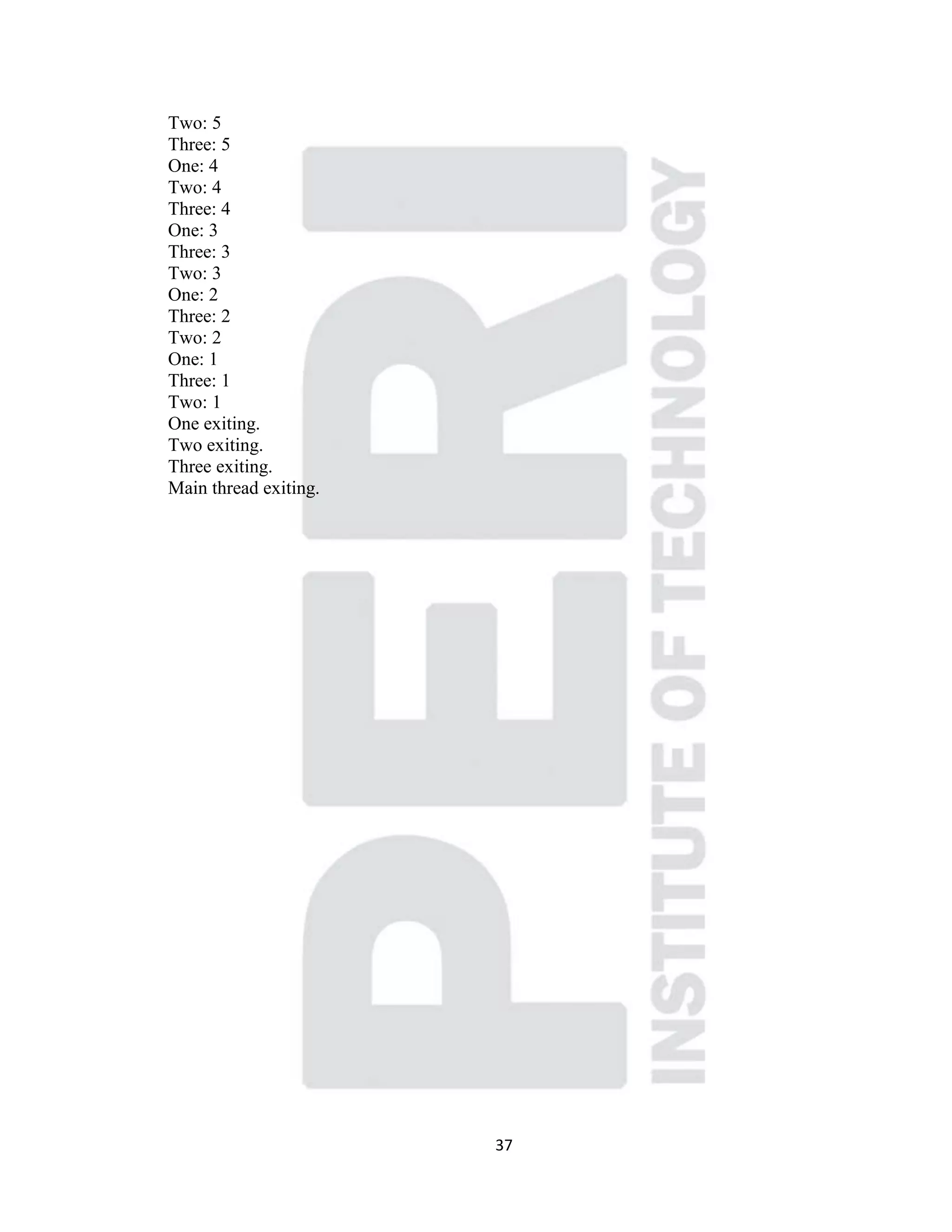
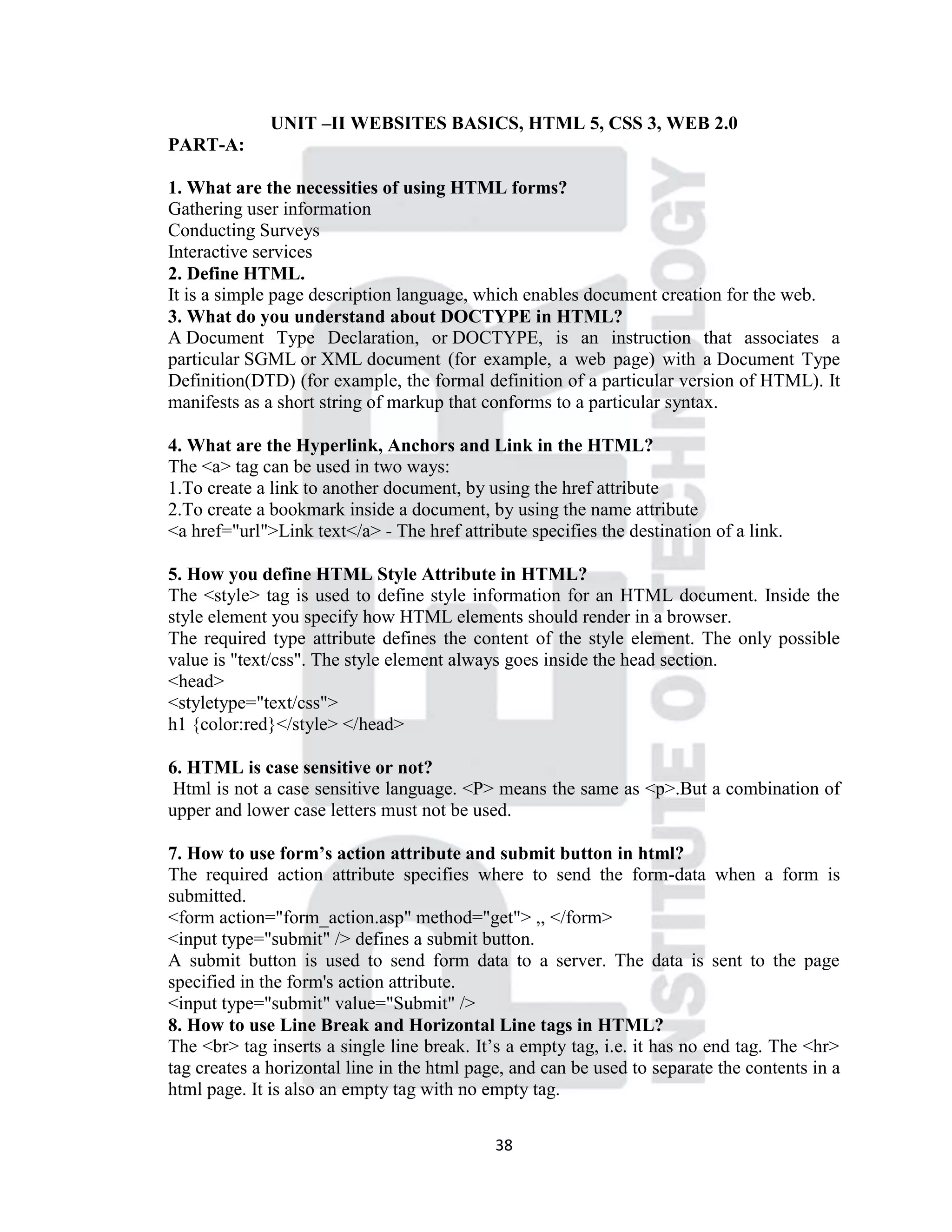
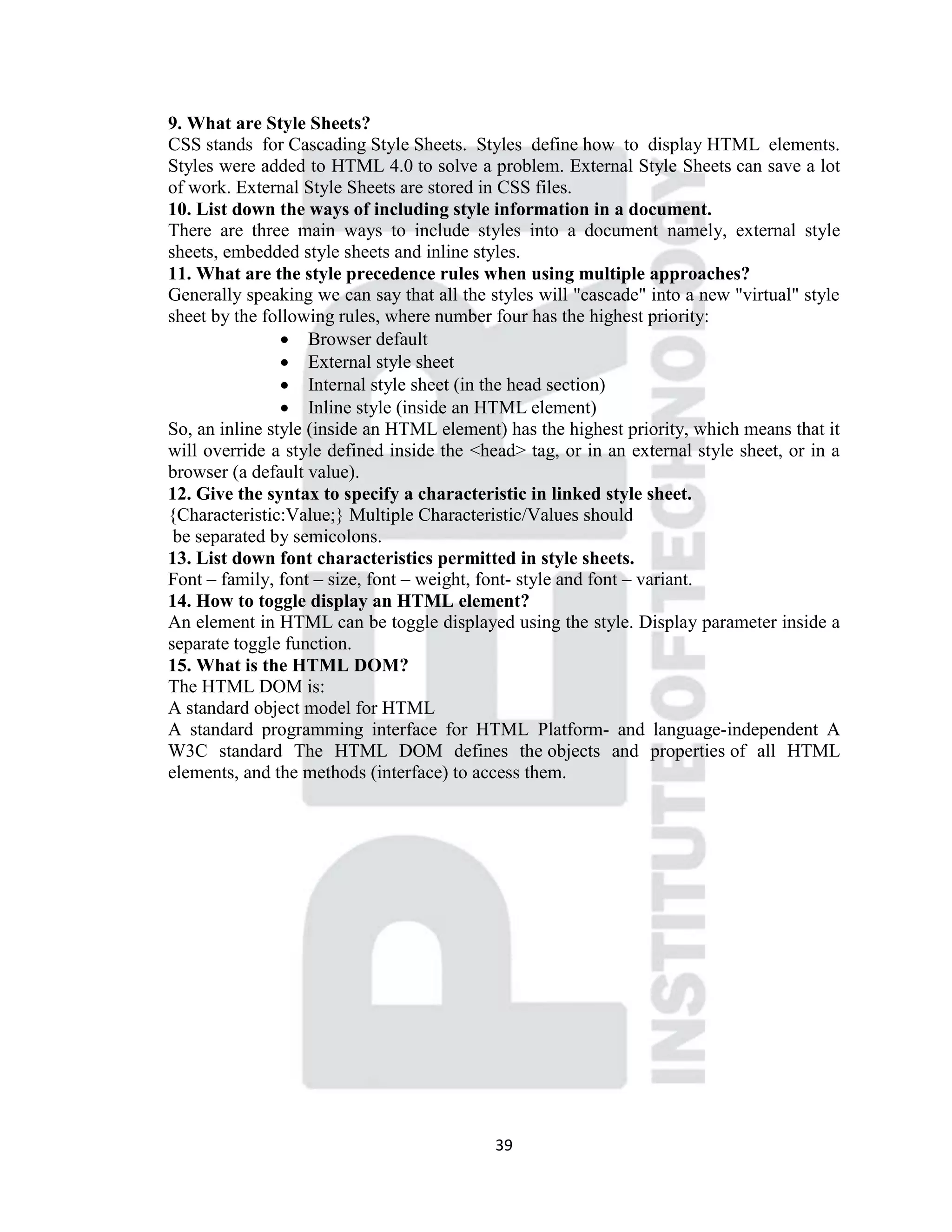

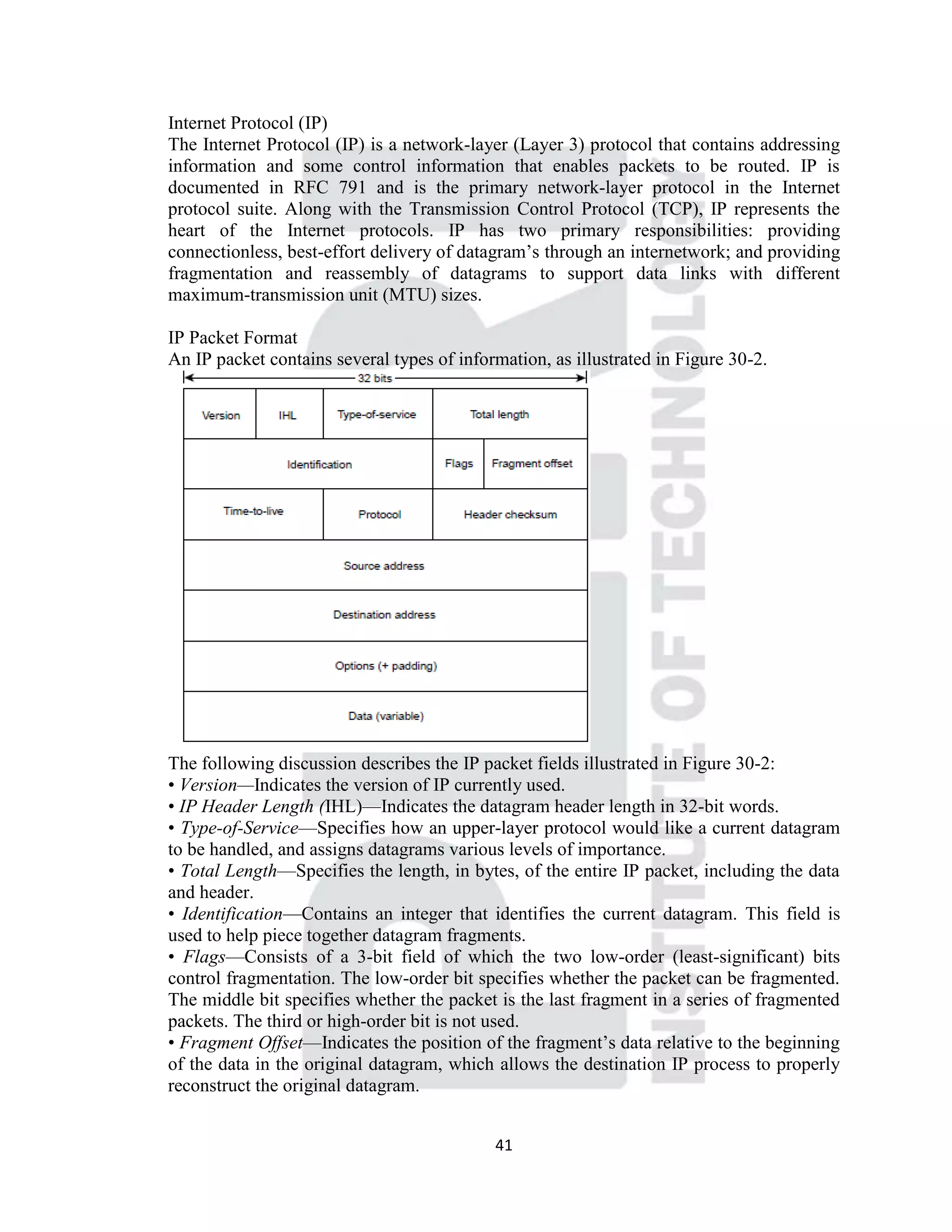
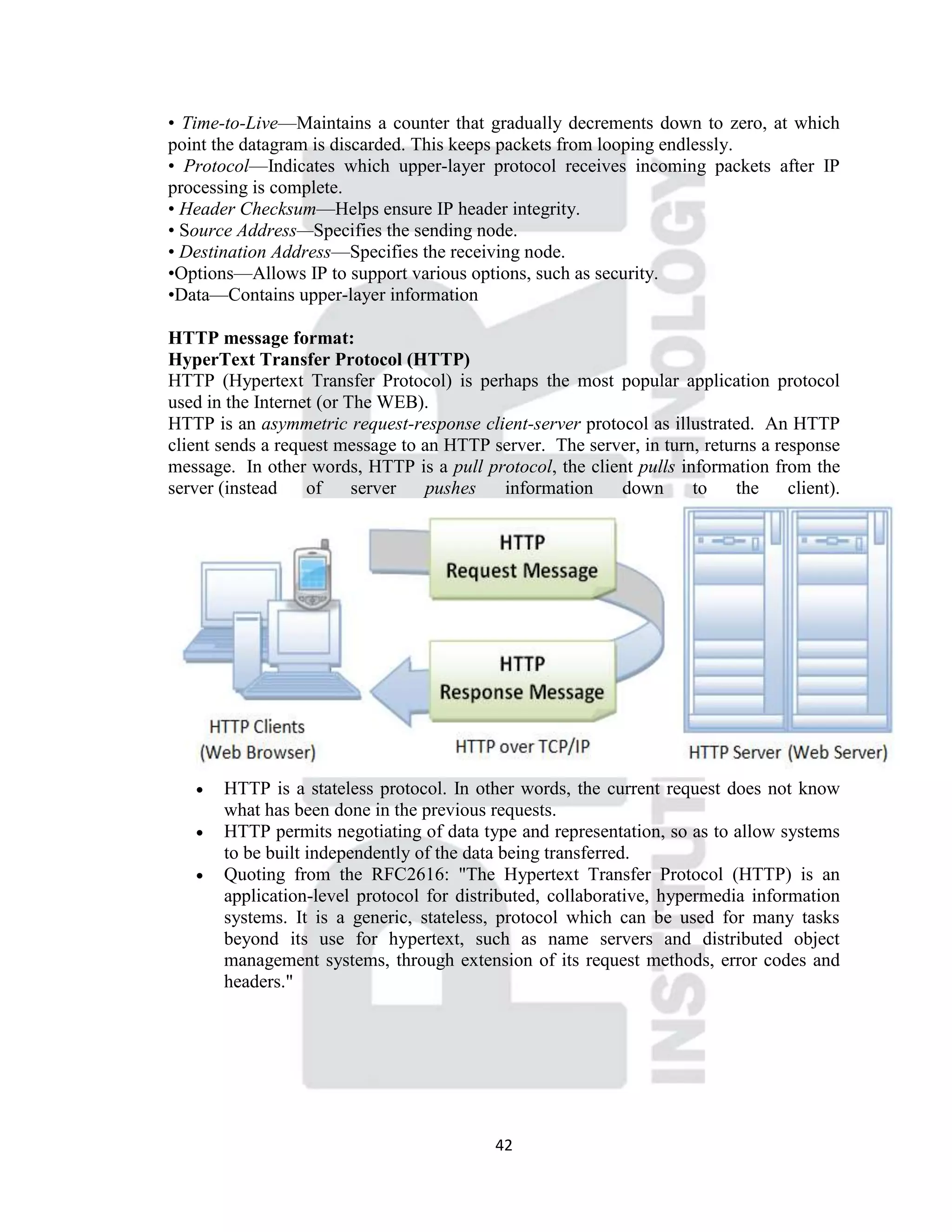
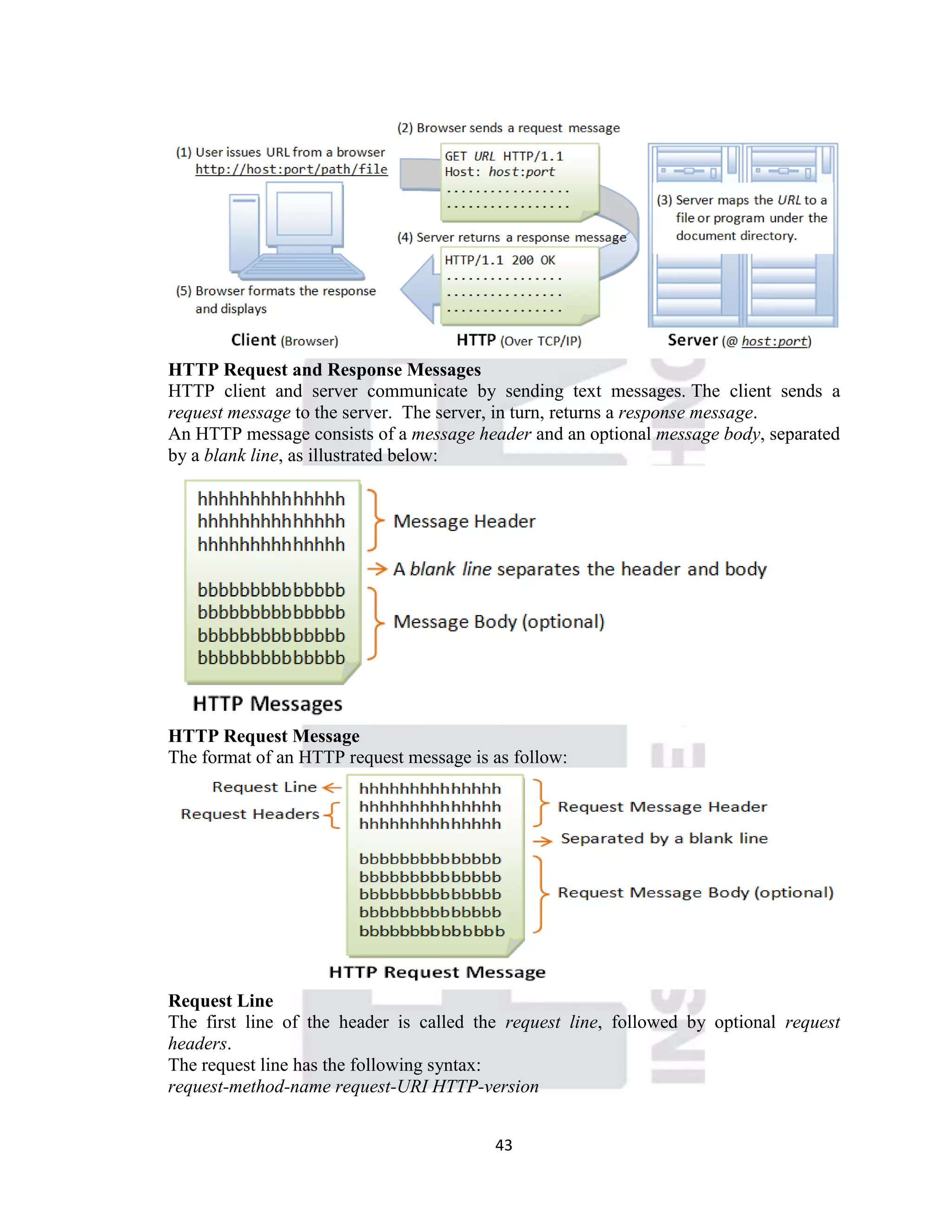
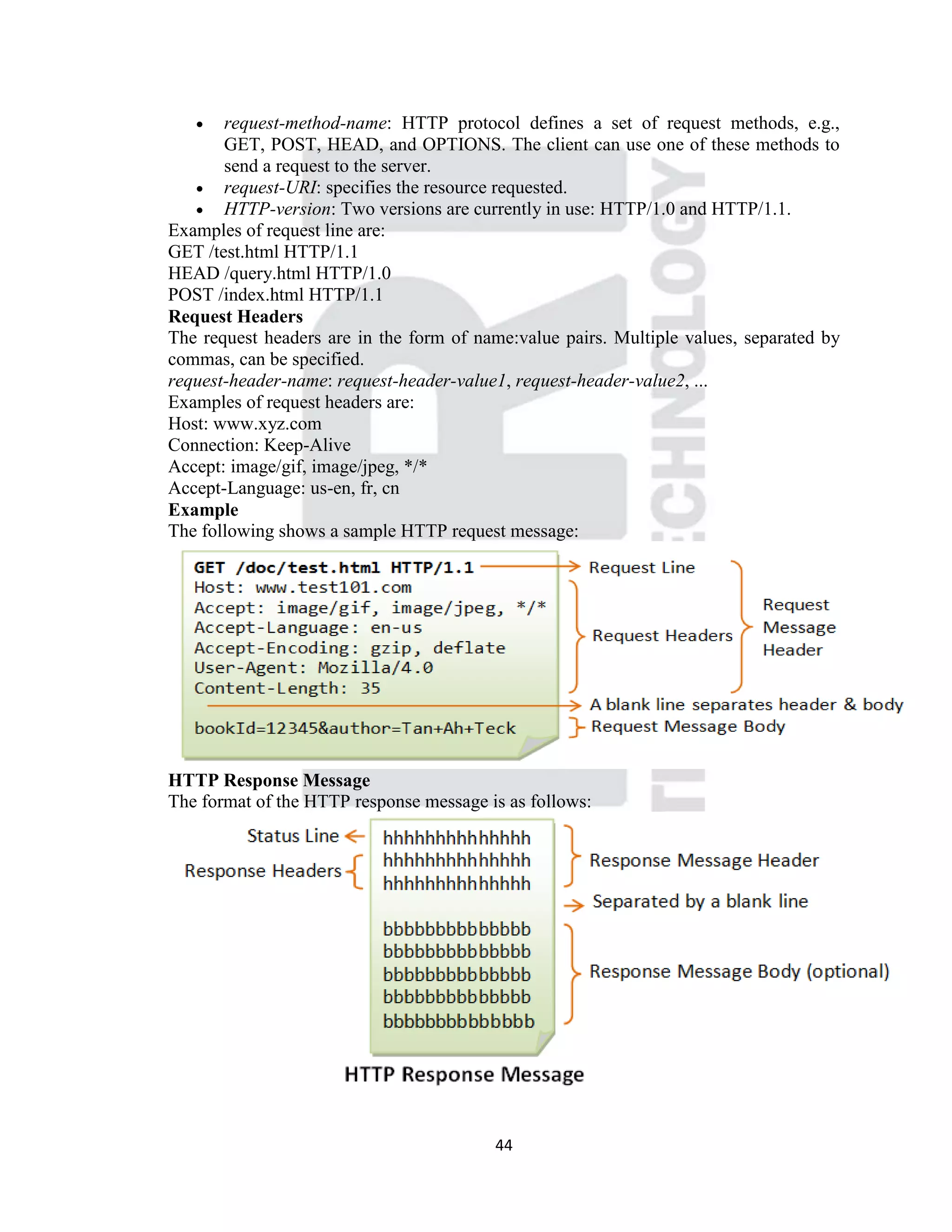
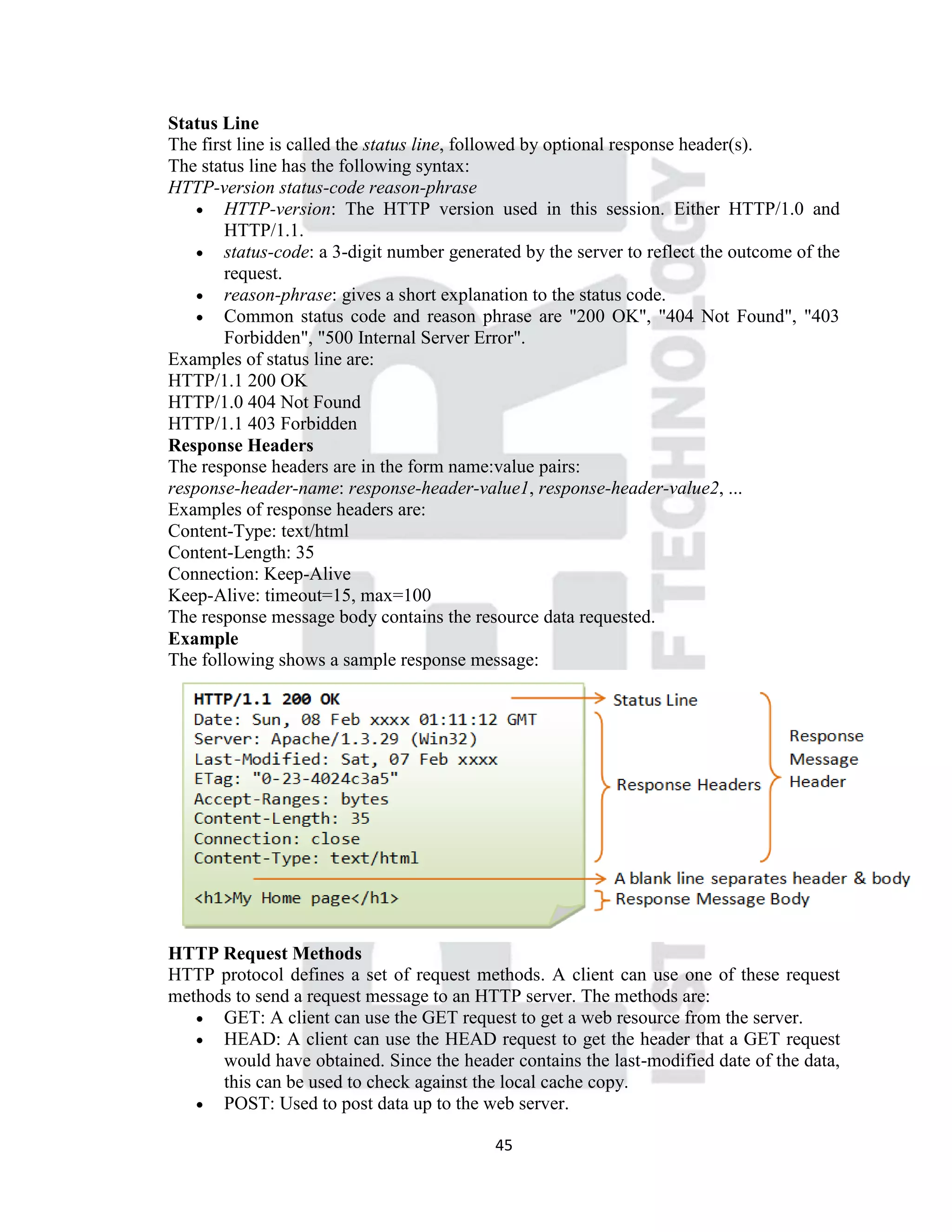



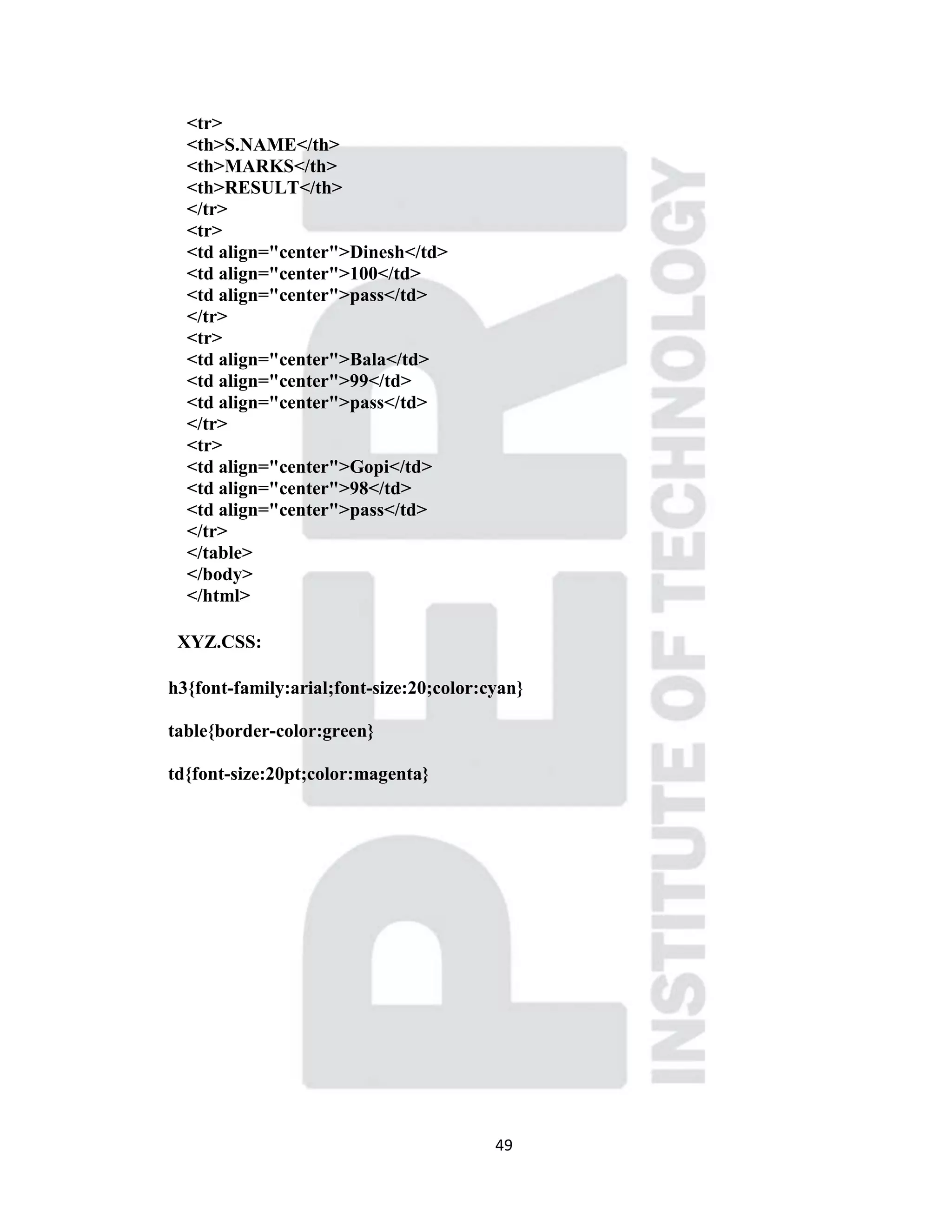
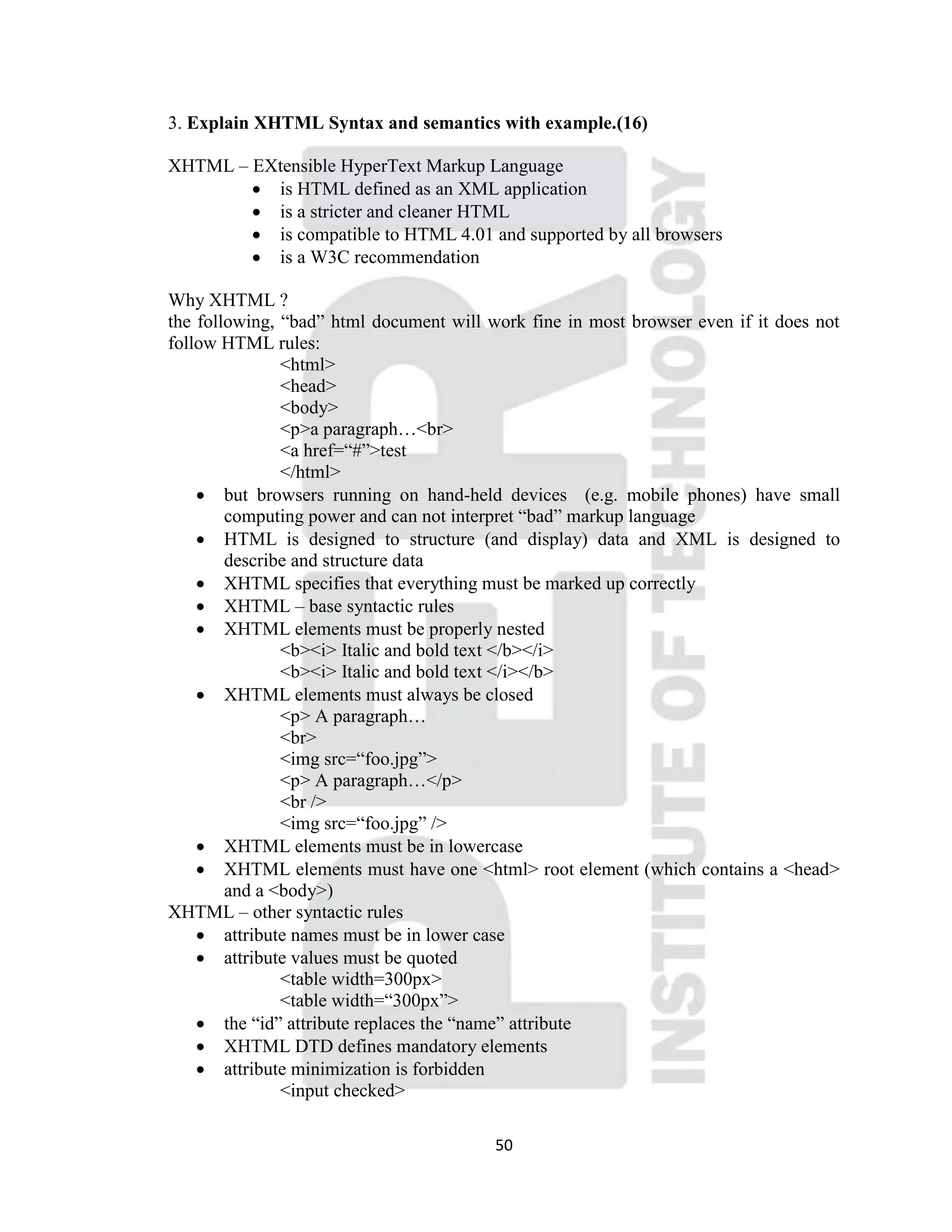
![51 <input disabled> <input checked=―checked‖ /> <input disabled=―disabled‖ /> General format of an XHTML document <!DOCTYPE html PUBLIC "-//W3C//DTD XHTML 1.0 Transitional//EN" "http://www.w3.org/TR/xhtml1/DTD/xhtml1-transitional.dtd"> <html> <head> <title>…</title> </head> <body> … </body> </html> <!Doctype>,<html>,<head>,<title>,<body> are mandatory DTD – Document Type Definition a DTD specifies the syntax of a document written in a SGML language (HTML, XHTML, XML) it specifies: o the hierarchical structure of the document, o element names and types o element content type o and attributes names and values o XML 1.0 has 3 DTDs: Strict, Transitional and Frameset DTD example (internal to XHTML file) <!DOCTYPE course [ <!ELEMENT course (lecture+)> <!ELEMENT lecture (title,bibliography,notes,examples)> <!ELEMENT title (#PCDATA)> <!ELEMENT bibliography (#PCDATA)> <!ELEMENT notes (#PCDATA)> <!ELEMENT examples (#PCDATA)> <!ATTLIST course professor CDATA #REQUIRED> <!ATTLIST course title CDATA #REQUIRED> <!ATTLIST course yearofstudy CDATA #REQUIRED> <!ATTLIST course date CDATA #IMPLIED> ]> XHTML validation a valid XHTML document is an XHTML document which obeys the rules of the DTD specified by the <!Doctype> tag. the official W3C XHTML validator: http://validator.w3.org/check/referer XHTML DTD is split in 28 modules](https://image.slidesharecdn.com/internetprogramming-cs6501-iiiyearcseanswerkey-161020051409/75/CS6501-Internet-programming-51-2048.jpg)


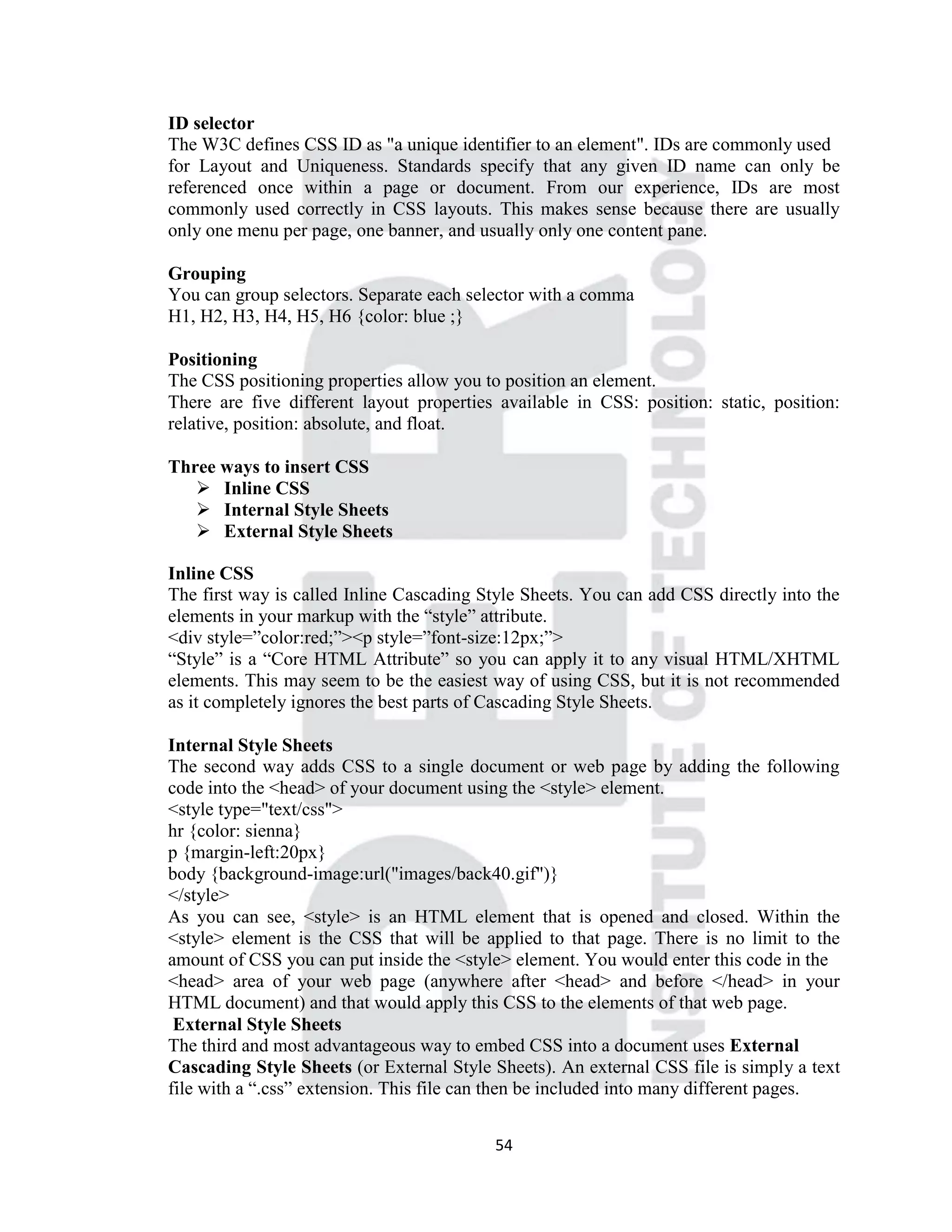

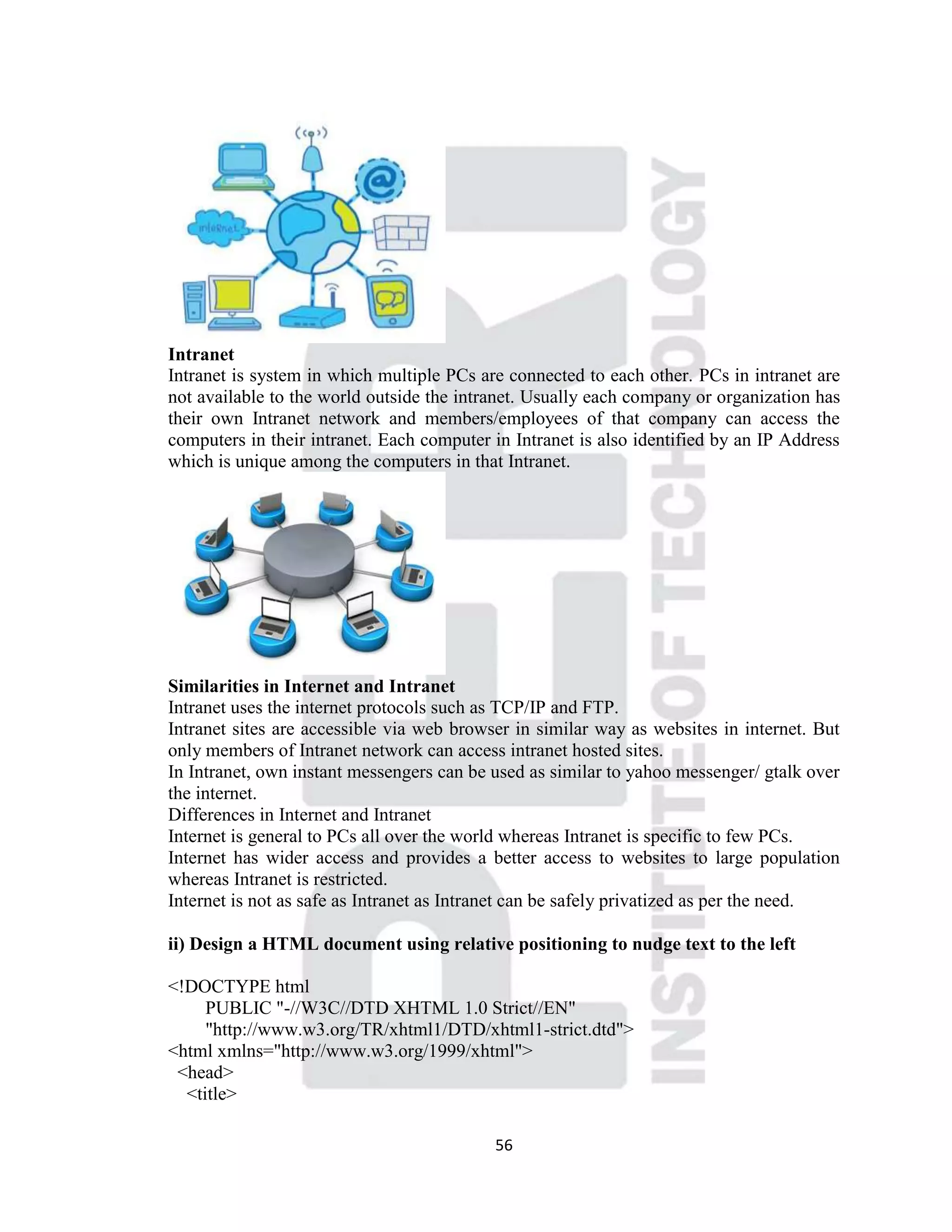
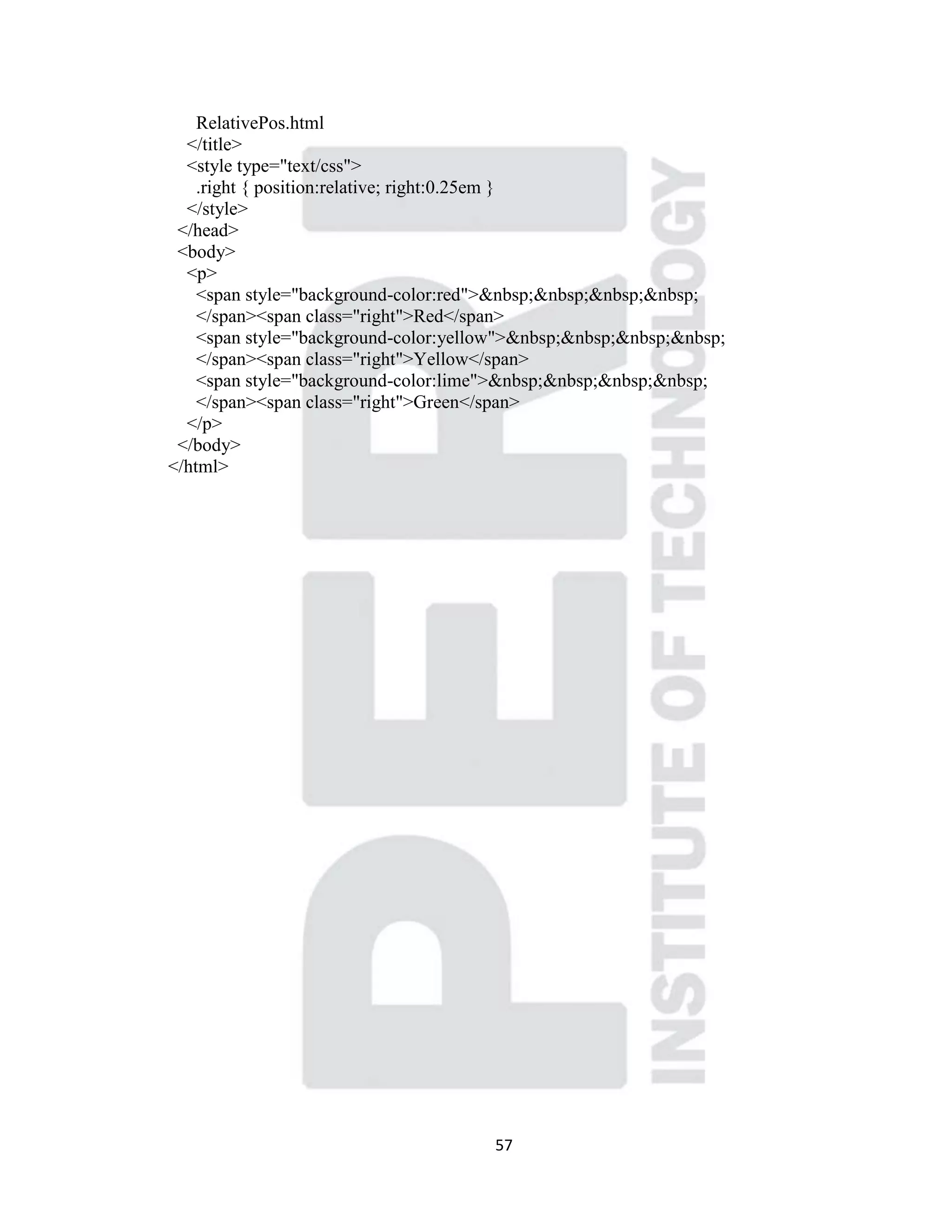
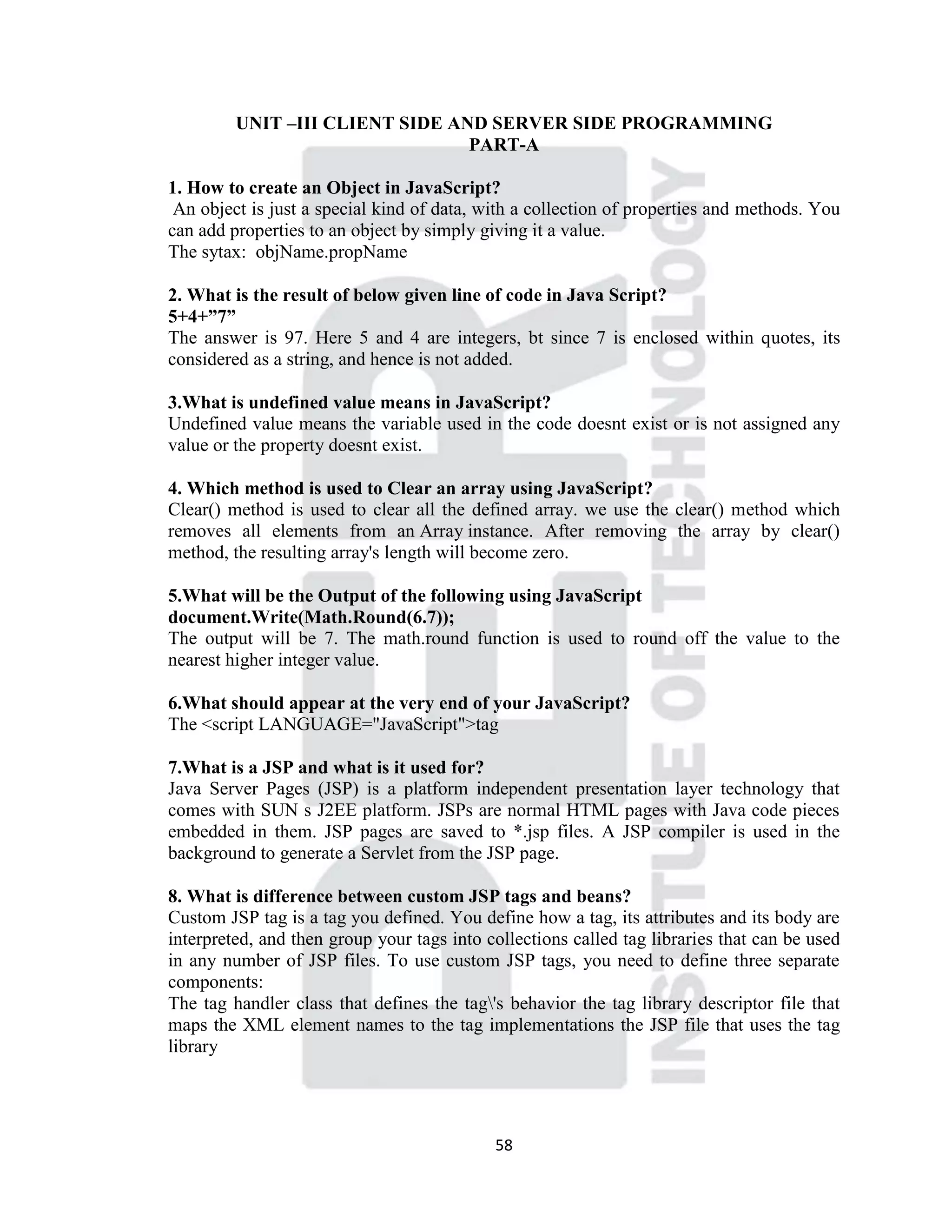
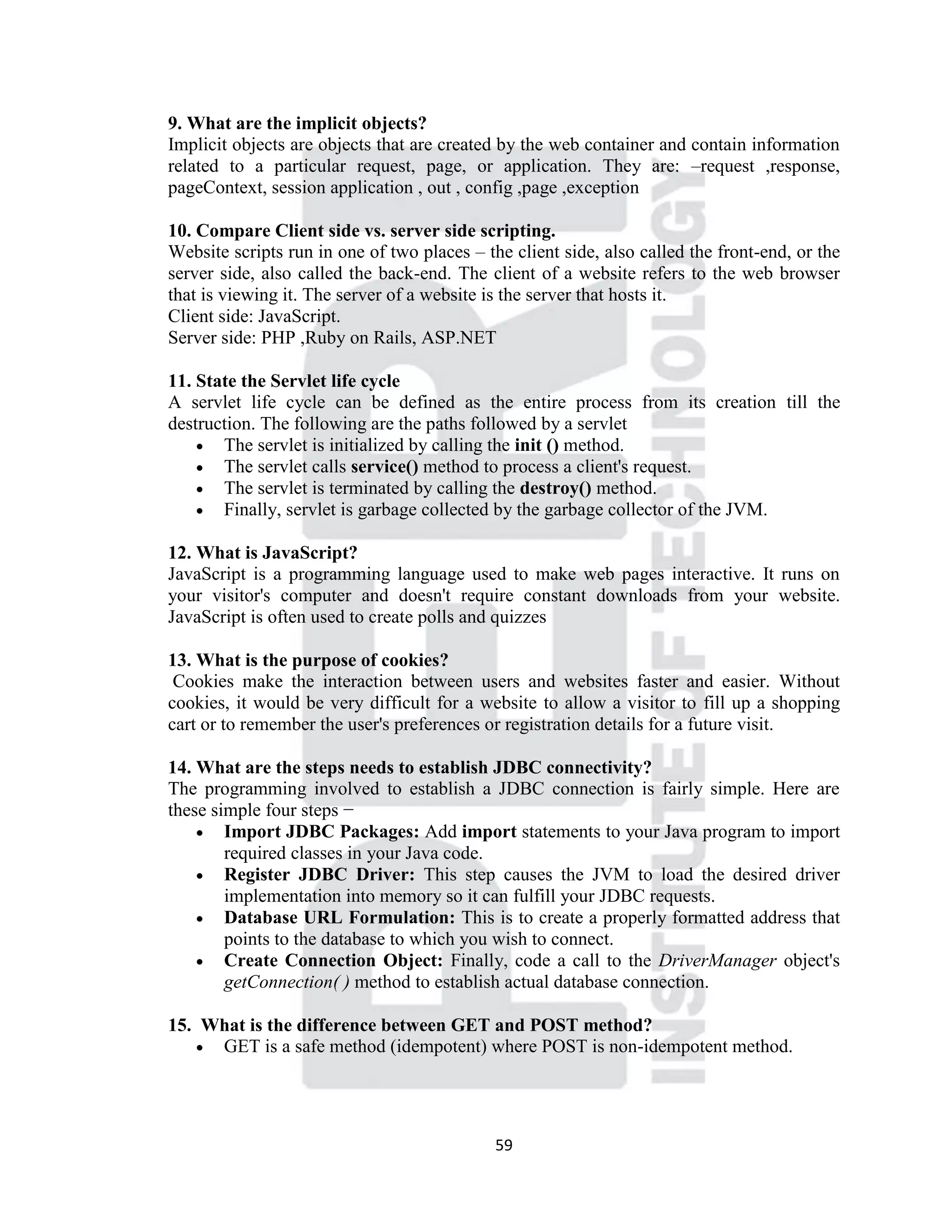
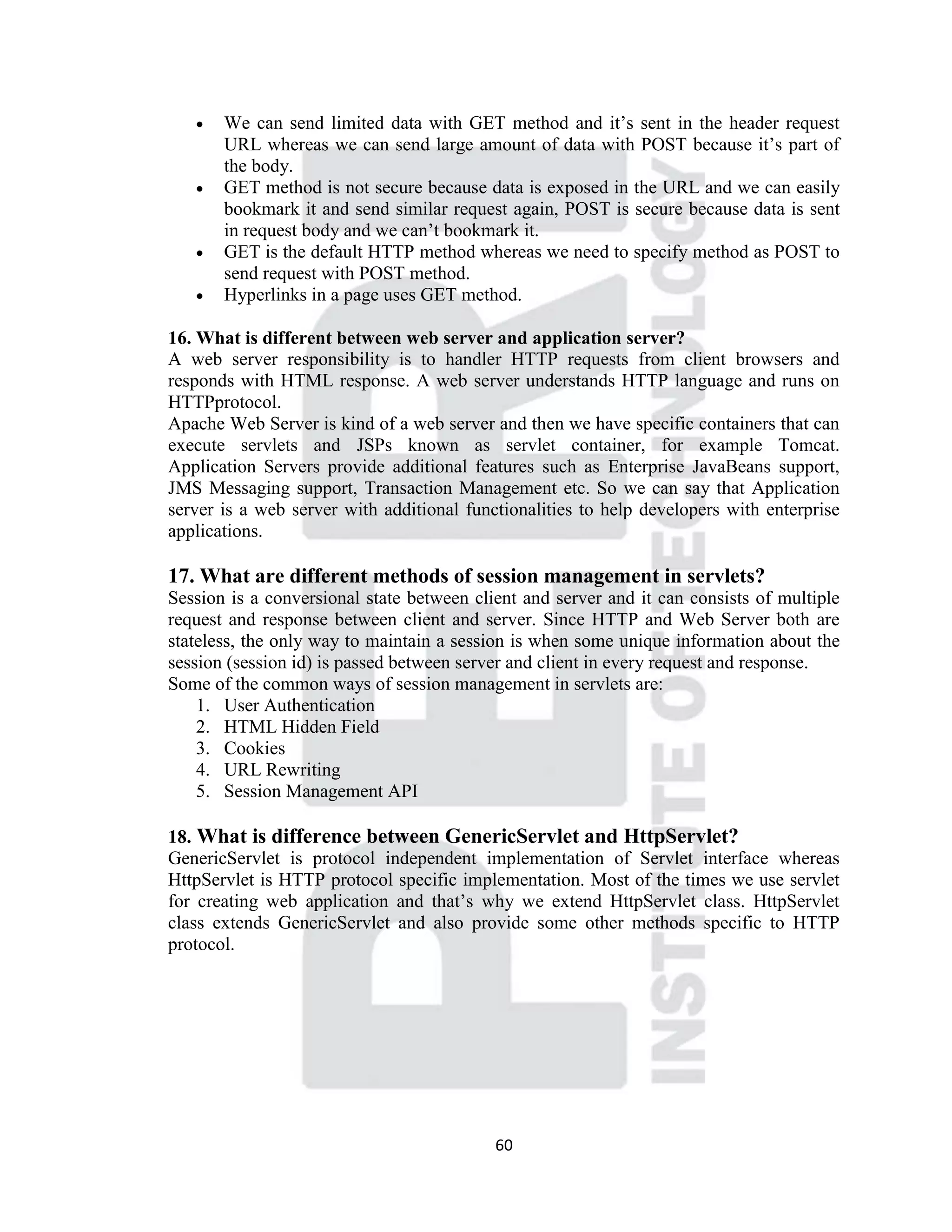
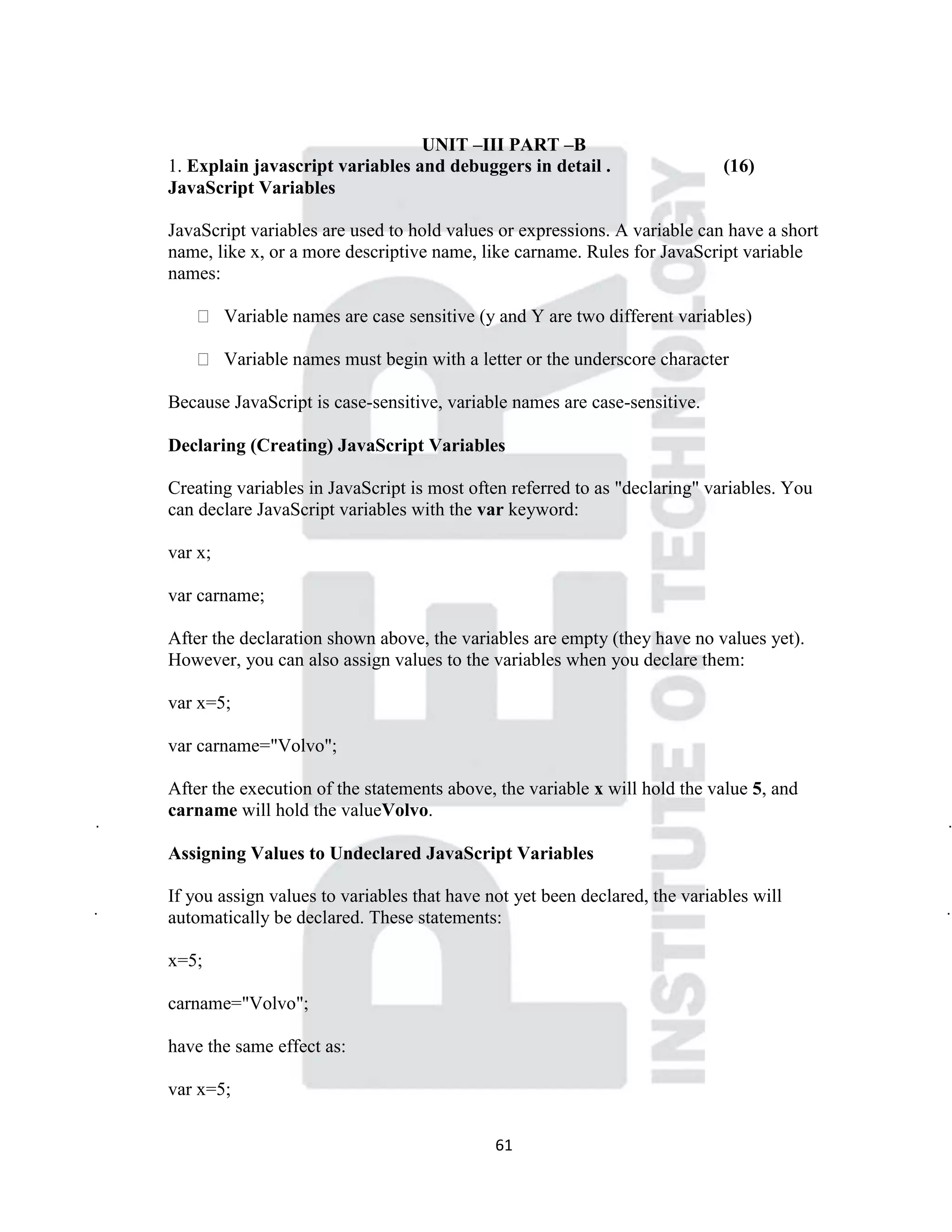
![62 var carname="Volvo"; Redeclaring JavaScript Variables If you redeclare a JavaScript variable, it will not lose its original value. var x=5; var x; After the execution of the statements above, the variable x will still have the value of 5. The value of x is not reset (or cleared) when you redeclare it. The Lifetime of JavaScript Variables If you declare a variable within a function, the variable can only be accessed within that function. When you exit the function, the variable is destroyed. These variables are called local variables. You can have local variables with the same name in different functions, because each is recognized only by the function in which it is declared. If you declare a variable outside a function, all the functions on your page can access it. The lifetime of these variables starts when they are declared, and ends when the page is closed 2. Discuss JavaScript Array object in detail. (16) JavaScript Arrays •Arrays are used to store lists or collections of items •Arrays in JavaScript are indexed by numbers from 0 •Array elements can be any type, even arrays or objects •An array‘s elements do not have to have the same type Creating Arrays Arrays can be created with the new keyword var(myArray(=(new(Array(); var(myArray(=(new(Array(―one‖,―two‖,(3); or with array literal syntax var(myArray(=([]; var(myArray(=([―one‖,(―two‖,(3]; Updating Array Elements Insert by index myArray[5](=(―new(item‖; Stack/queue-like interface myArray.push(―new(item‖); var(lastItem(=(myArray.pop(); var(firstItem(=(myArray.shift();](https://image.slidesharecdn.com/internetprogramming-cs6501-iiiyearcseanswerkey-161020051409/75/CS6501-Internet-programming-62-2048.jpg)
![63 Iterating Over Arrays var$myArray$=$[]; var$i; myArray.push(―one‖); myArray.push(―two‖); myArray.push(―three‖); for$(i=0;$i<myArray.length();$i+=1)${ console.log(myArray[i]); } Other Array Methods var arrayLength = myArray.length(); myArray.length = 4; myArray.reverse(); myArray.sort(); myArray.indexOf(―this item‖); myArray.lastIndexOf(―this item‖); JavaScript Objects •Most things in JavaScript is an object - even functions •Objects have properties and methods •This distinction is vague, as functions are ‗first class‘ •Prototypes rather than class-based inheritance •The this keyword refers to the current object Creating Objects var(obj1(=(new(Object(); var(emptyObject(=({}; var(myObject(=({ ((((val1:(3, ((((val2:(―x‖, ((((func:(function()({ ((((((((console.log(this.val1(+(―(―(+ ((((((((((((((((((((this.val2); ((((} } Aside: Anonymous Functions •The value assigned to this.func may look a little odd •It is an an anonymous function, a function with no name •This is much the same as any other function, but it doesn‘t have a name •Anonymous functions can have parameters, and are commonly used when a function will be used just once •This simplifies code and reduces namespace clutter](https://image.slidesharecdn.com/internetprogramming-cs6501-iiiyearcseanswerkey-161020051409/75/CS6501-Internet-programming-63-2048.jpg)
![64 Using Objects •You can dynamically add and update properties •myObj.newVal(=(―New(property‖; •myObj.val1(=(5; •You can call methods (properties which are functions) •myObj.func; Object Constructors function(MyConstructor()({ ((((this.val1(=(3; ((((this.val2(=(―x‖; ((((this.func(=(function()({ ((((((((console.log(this.val1(+(―(―(+ ((((((((((((((((((((this.val2); ((((} } var(myObject(=(new(MyConstructor(); The this Keyword •Note that the constructor assigns properties to this •What exactly this is depends on the context •In a constructor, this is the new object •In an object‘s method, this is the object itself •In a callback, this is the object that was triggered •In a browser, this is the window object by default Array-Like Objects •Some JavaScript objects look like arrays (but aren‘t) •document.getElementsByTagName(―p‖); •They can be indexed with [] and have .length •They don‘t have sort, push, etc. •If you add elements then .length doesn‘t change •What‘s going on here? •Objects can be indexed using [] as associative maps •Property names are given inside the brackets •And length is just another property var$obj$=${length:$2}; obj[0]$=$―one‖;$obj[1]$=$―two‖; obj.length$=$2; var$obj2$=${0:―one‖,$1:―two‖,$length:2};](https://image.slidesharecdn.com/internetprogramming-cs6501-iiiyearcseanswerkey-161020051409/75/CS6501-Internet-programming-64-2048.jpg)
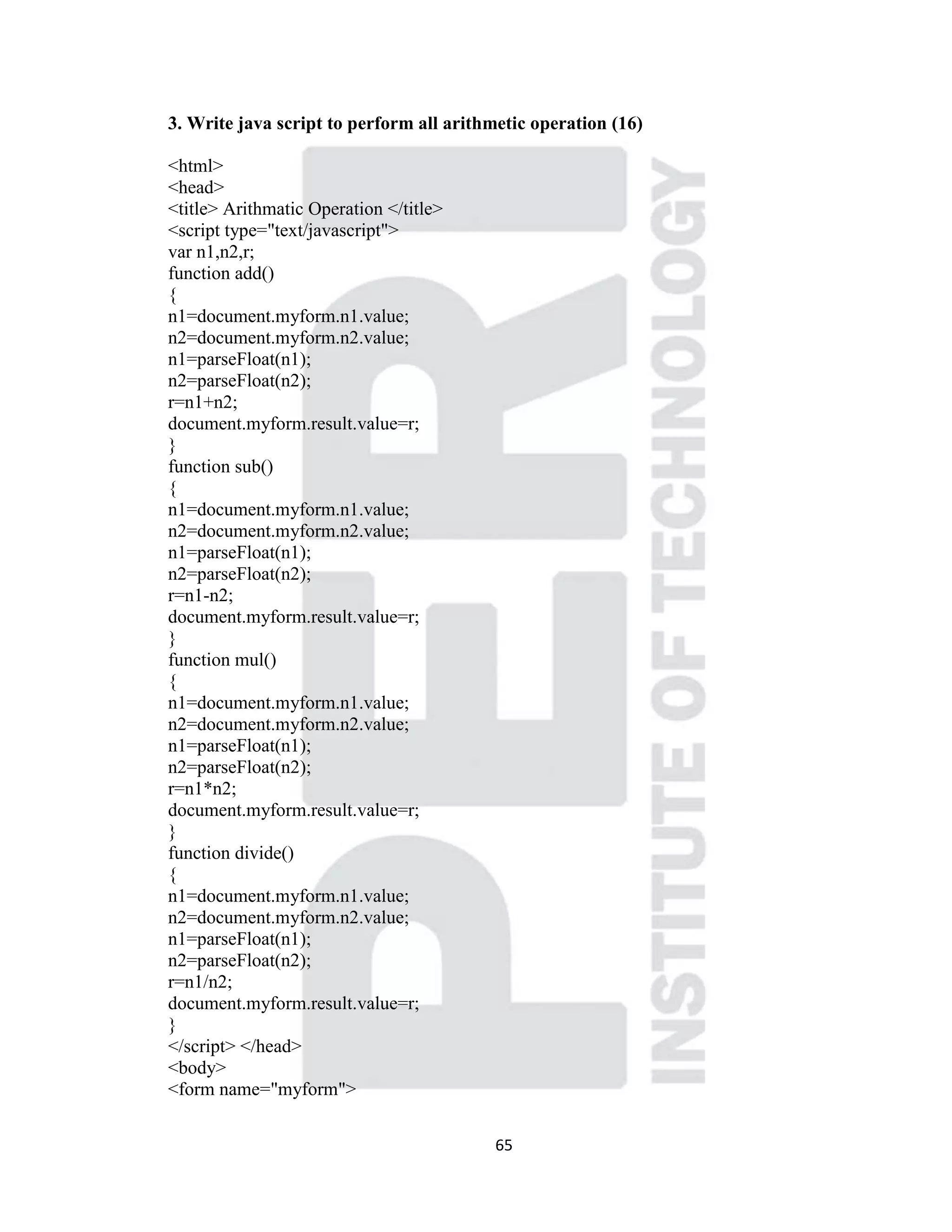
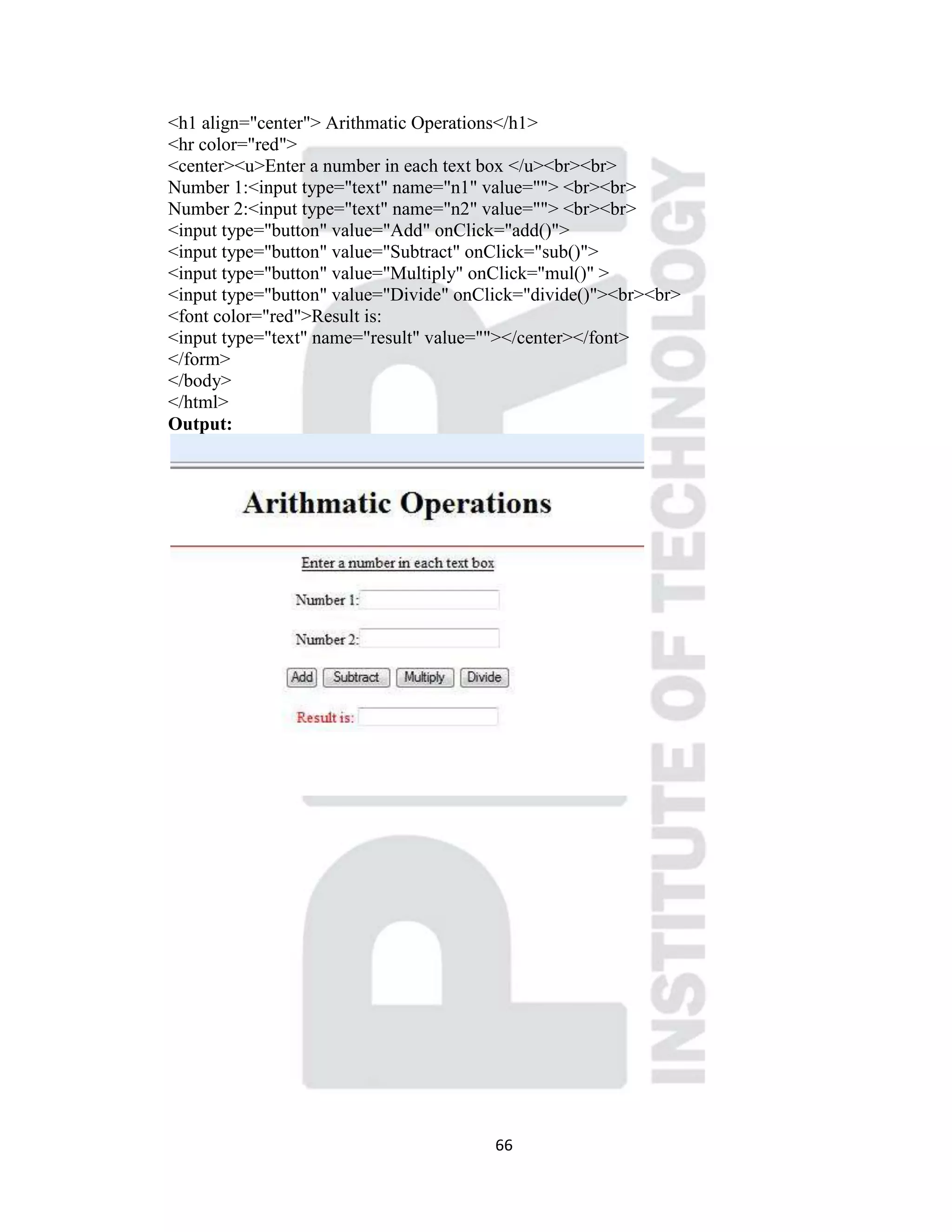
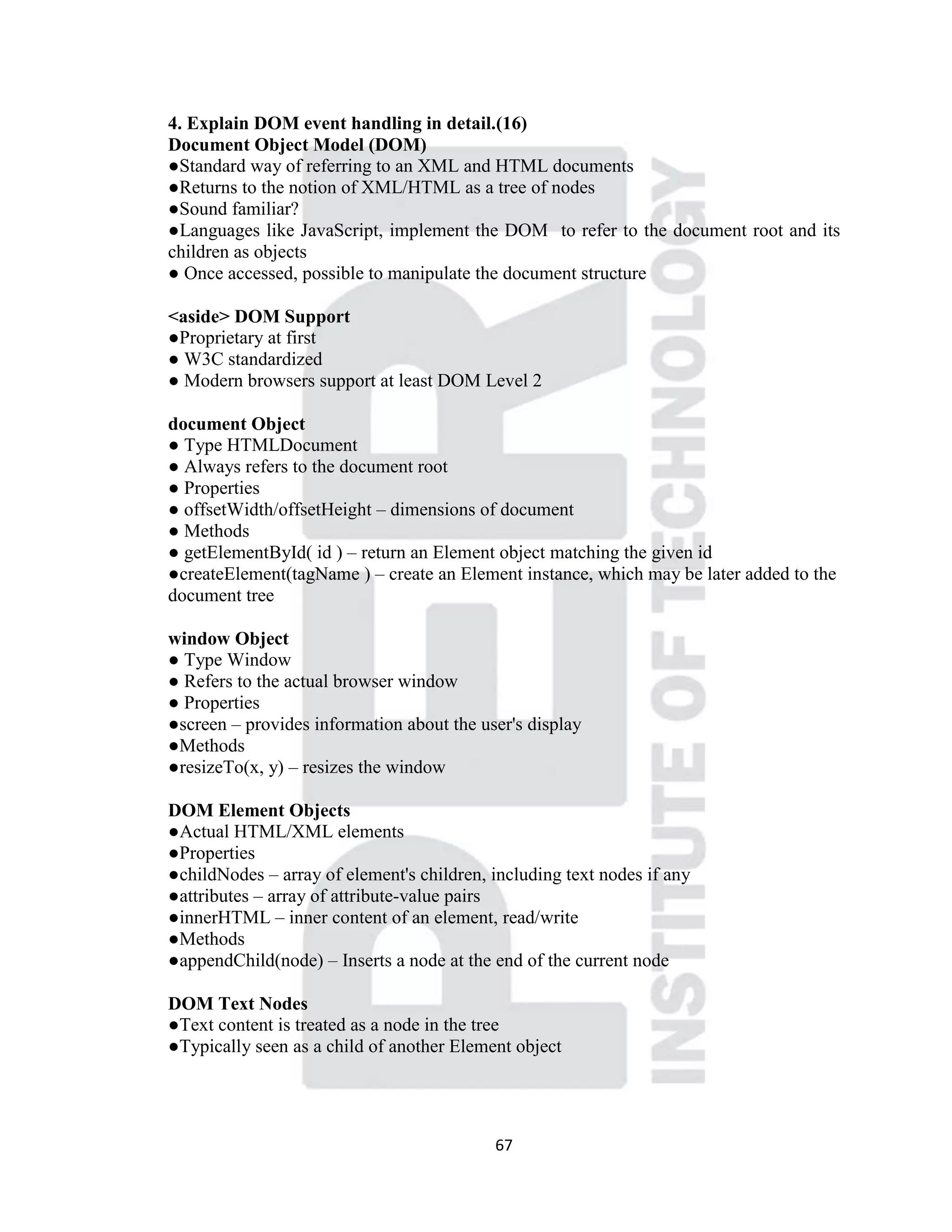
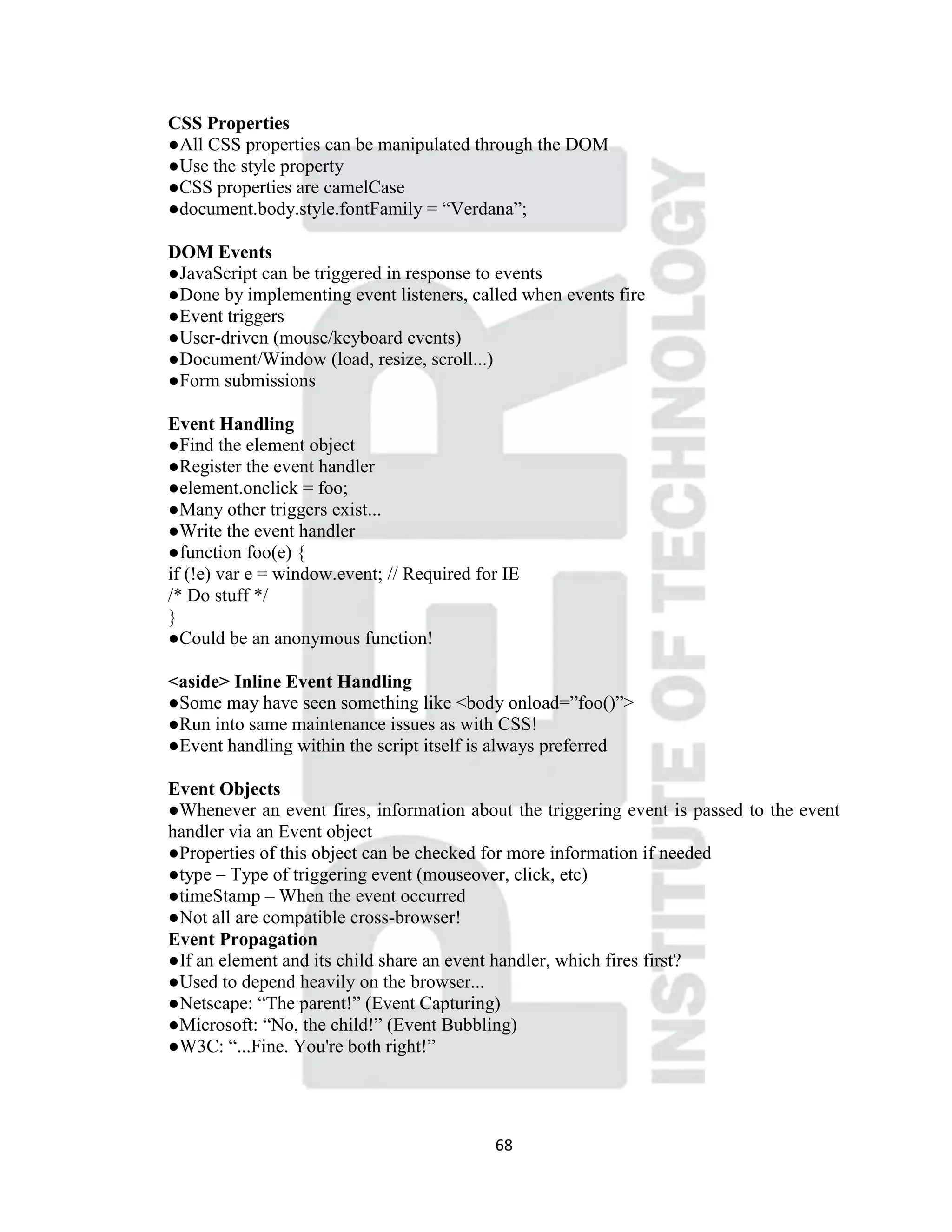



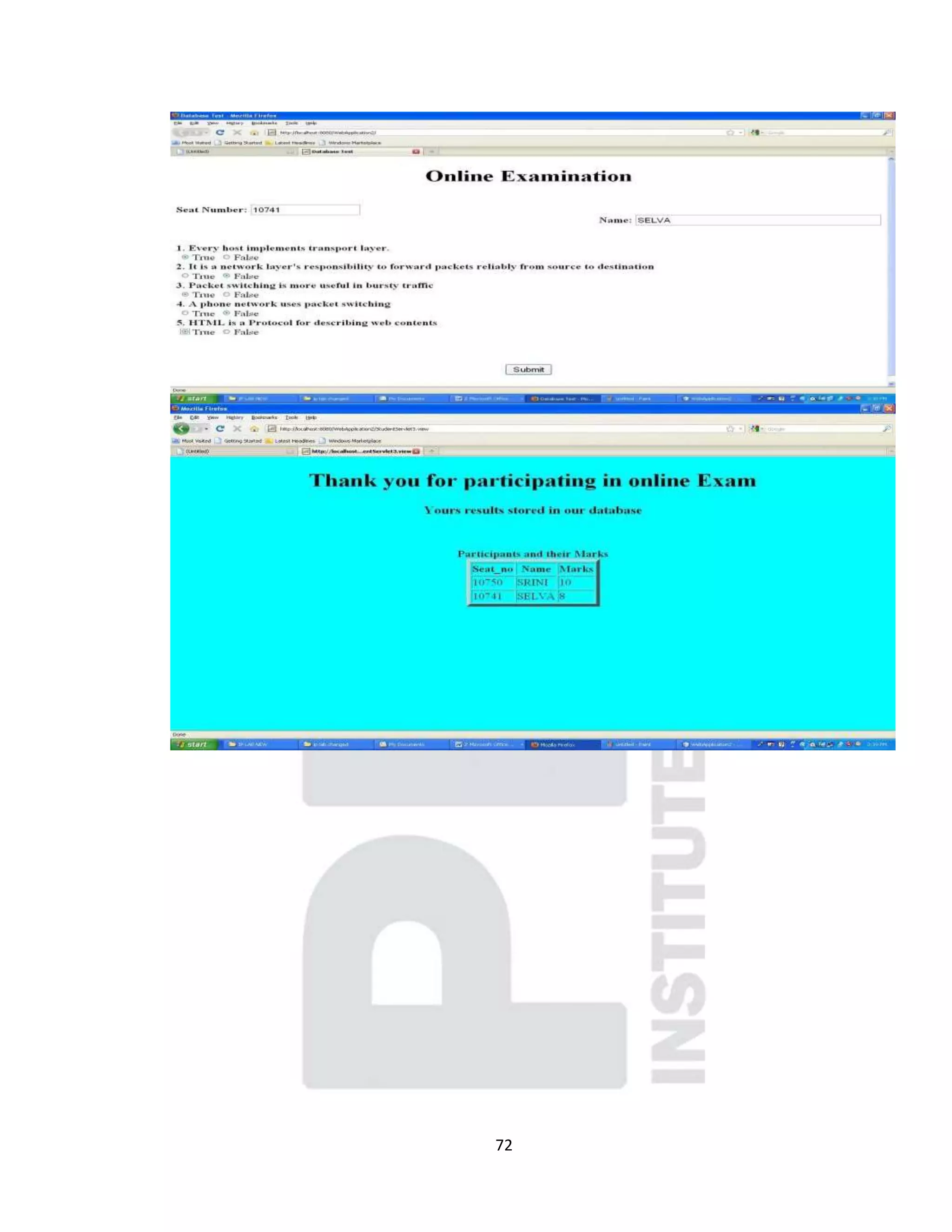


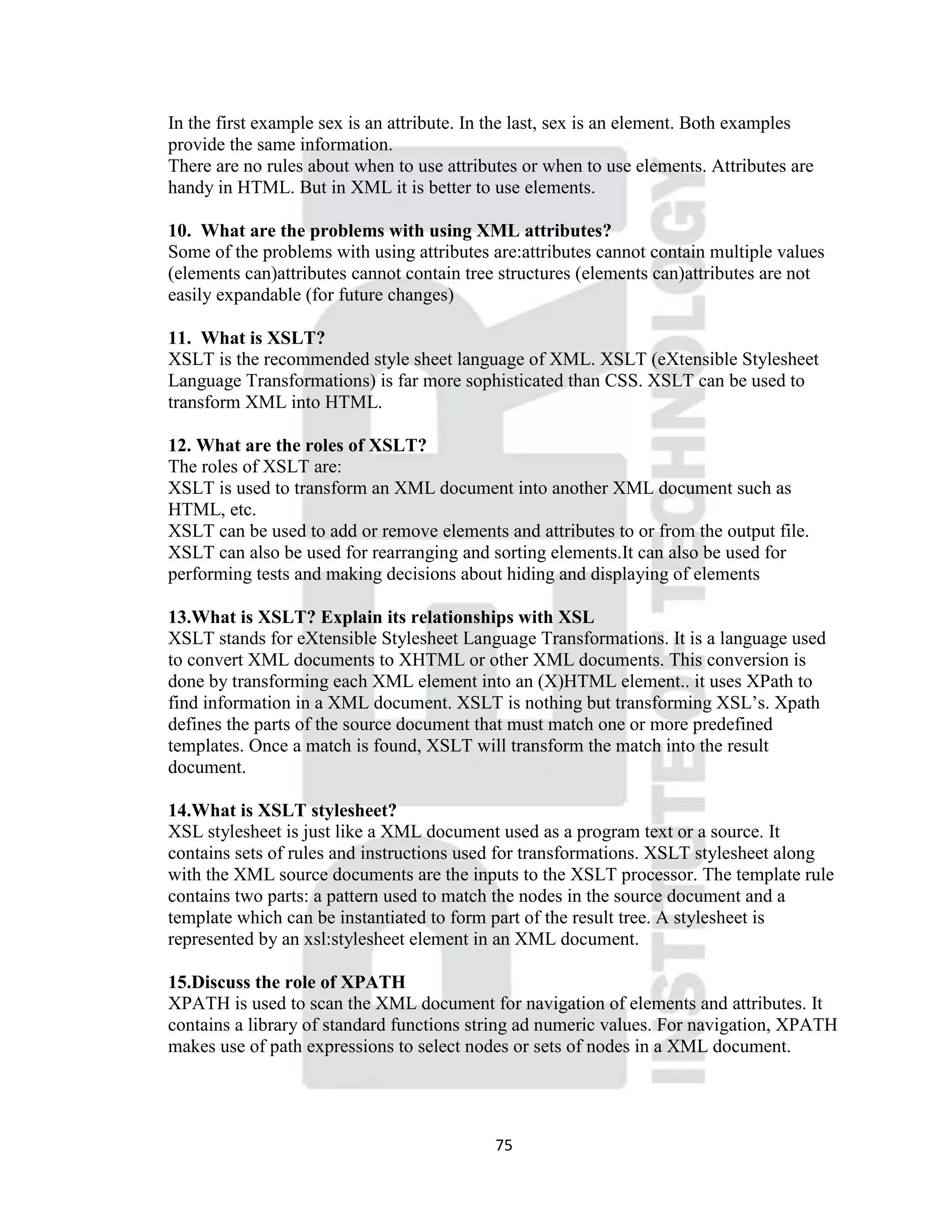
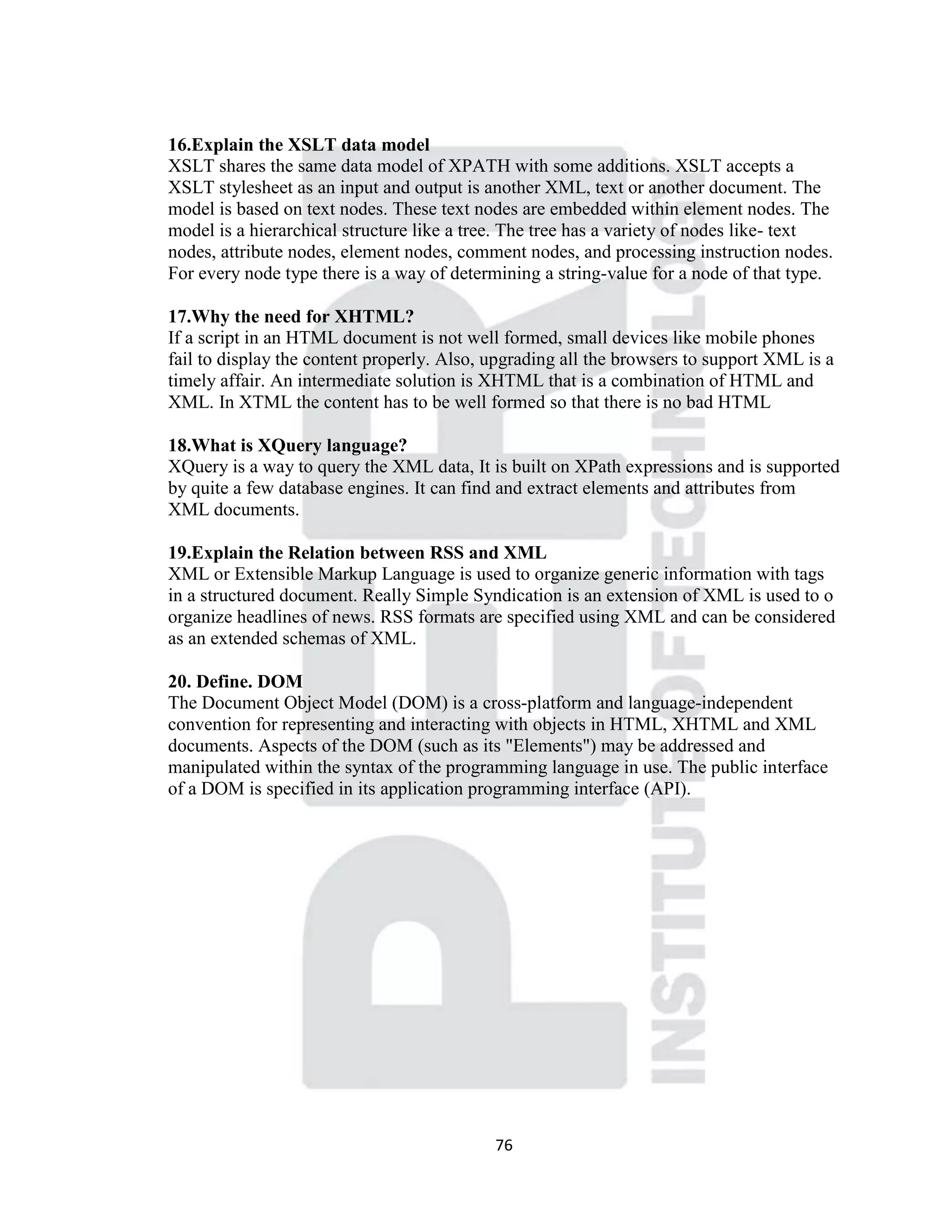

![78 The JAXP is a tool which is used as XSLT processor. The XSLT processor receives xslt and xml program as its input and generates another xml program as its output where we can see the content retrieved from source xml program You can refer lab experiment also Example for XSLT Step 1. Create an XML file and save as The code for the emp.xml file is given below: <?xml version = "1.0" ? > <Employee-Detail> <Employee> <Emp_Id> E-001 </Emp_Id> <Emp_Name> Nisha </Emp_Name> <Emp_E-mail> Nisha1@yahoo.com </Emp_E-mail> </Employee> <Employee> <Emp_Id> E-002 </Emp_Id> <Emp_Name> Amit</Emp_Name> <Emp_E-mail> Amit2@yahoo.com </Emp_E-mail> </Employee> </Employee-Detail> Step 2: Create an XSLT Stylesheetand save as myXSL.xsl extension <?xml version="1.0" ?> <xsl:transform xmlns:xsl="http://www.w3.org/1999/XSL/Transform" version="1.0"> <xsl:template match="/"> <html><head><title> XSL for Transforamtion </title> <body><p> <xsl:for-each select="Employee"> <xsl:value-of select="child::Emp_Id"/> <xsl:value-of select="child::Emp_Name"/> <xsl:value-of select="child::Emp_E-mail"/> </xsl:for-each> </p></body></html> </xsl:template> </xsl:stylesheet> Step 3: Create XML Transformer program in java and give input both .xml and .xsl file import javax.xml.transform.Transformer; import javax.xml.transform.TransformerFactory; import javax.xml.transform.stream.StreamSource; import javax.xml.transform.stream.StreamResult; import javax.xml.transform.Source; import javax.xml.transform.Result; import javax.xml.transform.OutputKeys; public class XMLwithXSLT { public static void main(String[] args) throws Exception { Sourcesource= new StreamSource("myXML.xml"); Source xsl= new StreamSource("myXSL.xsl");](https://image.slidesharecdn.com/internetprogramming-cs6501-iiiyearcseanswerkey-161020051409/75/CS6501-Internet-programming-78-2048.jpg)
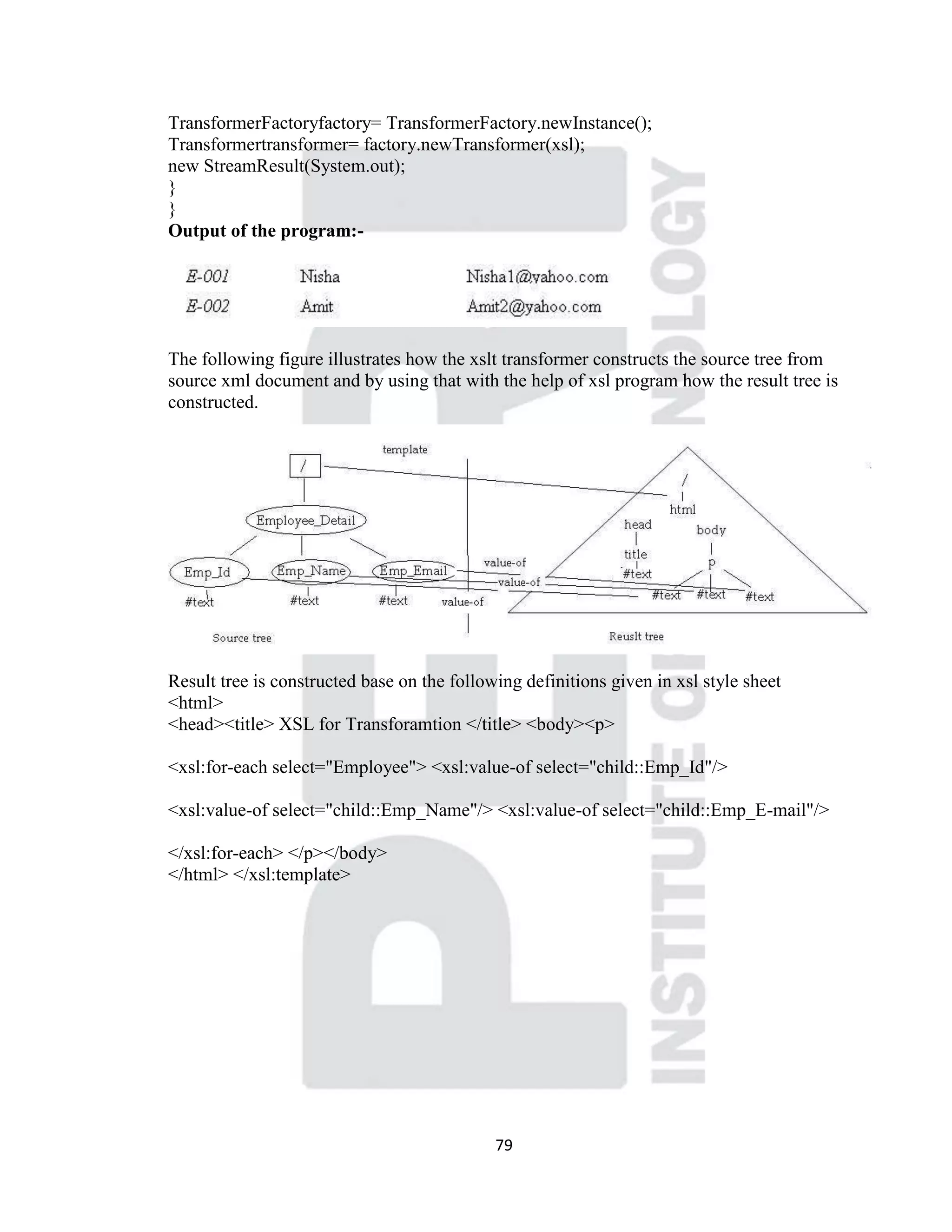
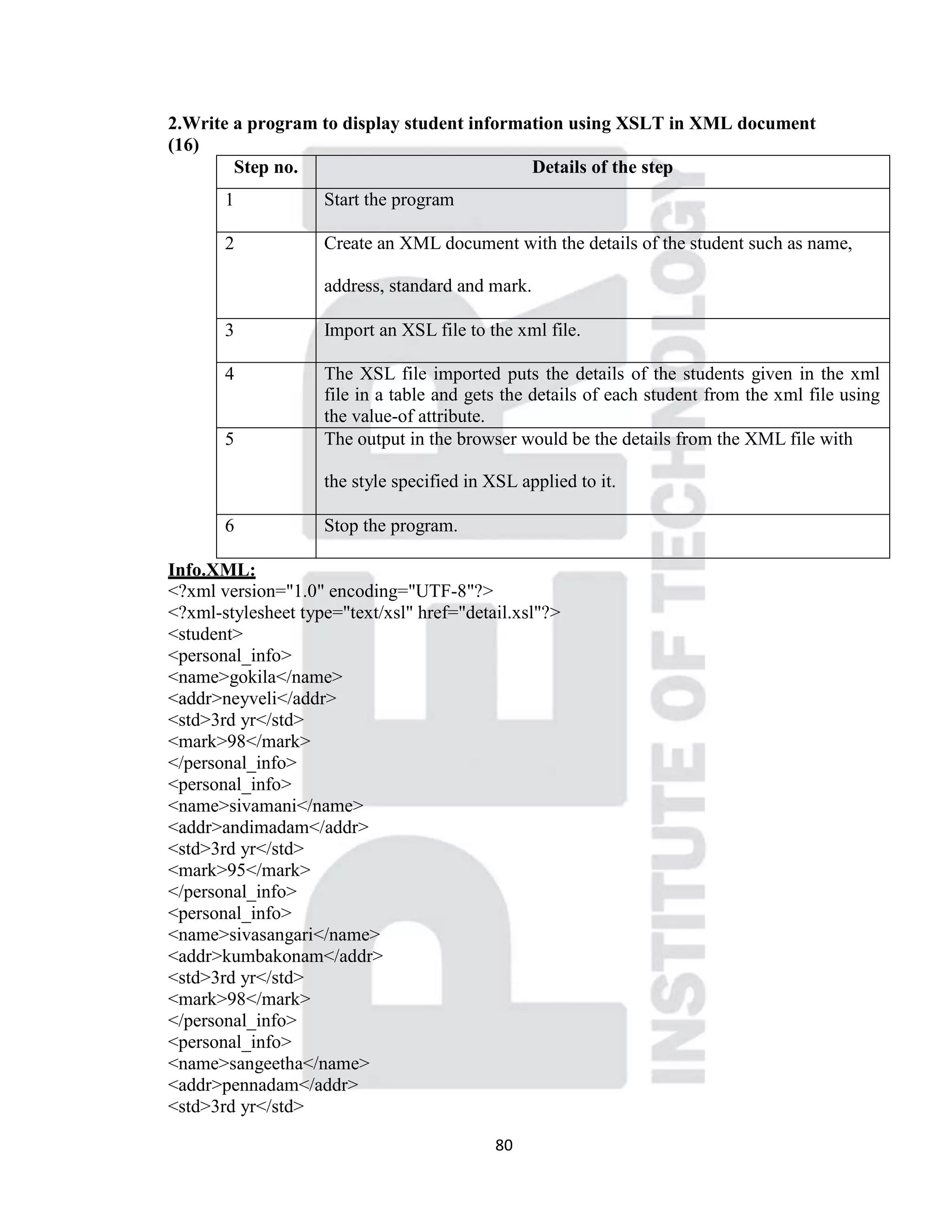
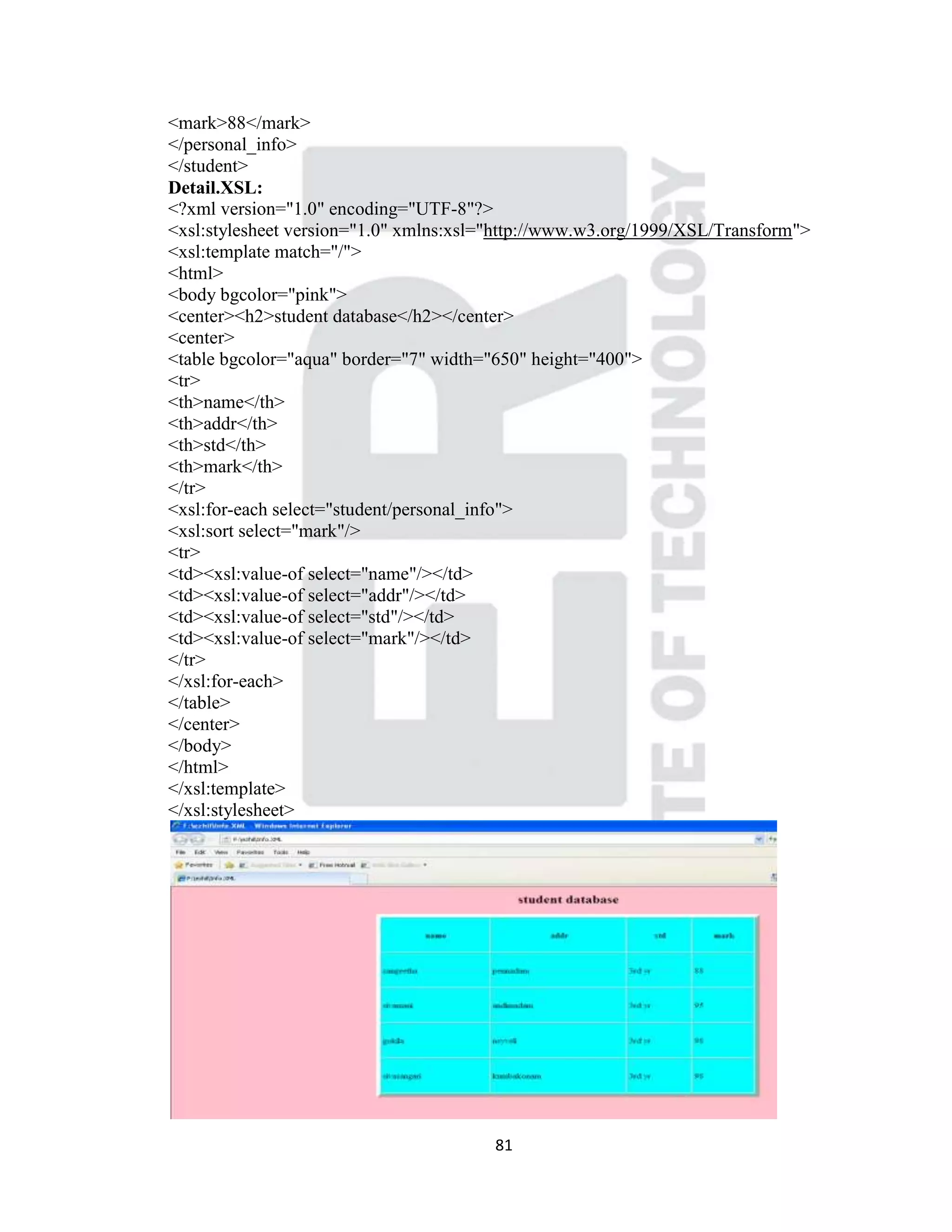
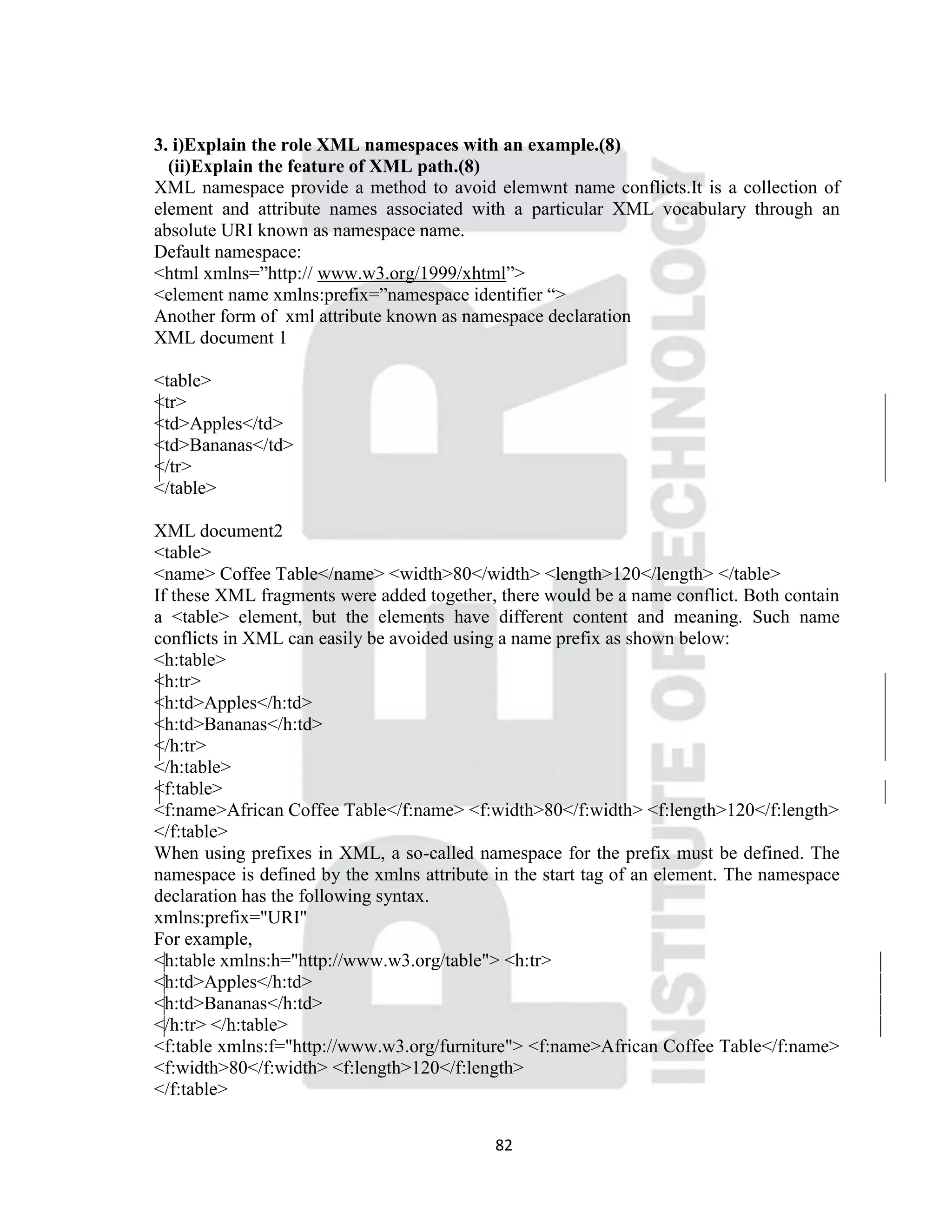
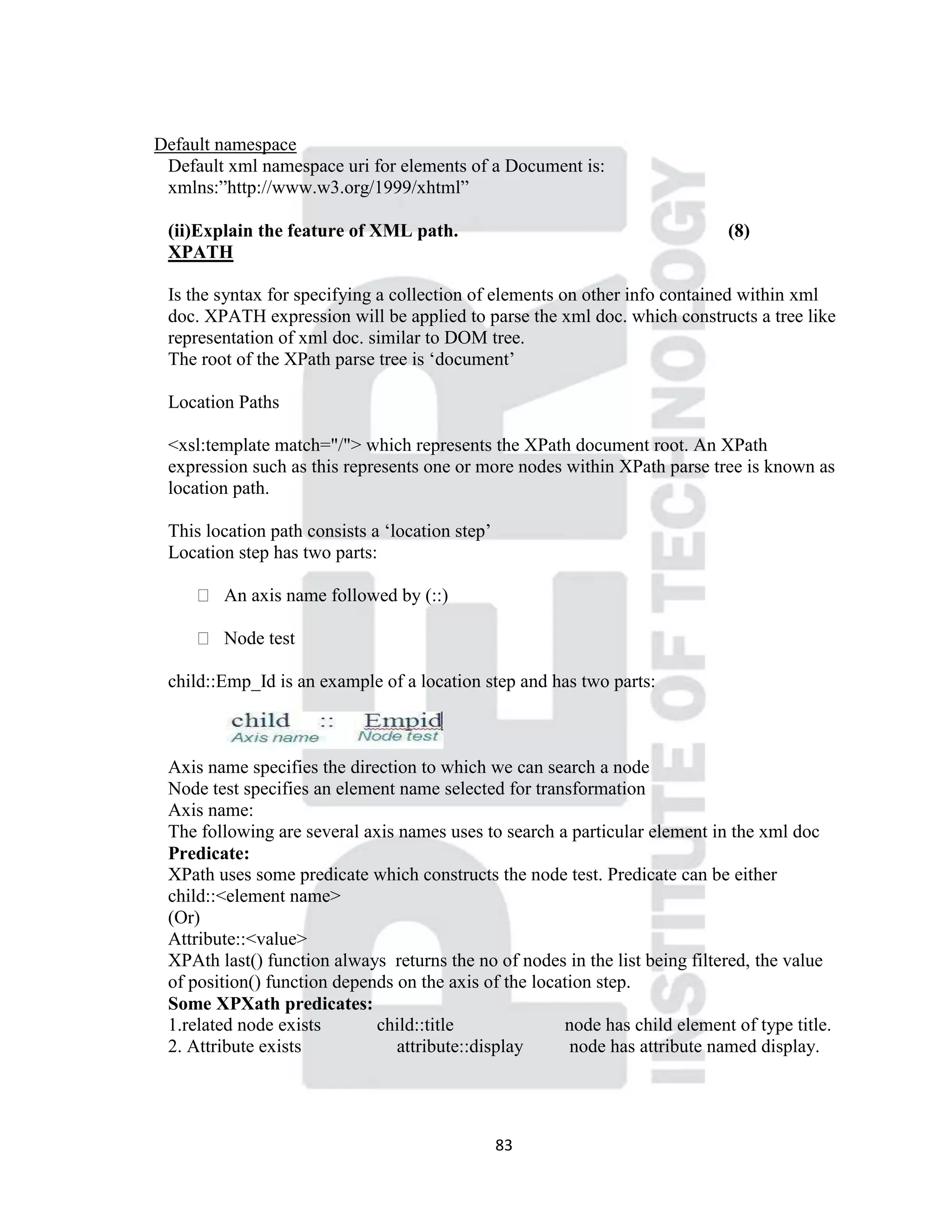

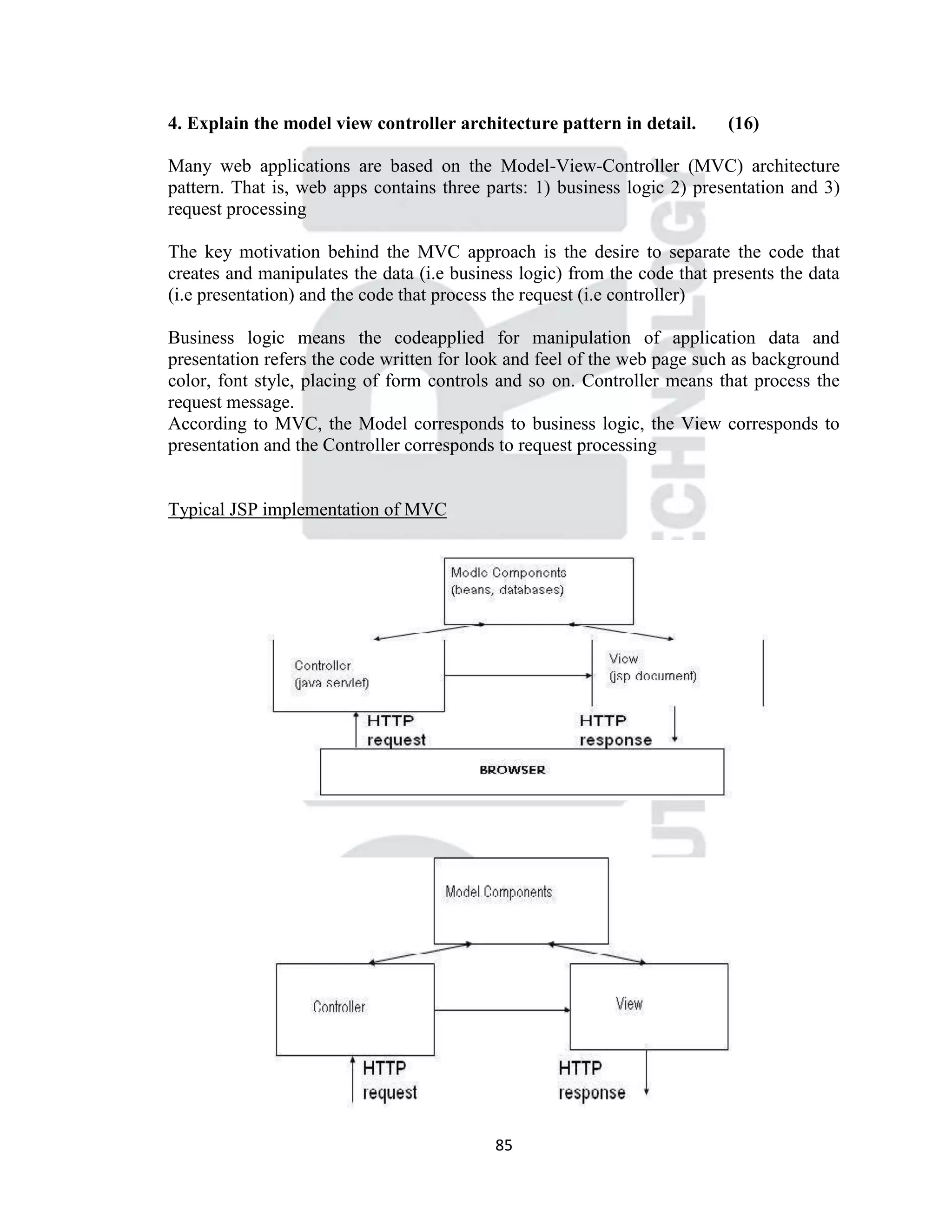
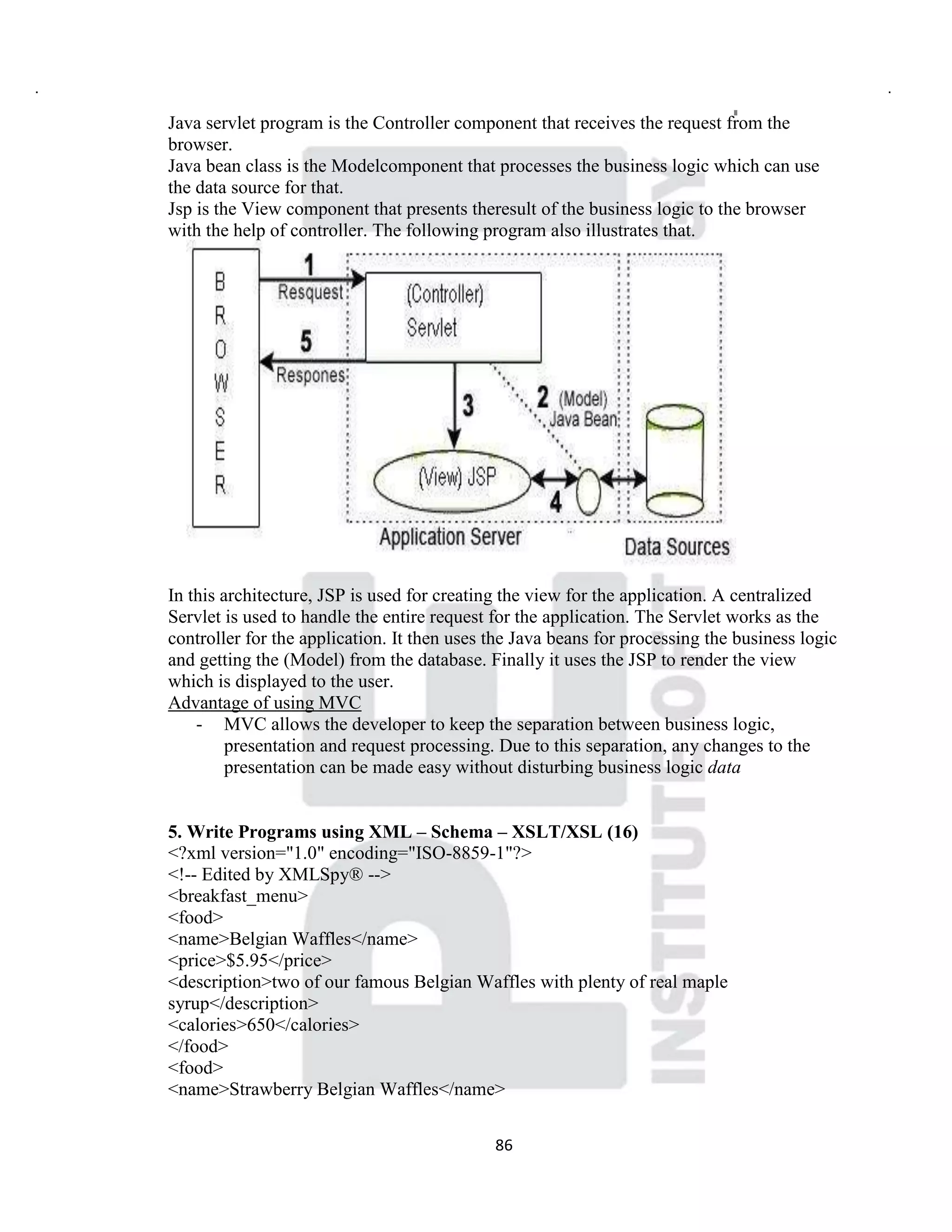

![88 UNIT V – INTRODUCTION TO AJAX and WEB SERVICES PART –A 1. What is DTD? Explain it with example. The purpose of a DTD (Document Type Definition) is to define the legal building blocks of an XML document. A DTD is a set of rules that specifies how to use XML markup. It contains Specifications. For each element, including what the element's attributes are, what values the attributes ca take on and what elements can be contained in others. A DTD defines the document structure with a list of legal elements and attributes. If the DTD is declared inside the XML file, it should be wrapped in a DOCTYPE definition with the following syntax: <!DOCTYPE root-element [element-declarations]> With a DTD, each of your XML files can carry a description of its own format. With a DTD, independent groups of people can agree to use a standard DTD for interchanging data. Your application can use a standard DTD to verify that the data you receive from the outside world is valid. You can also use a DTD to verify your own data. 2. What is AJAX? Ajax shorthand for Asynchronous JavaScript and XML) is a group of interrelated web development methods used on the client-side to create interactive web applications. With Ajax, web applications can retrieve data from the server asynchronously in the ackground without interfering with the display and behavior of the existing page. Data is usually retrieved using the XMLHttpRequest object. 3.What is a web service? Many people and companies have debated the exact definition of Web services. At a minimum, however, a Web service is any piece of software that makes itself available over the Internet and uses a standardized XML messaging system. XML is used to encode all communications to a Web service. 4.What is SOAP? SOAP is an XML-based protocol for exchanging information between computers. Although SOAP can be used in a variety of messaging systems and can be delivered via a variety of transport protocols, the main focus of SOAP is Remote Procedure Calls (RPC) transported via HTTP. Like XML-RPC, SOAP is platform independent, and therefore enables diverse applications to communicate with one another. 5. What is SOAP and how it will be utilized in web-components? SOAP stands for Simple Access protocol. SOAP was first offered in 1990's and has been introduced to W3C in 2000. The main purpose of SOAP to be able to send request to invoke programs on remote computers using XML wrappers.](https://image.slidesharecdn.com/internetprogramming-cs6501-iiiyearcseanswerkey-161020051409/75/CS6501-Internet-programming-88-2048.jpg)
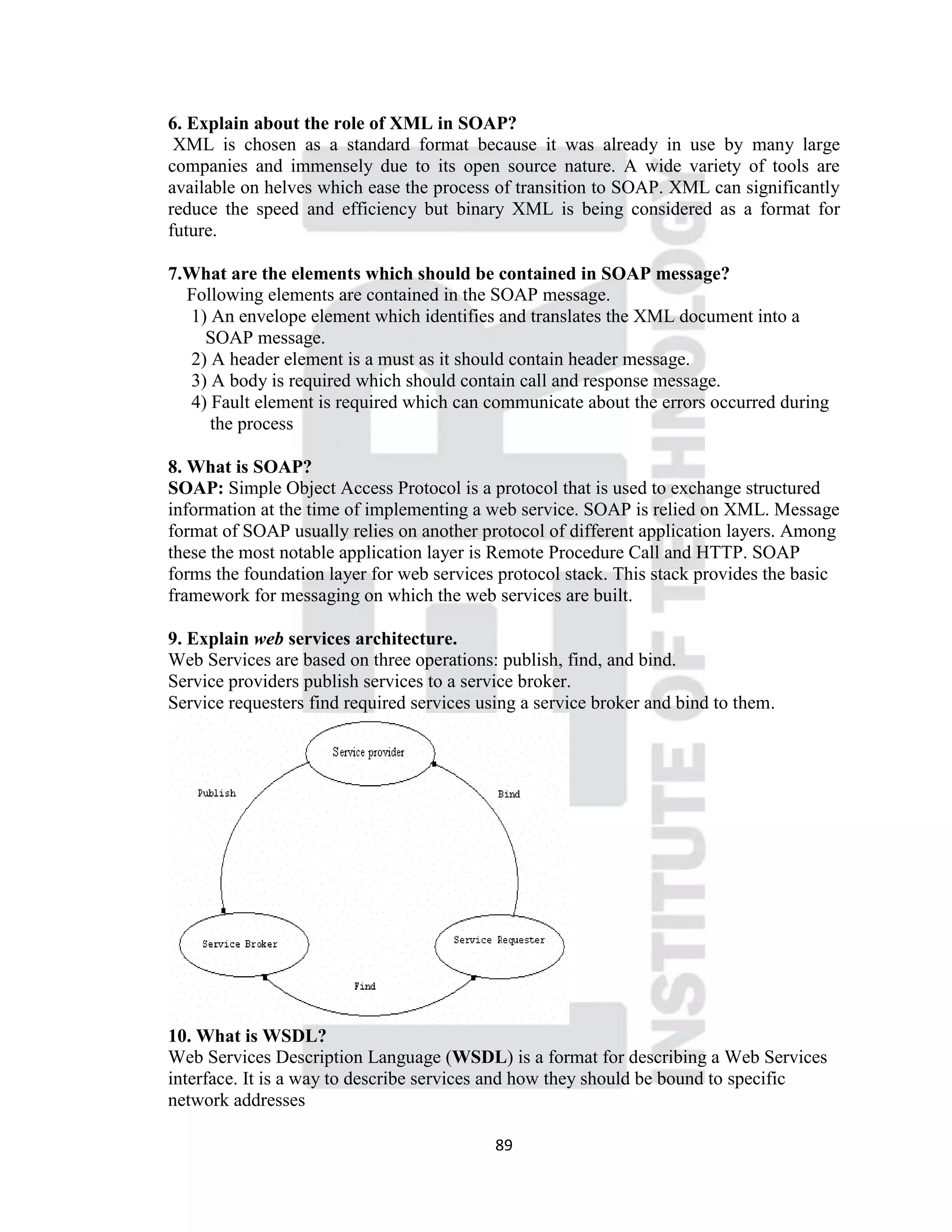

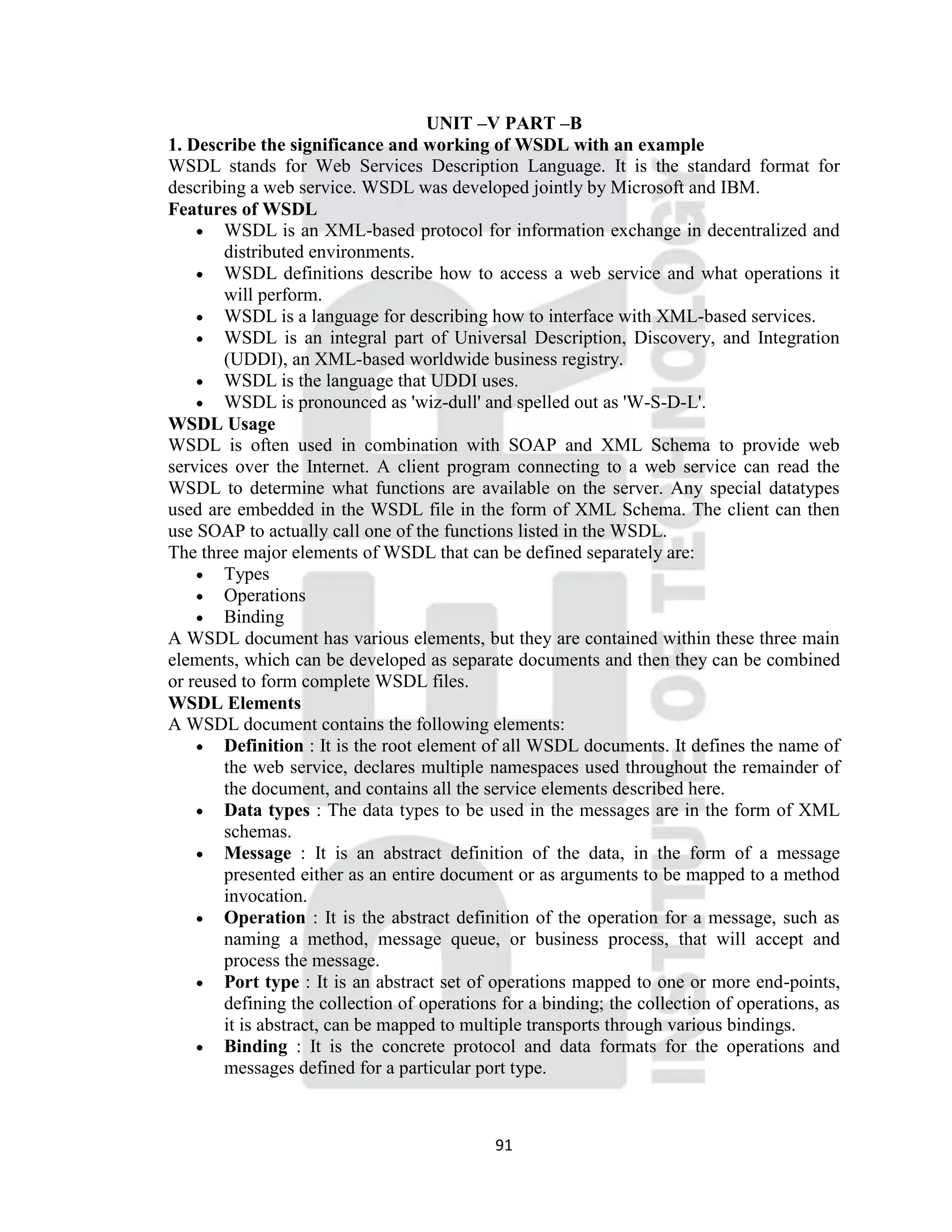
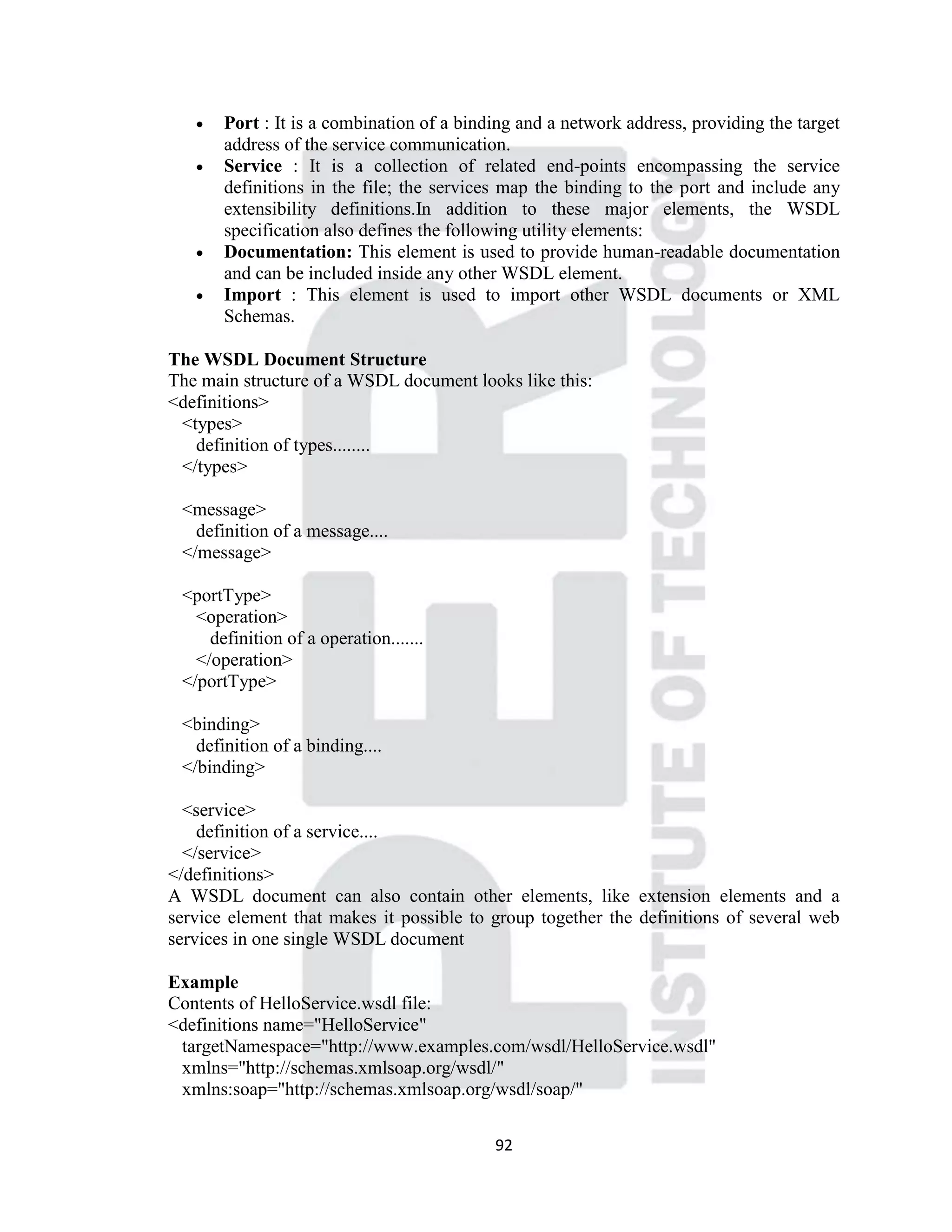
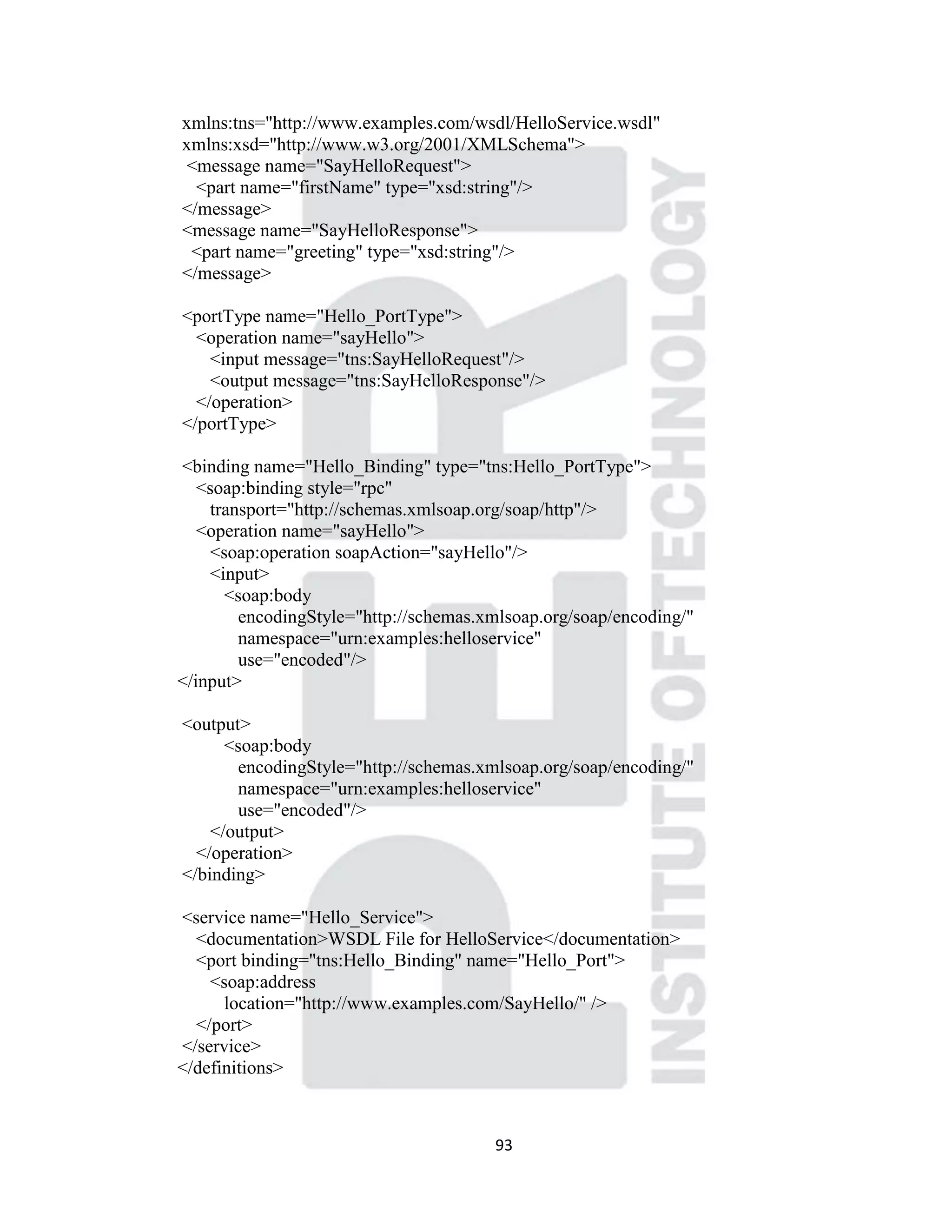
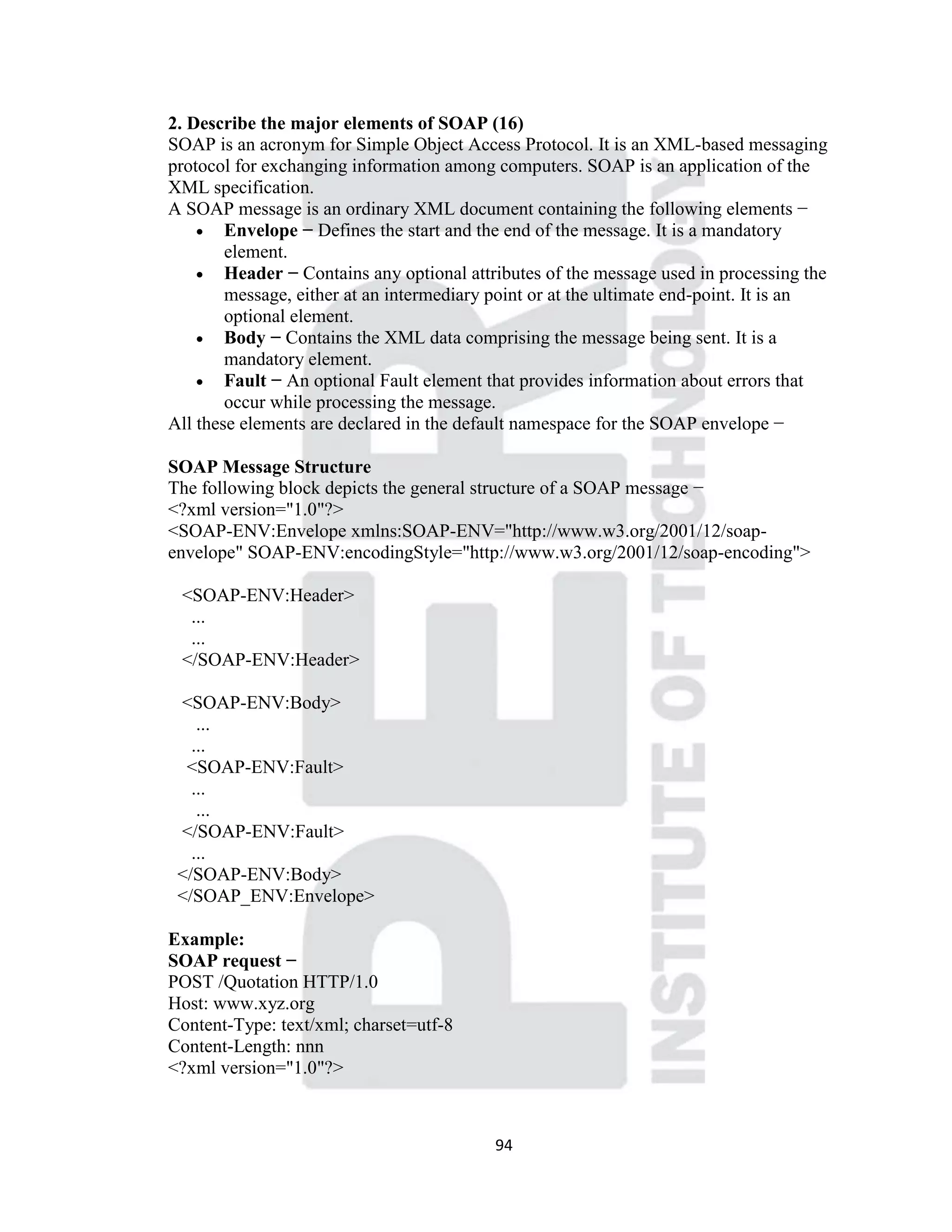
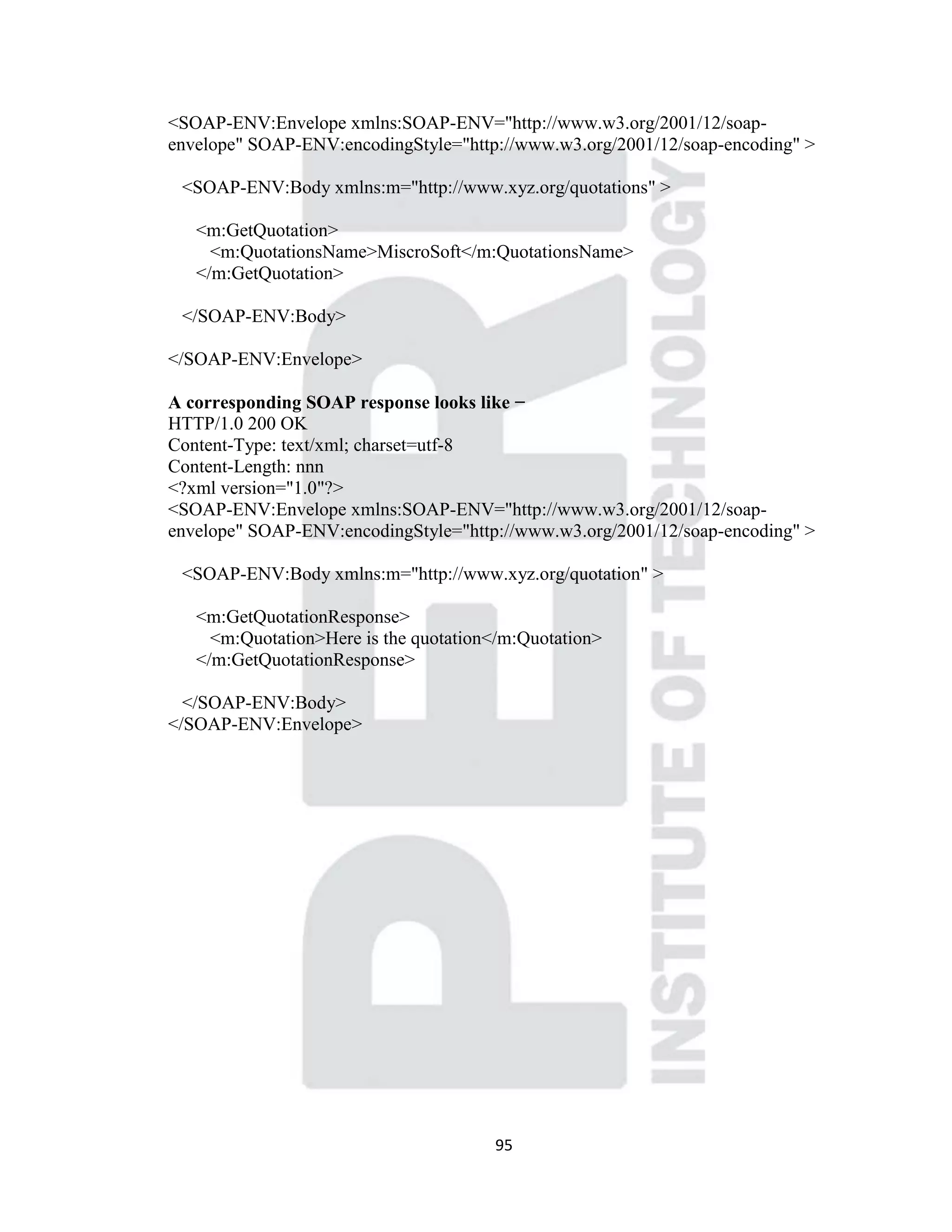
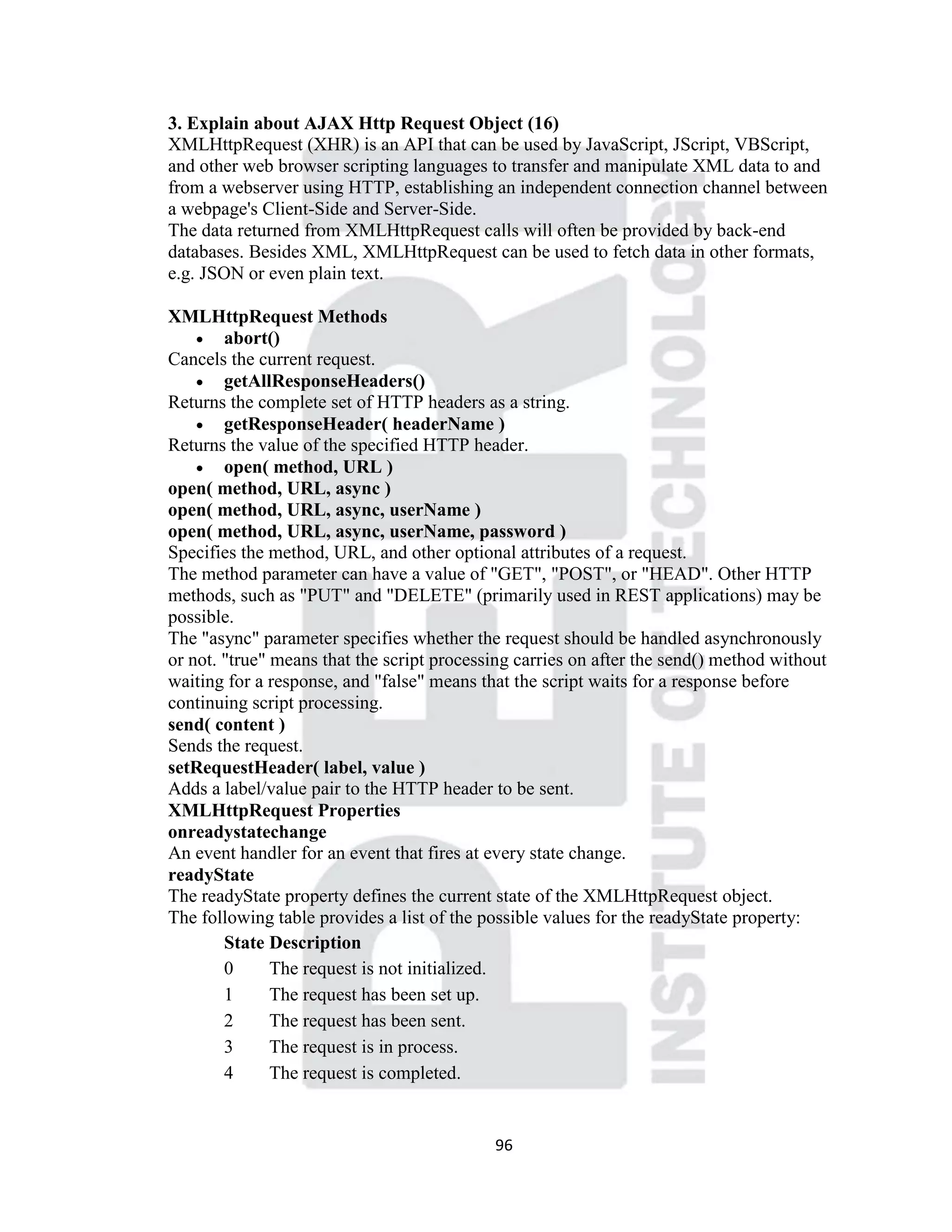
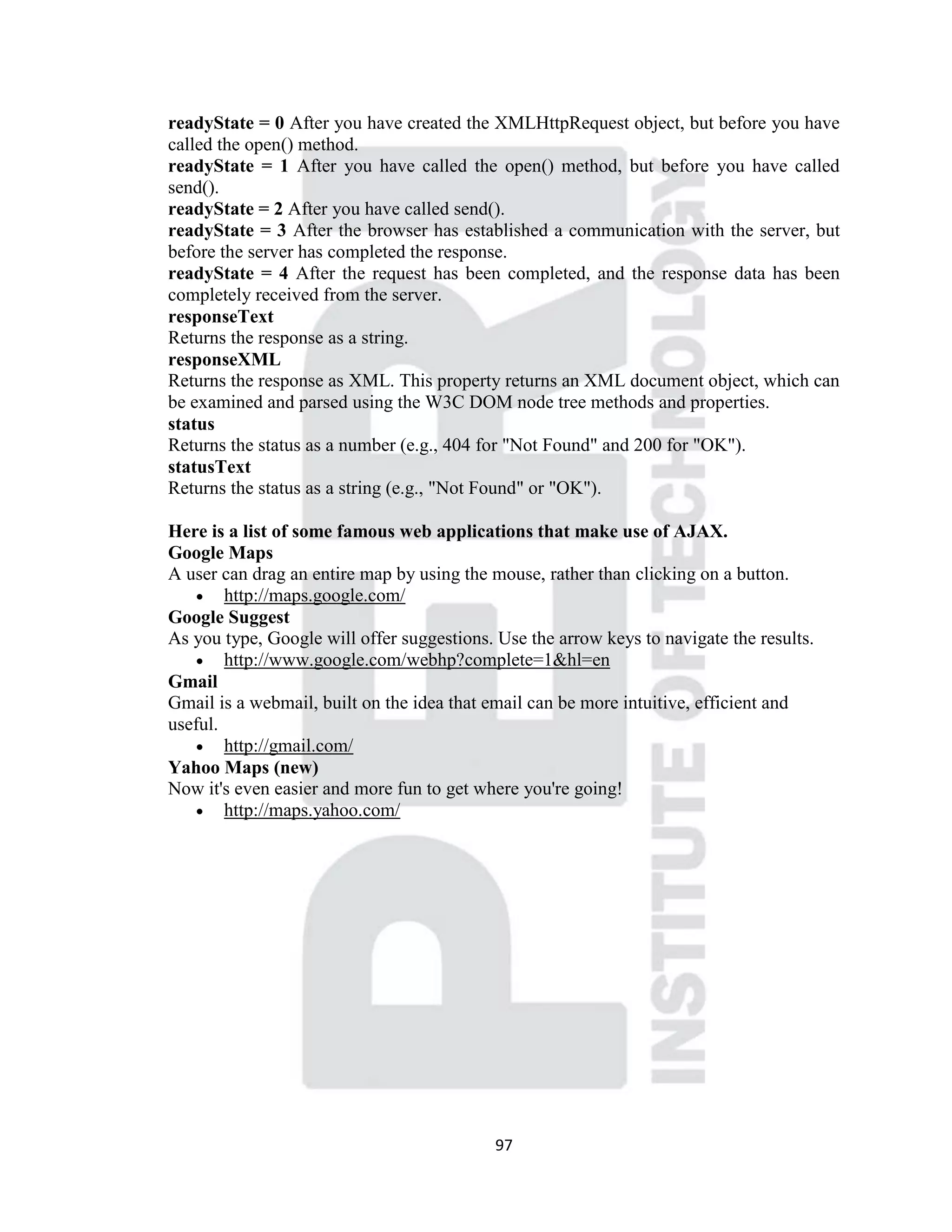

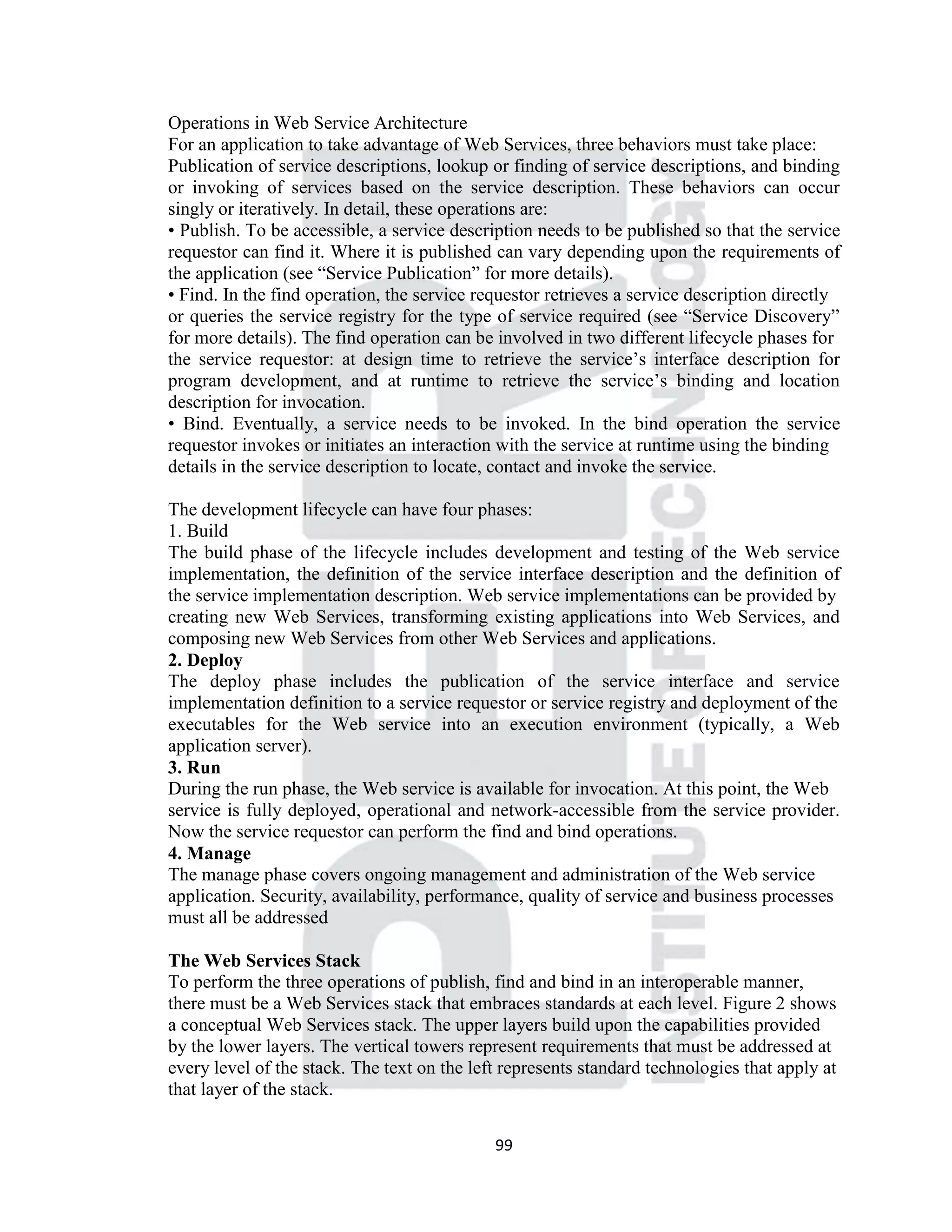
![100 5. Write a program to run and implement the web service (16) NewWebService.java: /*To change this template, choose Tools | Templates and open the template in the editor. */ package pack1; import javax.jws.WebService; import javax.jws.WebMethod; import javax.jws.WebParam; import java.sql.*; /***@author SREC*/ @WebService() public class NewWebService { @WebMethod (operationName="get") public String[] get(@WebParam(name="from")String from,@WebParam (name="to")String to) { String hello[]=new String[6]; int i=0; try { Class.forName("sun.jdbc.odbc.JdbcOdbcDriver"); String filename = "d:/data1.mdb"; String database = "jdbc:odbc:Driver={Microsoft Access Driver (*.mdb)};DBQ="; database+= filename.trim() + ";DriverID=22;READONLY=true}"; Connection con = DriverManager.getConnection( database ,"",""); Statement s = con.createStatement(); s.execute("select * from details "); ResultSet rs = s.getResultSet(); if (rs != null) while ( rs.next() ) {](https://image.slidesharecdn.com/internetprogramming-cs6501-iiiyearcseanswerkey-161020051409/75/CS6501-Internet-programming-100-2048.jpg)
![101 hello[i]= rs.getString("name"); i++; hello[i]= rs.getString("date"); i++; } } catch (Exception e) { System.out.println("Error: " + e); } return hello; }} Index.jsp: <%@page contentType="text/html" pageEncoding="UTF-8"%> <!DOCTYPE HTML PUBLIC "-//W3C//DTD HTML 4.01 Transitional//EN" "http://www.w3.org/TR/html4/loose.dtd"> <html> <head> <meta http-equiv="Content-Type" content="text/html; charset=UTF-8"> <title>JSP Page</title> </head> <body> <h1>Hello World!</h1> <form name="air" action="action.jsp" method="post"> From<input type="text" name="from" id="from"><br/> To<input type="text" name="to" id="to"><br/> <input type="submit" value="GetDtails"> </form> </body> </html> Action.jsp: <%@page contentType="text/html" pageEncoding="UTF-8"%> <!DOCTYPE HTML PUBLIC "-//W3C//DTD HTML 4.01 Transitional//EN" "http://www.w3.org/TR/html4/loose.dtd"> <html> <head> <meta http-equiv="Content-Type" content="text/html; charset=UTF-8"> <title>JSP Page</title> </head> <body> <h1>Hello World!</h1> <% String from1=request.getParameter("from"); String to1=request.getParameter("to"); %> <%-- start web service invocation --%><hr/> <% try {](https://image.slidesharecdn.com/internetprogramming-cs6501-iiiyearcseanswerkey-161020051409/75/CS6501-Internet-programming-101-2048.jpg)


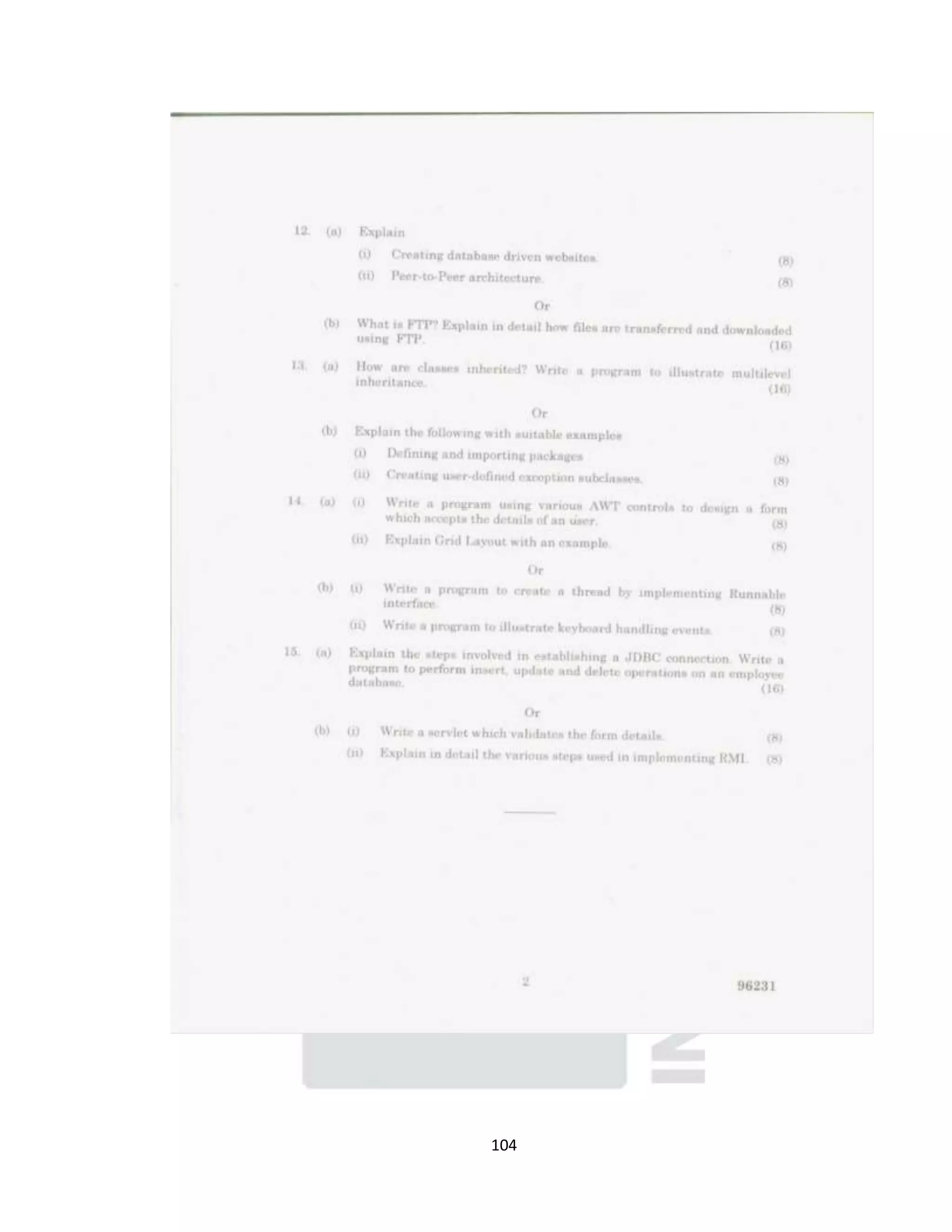
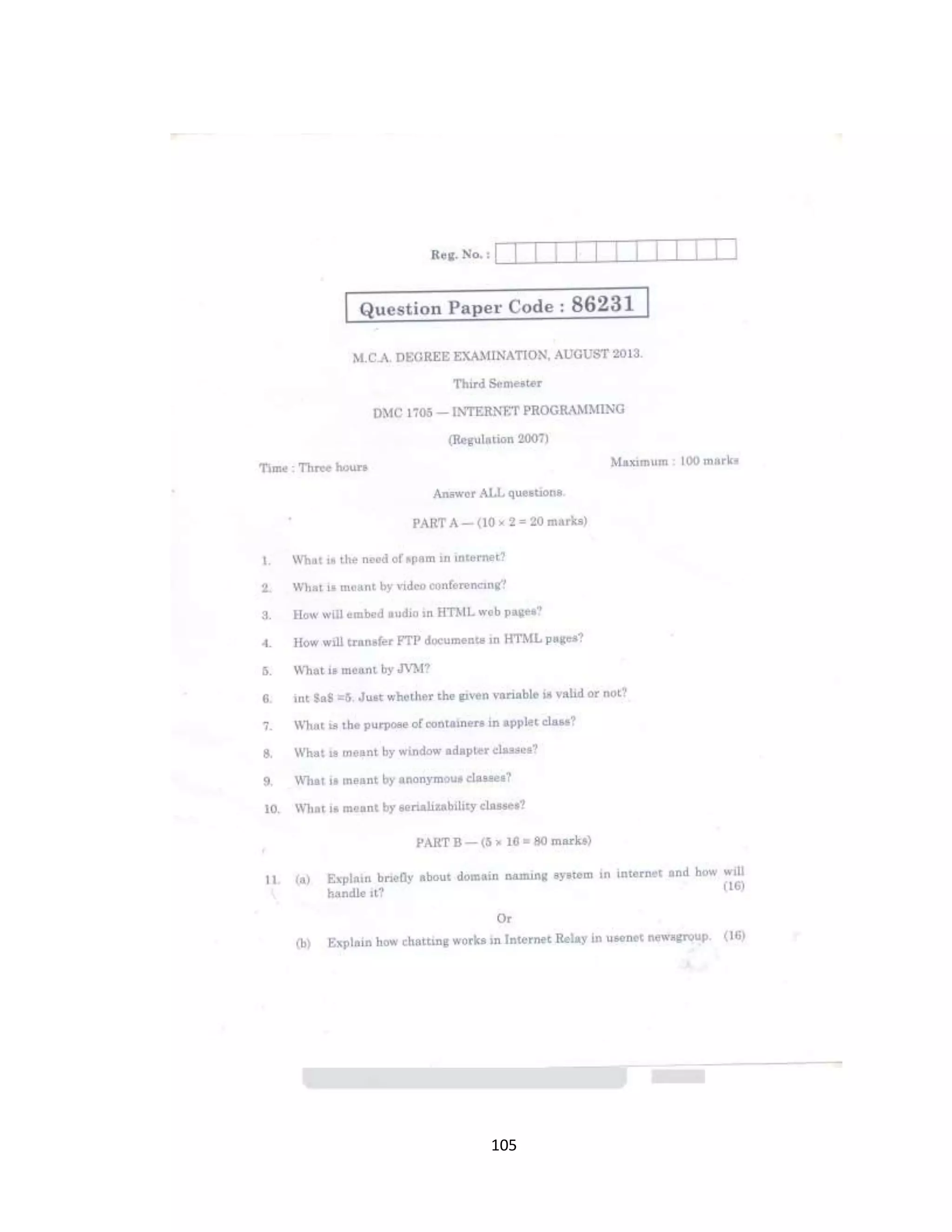
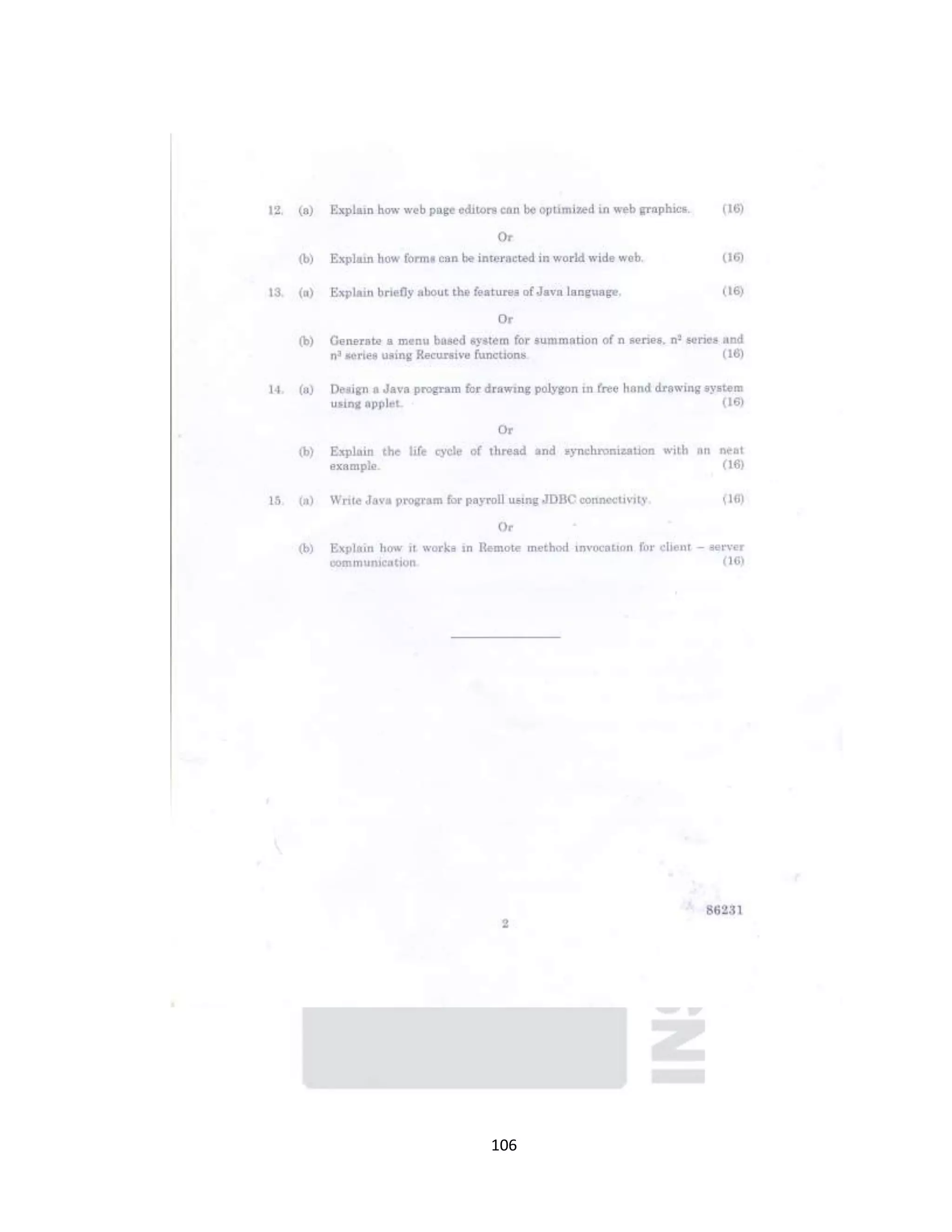
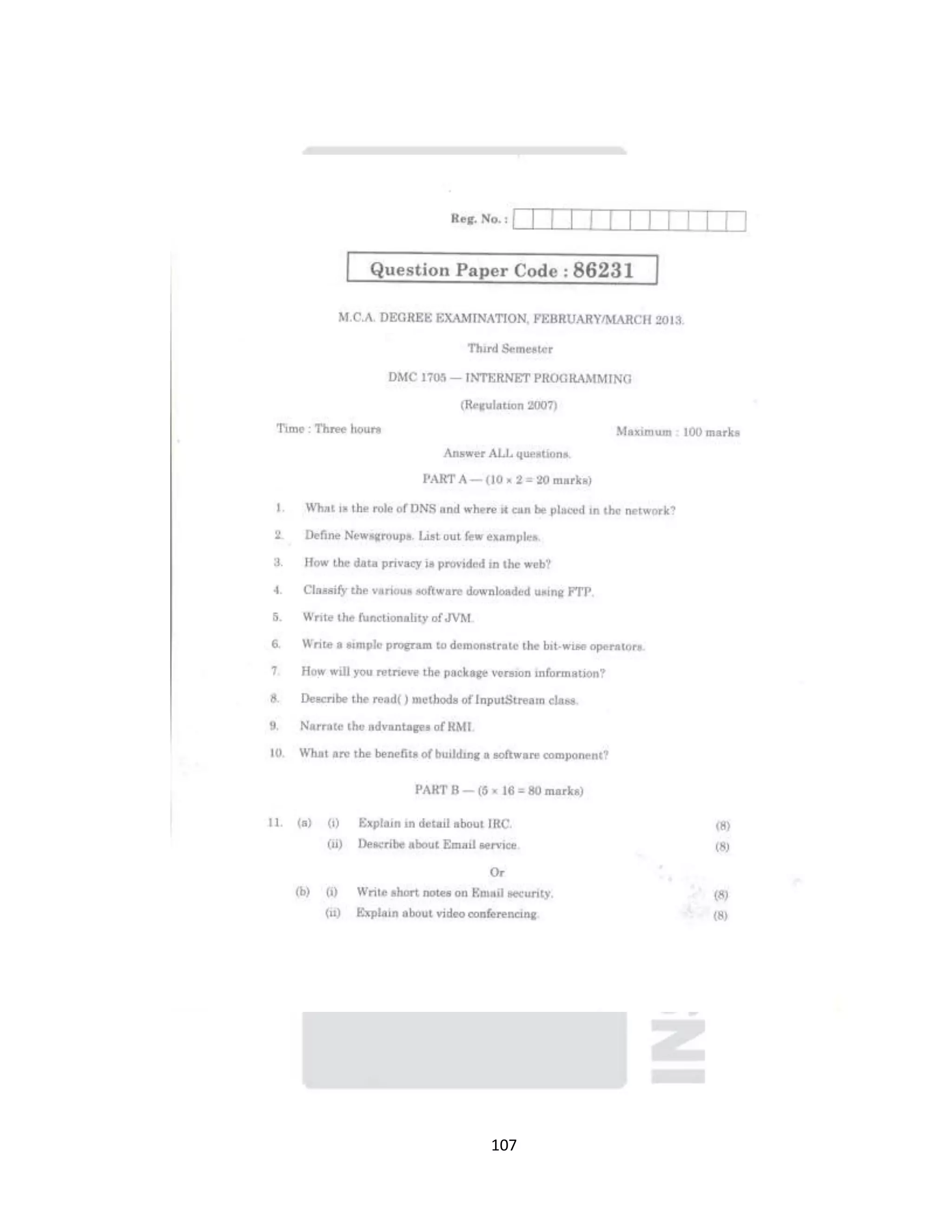
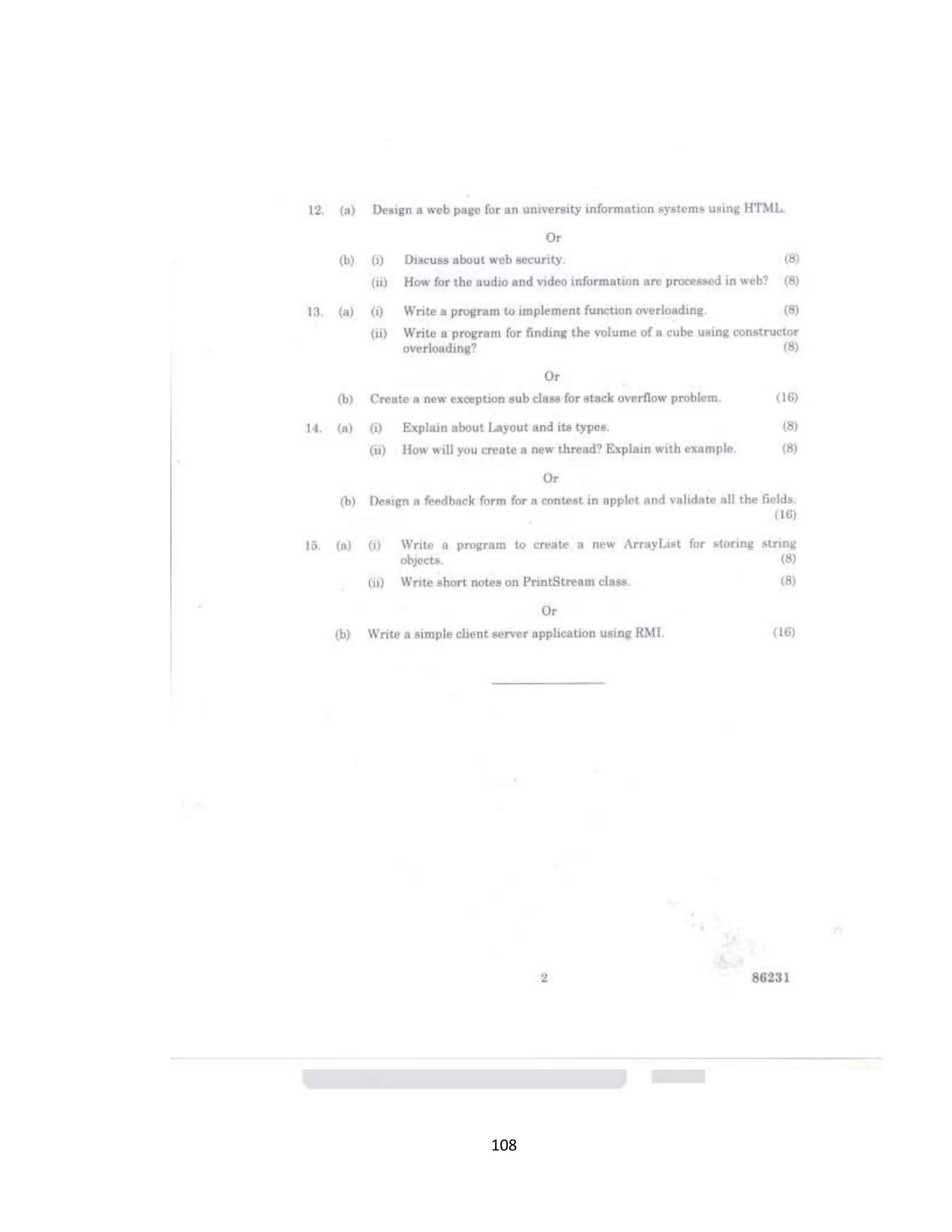
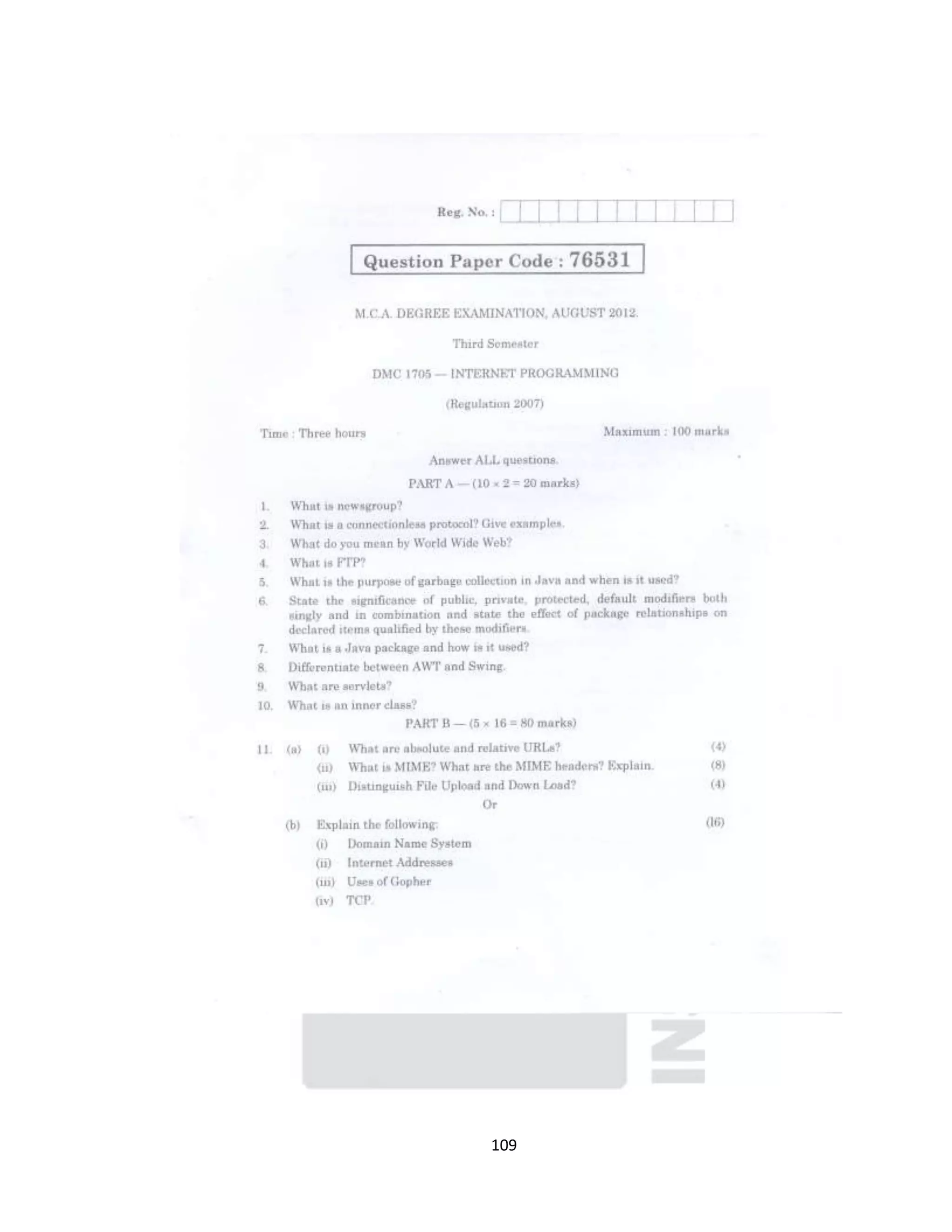

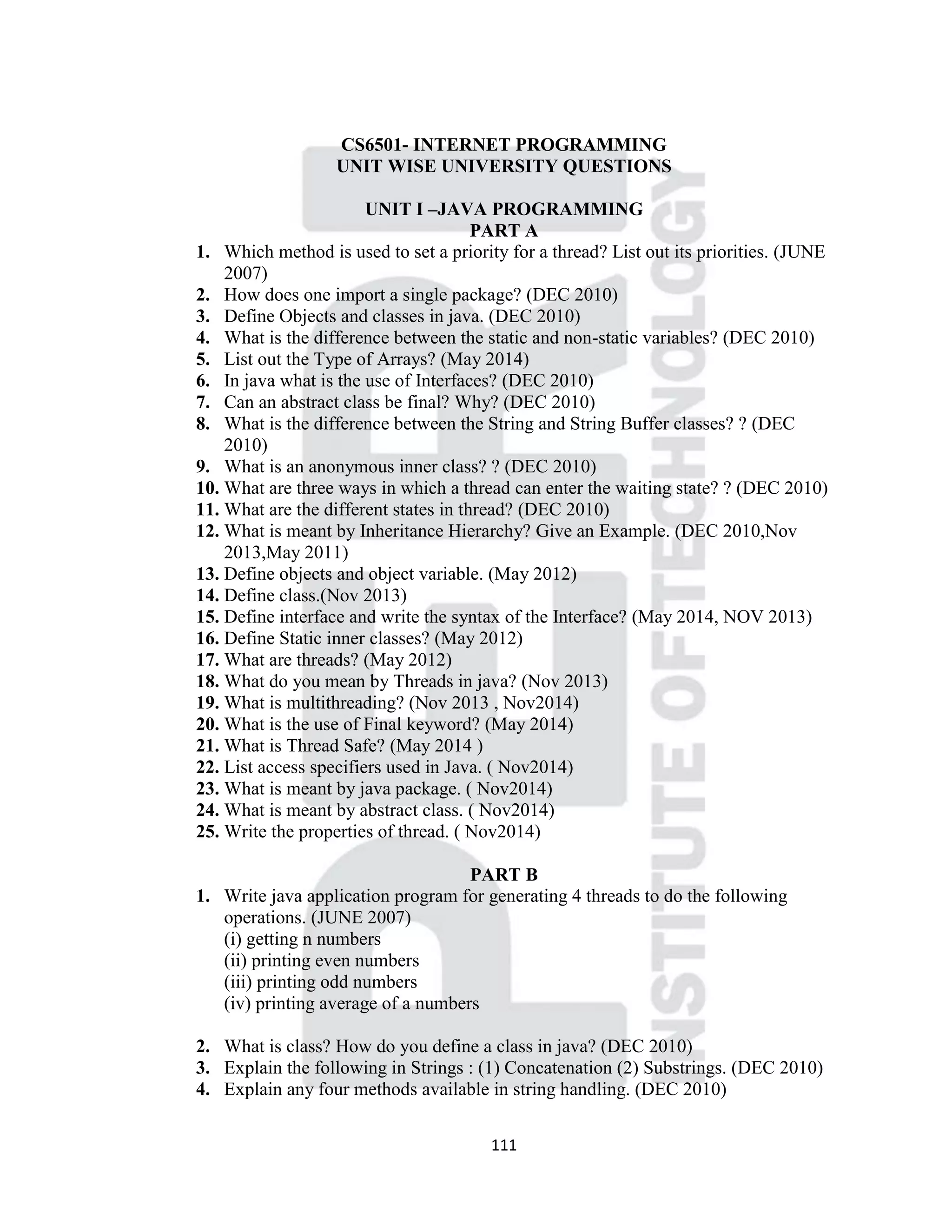

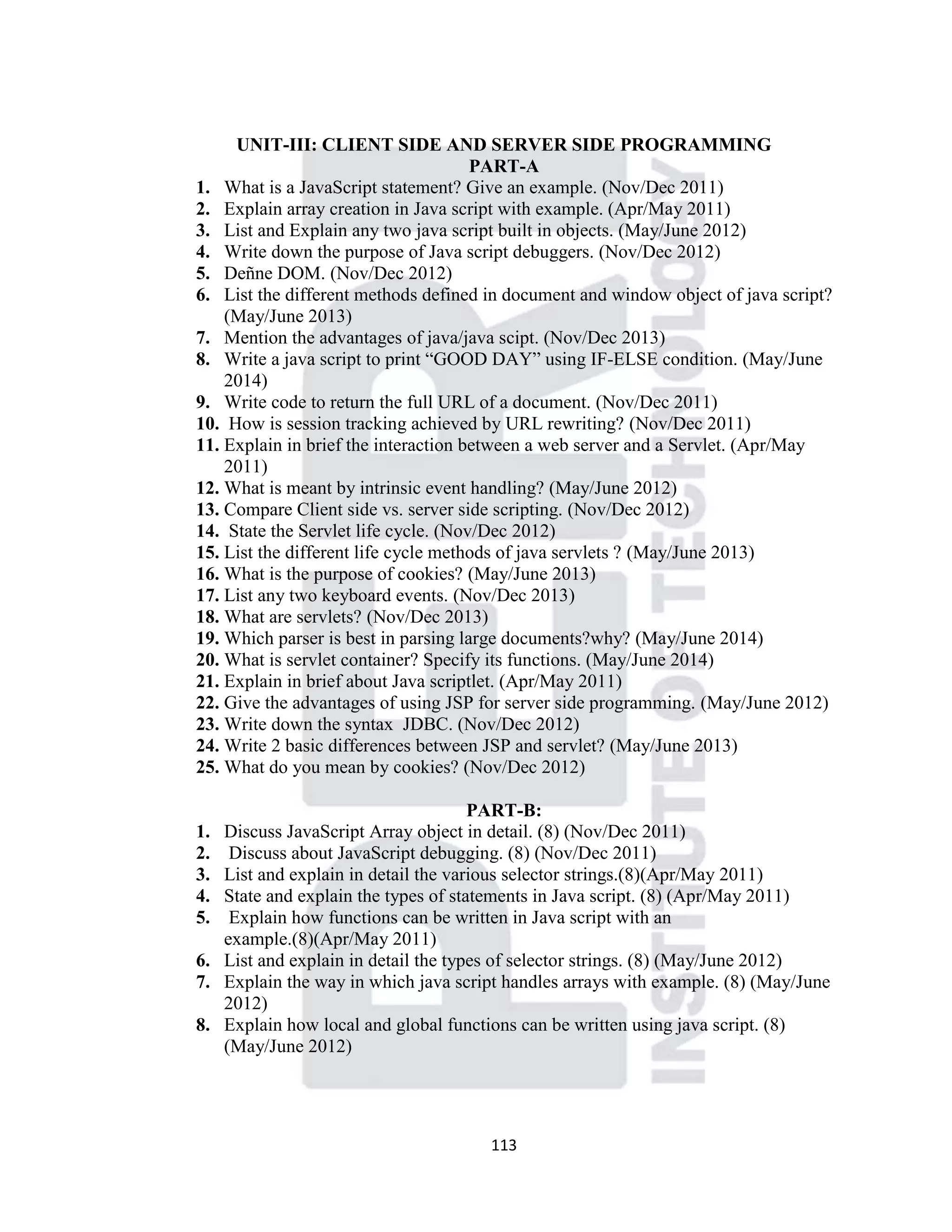
![114 9. Using RegExp instance,wríte a Java Script function isValid( ) that accepts a string argument and returns true if the argument matches one of the following phone- number formats and returns false otherwise: (16) (Nov/Dec 2012) (044) 234-56'î8 (044) 234-5678 044/234-5678 044 234 0442345678. 10. Discuss about the nodes in a document tree with an example. (16)(Nov/Dec 2012) 11. Write java script to find factorial of a given number? (8) (May/June 2013) 12. Write Java script to find sum offirst N even number and display the result . Get the value of n from user? (8) (May/June 2013) 13. Develop a simple online shopping using java script.(Nov/Dec 2013) 14. Write a java script program to develop a arithmetic calculator. (Nov/Dec 2013) 15. Discuss the data types, functions and objects used in java script with an example. (May/June 2014) 16. Explain in detail DOM event handling. Also explain with an example of creating a context menu. [Note: A context menu is one that that is shown when the user right-clicks anywhere in the document]. (16) (Nov/Dec 2011) 3 17. What is a session? Explain how client state is maintained using session and also explain about session tracking and session management using an example. (16) (Nov/Dec 2011) 3 18. Explain about the document tree in detail. (8) (Apr/May 2011) 3 19. Explain DOM event handling in detail. (8) (Apr/May 2011) 3 20. 3. Explain the Servlet operation in detail with a sample Servlet program.(16) (Apr/May 2011) 3 21. Explain the document tree in detail.(8) (May/June 2012) 3 22. Explain DOM event handling in detail. (8) (May/June 2012) 3 23. Explain in detail with an example the dynamic content generation by a servlet. (8) (May/June 2012) 24. Explain how java servlets perform session handling.(8) (May/June 2012) 25. Write a servlet program for Blogging appîicatíon, One servlet for login, second one for Prevíewíng fadding entry to the blog, third one for viewing the blog that generates HTML document. (16) (Nov/Dec 2012) 26. Write an ASP code to display different image each time a user visite a page. (8) (Nov/Dec 2012) 27. Write a JSP to demonstrate the usage of page and include directives. (8) (Nov/Dec 2012) 28. Write a servlet to illustrate the principles of cookies and explain? (16) (May/June 2013) 29. Explain about architecture of servlet? (6) (May/June 2013) 30. Explain the purpose of the following DOM methods and properties? (10) (May/June 2013) i ) getElementById ii)createElement](https://image.slidesharecdn.com/internetprogramming-cs6501-iiiyearcseanswerkey-161020051409/75/CS6501-Internet-programming-114-2048.jpg)
